- GM Dashboard
- Financials
- Filings
-
Holdings
- Transcripts
- ETFs
- Insider
- Institutional
- Shorts
-
DEF 14A Filing
General Motors (GM) DEF 14ADefinitive proxy
Filed: 30 Apr 21, 11:59am
UNITED STATES
SECURITIES AND EXCHANGE COMMISSION
Washington, D.C. 20549
SCHEDULE 14A
Proxy Statement Pursuant to Section 14(a) of the Securities
Exchange Act of 1934
☑ Filed by the Registrant ☐ Filed by a Party other than the Registrant
Check the appropriate box: | ||
☐ | Preliminary Proxy Statement | |
☐ | CONFIDENTIAL, FOR USE OF THE COMMISSION ONLY (AS PERMITTED BY RULE 14a-6(e)(2)) | |
☑ | Definitive Proxy Statement | |
☐ | Definitive Additional Materials | |
☐ | Soliciting Material under ss.240.14a-12 | |
GENERAL MOTORS COMPANY
300 Renaissance Center, Detroit, Michigan 48265
(Name of Registrant as Specified In Its Charter)
(Name of Person(s) Filing Proxy Statement, if other than the Registrant)
Payment of Filing Fee (Check the appropriate box): | ||
☑ | No fee required. | |
☐ | Fee computed on table below per Exchange Act Rules 14a-6(i)(1) and 0-11. | |
(1) Title of each class of securities to which transaction applies:
(2) Aggregate number of securities to which transaction applies:
(3) Per unit price or other underlying value of transaction computed pursuant to Exchange Act Rule 0-11 (set forth the amount on which the filing fee is calculated and state how it was determined):
(4) Proposed maximum aggregate value of transaction:
(5) Total fee paid:
| ||
☐ | Fee paid previously with preliminary materials. | |
☐ |
Check box if any part of the fee is offset as provided by Exchange Act Rule 0-11(a)(2) and identify the filing for which the offsetting fee was paid previously. Identify the previous filing by registration statement number, or the Form or Schedule and the date of its filing.
| |
(1) Amount Previously Paid:
(2) Form, Schedule or Registration Statement No.:
(3) Filing Party:
(4) Date Filed:
| ||


Notice of 2021 Annual Meeting of Shareholders
April 30, 2021
Dear Fellow Shareholders:
The Board of Directors of General Motors Company cordially invites you to attend the 2021 Annual Meeting of Shareholders.
At the Annual Meeting, you will be asked to:
| • | Elect the 12 Board-recommended director nominees named in this Proxy Statement; |
| • | Approve, on an advisory basis, Named Executive Officer compensation; |
| • | Ratify the selection of Ernst & Young LLP as the Company’s independent registered public accounting firm for 2021; |
| • | Vote on Rule 14a-8 shareholder proposals, if properly presented at the meeting; and |
| • | Transact any other business that is properly presented at the meeting. |
Record Date: April 15, 2021.
A list of registered shareholders will be available for examination for any purpose that is germane to the meeting for 10 business days before the Annual Meeting. Shareholders may request to review the list by emailing shareholder.relations@gm.com.
This Proxy Statement is provided in conjunction with GM’s solicitation of proxies to be used at the Annual Meeting. Thank you for your interest in General Motors Company.
For additional information about how to attend our Annual Meeting, see “General Information About the Annual Meeting” on page 92 of this Proxy Statement.
By Order of the Board of Directors,
Ann Cathcart Chaplin
Corporate Secretary
300 Renaissance Center
Detroit, Michigan 48265
|
Meeting Information:
| |||||
Date: June 14, 2021
Time: 1:00 p.m. Eastern
Place: Online via live webcast at virtualshareholdermeeting.com/GM2021
|
| |||||
Your Vote Is Important
| ||||||
Please promptly submit your vote by Internet, by telephone, or by signing, dating, and returning the enclosed proxy card or voting instruction form in the postage-paid envelope provided so that your shares will be represented and voted at the meeting.
We are first mailing these proxy materials to our shareholders on or about April 30, 2021.
| ||||||
How to Access the Proxy Materials Online:
| ||||||
Important Notice Regarding the Availability of Proxy Materials for the 2021 Annual Meeting of Shareholders to Be Held on June 14, 2021:
Our Proxy Statement and 2020 Annual Report are available at investor.gm.com/shareholder. You may also scan the QR code above with your smartphone or other mobile device to view our Proxy Statement and Annual Report.
|
 | i |
| A Message From Our Chairman and CEO |
|
April 30, 2021
Dear Fellow Shareholders: |
At General Motors and around the world, 2020 was defined by responding to the once-in-a-century challenges presented by the COVID-19 pandemic. Over the course of the year, the Board worked closely with GM’s Senior Leadership Team to ensure that the Company prioritized the health and safety of its employees and customers and acted with speed and agility to serve its communities and protect its business. We are proud of the thousands of GM employees who raised their hands to produce critical-care ventilators or to make and donate personal protective equipment for frontline healthcare workers and schools. With the same speed and sense of urgency, which we now call “ventilator speed,” we protected our liquidity and developed rigorous protocols to safely restart operations at the appropriate time. These actions enabled GM to deliver strong results in the second half of 2020 while advancing our electric vehicle (“EV”) goals and growth strategy.
Accelerating Our All-Electric Future
Last year, we made a strategic decision to accelerate our all-electric future by announcing our commitment to invest more than $27 billion through 2025 on electric and self-driving vehicles. These investments will allow GM to offer 30 EVs globally by 2025 — and 40% of U.S. entries will be battery electric vehicles by that time. The Board has worked for years to shape a long-term strategy to decarbonize our portfolio and replace GM’s gas-powered light-duty vehicles with EVs. Our focus has always been to align GM’s long-term vision with the interests of our shareholders, and our recent investments have brought us to an inflection point in our long-term sustainability plan. As a result, earlier this year, we announced the following:
| • | We will be carbon neutral in our global products and operations by 2040, 10 years ahead of the goals set forth in the Paris Agreement on climate change. |
| • | We signed the Business Ambition for 1.5° C commitment and set science-based targets that align with the Paris Agreement. |
| • | We aspire to eliminate tailpipe emissions from new light-duty vehicles globally by 2035. |
| • | We will source 100% renewable energy to power our U.S. facilities by 2030 and our global facilities by 2035, five years earlier than our previously announced goal. |
To meet these commitments, we will offer EVs across all of our brands that will span the global EV market, from the low-cost Wuling Hong Guang Mini to the hand-crafted Cadillac CELESTIQ flagship sedan. In 2020, Ultium Cells LLC, our joint venture with LG Energy Solution, broke ground on a nearly 3 million-square-foot plant in Lordstown, Ohio, which we expect will produce millions of battery cells every year – and we recently announced plans to build a second battery cell manufacturing plant in Spring Hill, Tennessee. In February 2021, we unveiled the Chevrolet Bolt EUV; and later this year, the Ultium-powered GMC HUMMER EV will launch from our transformed Factory ZERO plant in Detroit-Hamtramck, Michigan. Next year, we will launch the Cadillac LYRIQ, and we will have several high-volume entries in North America by 2023. You can learn more about our climate and sustainability goals on page 35 of this Proxy Statement.
Committed to Driving Diversity, Equity, and Inclusion in Our Workforce
The Board also recognizes that how we achieve our all-electric future matters. At GM, we intend for our transformation to be inclusive and consistent with our longstanding leadership in fostering diversity and inclusion. The events of 2020 underscored the economic and racial inequalities that persist in the United States and around the world. Following the killings of unarmed black citizens, including George Floyd, Jr., Breonna Taylor, Ahmaud Arbery, Rayshard Brooks, and more, shock and protests reverberated throughout the country and around the world. GM challenged its employees to stop asking “why” and start asking “what are we going to do?” GM has doubled down on its commitment to create and maintain a workplace that is inclusive for employees. We named Telva McGruder our Chief of Diversity, Equity, and Inclusion. We also created an Inclusion Advisory Board, which consists of internal and external leaders, that is committed to making sure GM’s words are supported by action. Our Senior Leadership Team has also worked to enhance GM’s diversity accountability reporting at Board and senior leader meetings using two key metrics: diversity in
| ii |
|
the overall GM population and diversity in hiring. We are also focused on promotions, performance ratings, interview slates, and attrition, among other things. In 2020, we also introduced a new employee behavior: Be Inclusive. You can learn more about our work to develop and execute strategies to build a high-performing, inclusive culture on pages 33 to 34 of this Proxy Statement.
Continued Evolution of Our Board
This year is a tipping point for EVs and an inflection point on sustainability, inclusion, and growth. In response, the Board has continued to evolve its membership to ensure it has the right mix of skills and diverse perspectives to continue to be a strategic asset for the Company. In March 2021, the Board added two new directors: Margaret (“Meg”) C. Whitman and Mark A. Tatum. Meg brings significant technology expertise to the Board, along with decades of experience leading large, complex companies, including Hewlett Packard Enterprise and eBay, Inc. Mark is responsible for the National Basketball Association’s global business operations and oversees its global partnerships, marketing, communications, and team marketing and business operations. We believe their unique experiences will bolster our Board’s already strong skillset, especially in technology, brand building, and customer experience, that will help us drive value for shareholders now and into the future.
As we welcome Meg and Mark, the Board’s leadership is also evolving. Theodore M. Solso (“Tim”) will not stand for re-election this year after ten years of distinguished service on the Board. The evolution of our Company in recent years would not have been possible without Tim, who helped lead the successful implementation of a number of key strategic priorities in our Company’s transformation, including exiting and restructuring unprofitable markets, reimagining the future of transportation, and accelerating our EV goals. On behalf of the entire Board, I sincerely thank Tim for his invaluable service and many contributions. I am confident our Board will continue to evolve under the leadership of Patricia Russo, who will succeed Tim in that important role upon his retirement. For more information on the role of the Independent Lead Director, please see page 16 of this Proxy Statement.
We appreciate your continued commitment to investing in GM, and we look forward to your attendance at our 2021 Annual Meeting of Shareholders on June 14 at 1:00 p.m. Eastern Time.
Sincerely,

Mary T. Barra
Chairman and Chief Executive Officer
 | iii |
Helpful Resources
Annual Meeting: investor.gm.com/shareholder |
Proxy Statement |
Annual Report |
| Governance Documents: investor.gm.com/resources |
Board Committee Charters |
Bylaws and Certificate of Incorporation |
Corporate Governance Guidelines |
Key Compliance Policies: investor.gm.com/resources |
Winning with Integrity: Our Values and Guidelines |
Policy on Recoupment of Incentive Compensation |
Related Party Transactions Policy |
Insider Trading Policy |
ESG Policies: investor.gm.com/resources |
Voluntary Report of 2020 Political Contributions |
Company Policy on Corporate Political Contributions |
Conflict Minerals Policy |
Environmental Policy |
Global Human Rights Policy |
Global Integrity Policy |
Supplier Code of Conduct |
Sustainability Report: gmsustainability.com |
Investors Relations: investor.gm.com/investor-relations |
| Defined Terms and Commonly Used Acronyms | ||
Annual Meeting | GM’s Annual Meeting of Shareholders to be held on June 14, 2021 | |
AV | Autonomous Vehicle | |
Board | General Motors Company’s Board of Directors | |
CEO | Chief Executive Officer | |
CFO | Chief Financial Officer | |
Code of Conduct | Winning with Integrity: Our Values and Guidelines for Employee Conduct | |
Committees | Audit Committee Executive Committee Executive Compensation Committee Governance and Corporate Responsibility Committee Finance Committee Risk and Cybersecurity Committee | |
DSU | Deferred Share Unit | |
ESG | Environmental, Social, and Governance | |
EV | Electric Vehicle | |
EY | Ernst & Young LLP | |
GM or the Company | General Motors Company | |
Governance Committee | Governance and Corporate Responsibility Committee | |
LTIP | Long-Term Incentive Plan | |
NEO | Named Executive Officer | |
NYSE | New York Stock Exchange | |
SEC | U.S. Securities and Exchange Commission | |
Senior Leadership Team | Certain members of management who report directly to the CEO or the President | |
STIP | Short-Term Incentive Plan | |
Cautionary Note on Forward-Looking Statements: This Proxy Statement contains “forward-looking” statements regarding GM’s current expectations within the meaning of the applicable securities laws and regulations. These statements are subject to a variety of risks and uncertainties that could cause actual results to differ materially from expectations. These risks and uncertainties include, but are not limited to, the risks detailed in GM’s filings with the Securities and Exchange Commission, including the “Risk Factors” section of GM’s Annual Report on Form 10-K for the fiscal year ended December 31, 2020 (“2020 Form 10-K”). We assume no obligation to update any of these forward-looking statements.
| iv |
|
| 1 | ||||
| 2 | ||||
| 2 | ||||
| 4 | ||||
| 5 | ||||
| 11 | ||||
| 15 | ||||
| 15 | ||||
| 16 | ||||
| 18 | ||||
| 22 | ||||
| 25 | ||||
| 27 | ||||
| 29 | ||||
| 30 | ||||
| 31 | ||||
| 32 | ||||
| 33 | ||||
| 36 | ||||
| 38 | ||||
| 41 | ||||
| 42 | ||||
| 49 | ||||
| 49 | ||||
| 51 | ||||
| 54 | ||||
| 65 | ||||
| 68 | ||||
| 69 | ||||
| 83 | ||||
| 84 | ||||
| 85 | ||||
Item No. 2 – Advisory Approval of Named Executive Officer Compensation | 86 | |||
| 87 | ||||
| 88 | ||||
| 90 | ||||
| 92 | ||||
| A-1 | ||||
INDEX OF FREQUENTLY
ACCESSED INFORMATION
Auditor Fees | 40 | |||
Beneficial Ownership Table | 36 | |||
Board and Committee Evaluations | 26 | |||
Board Succession Planning | 17 | |||
CEO Pay Ratio | 83 | |||
CEO Succession Planning | 26 | |||
Clawback Policies | 66 | |||
Code of Business Conduct and Ethics | 25 | |||
Compensation Decisions for our NEOs | 54 | |||
Compensation Peer Group | 47 | |||
Corporate Governance Guidelines | 26 | |||
Cybersecurity and Privacy Risk Oversight | 24 | |||
Director Biographies | 5 | |||
Director Compensation | 11 | |||
Director Independence | 15 | |||
Director Skills Matrix | 4 | |||
Diversity, Equity, and Inclusion | 33 | |||
Executive Perquisites | 49 | |||
Financial Performance | 42 | |||
Human Capital Management | 33 | |||
Independent Lead Director Duties | 16 | |||
Lobbying Disclosure | 29 | |||
Pay-for-Performance | 54 | |||
Related Party Transactions | 31 | |||
Risk Oversight | 22 | |||
Shareholder Engagement | 27, 44 | |||
Stock Ownership Requirements | 11, 65 |
 | v |
[THIS PAGE INTENTIONALLY LEFT BLANK]
Shareholders will be asked to vote on the following matters at the Annual Meeting of Shareholders:
VOTING MATTER | BOARD VOTE RECOMMENDATION | PAGE REFERENCE | ||
Item 1: Election of Directors | FOR each director nominee | 85 | ||
Item 2: Advisory Approval of Named Executive Officer Compensation |
FOR |
86 | ||
Item 3: Ratification of the Selection of the Independent Registered Public Accounting Firm for 2021 |
FOR |
87 | ||
Item 4: Shareholder Proposal Regarding Shareholder Written Consent |
AGAINST |
88 | ||
Item 5: Shareholder Proposal Regarding a Report on Greenhouse Gas Emissions Targets as a Performance Element of Executive Compensation |
AGAINST |
90 | ||
 | 1 |
Snapshot of Our Board Nominees
Name & Principal Occupation |
Age | Director Since |
Independent | Committee Memberships | ||||||
| Mary T. Barra Chairman & Chief Executive Officer General Motors Company | 59 | 2014 | Executive – Chair | ||||||
| Wesley G. Bush Retired Chairman & Chief Executive Officer Northrop Grumman Corporation | 60 | 2019 |  | Audit Executive Compensation Finance | |||||
| Linda R. Gooden Retired Executive Vice President, Information Systems & Global Solutions Lockheed Martin Corporation | 68 | 2015 |  | Audit Executive Risk and Cybersecurity – Chair | |||||
| Joseph Jimenez Retired Chief Executive Officer Novartis AG | 61 | 2015 |  | Executive Executive Compensation Finance – Chair Risk and Cybersecurity | |||||
| Jane L. Mendillo Retired President & Chief Executive Officer Harvard Management Company | 62 | 2016 |  | Audit Finance Governance | |||||
| Judith A. Miscik Chief Executive Officer & Vice Chairman Kissinger Associates, Inc. | 62 | 2018 |  | Finance Risk and Cybersecurity | |||||
| Patricia F. Russo Chairman Hewlett Packard Enterprise Company | 68 | 2009 |  | Executive Executive Compensation Finance Governance – Chair | |||||
| Thomas M. Schoewe Retired Executive Vice President & Chief Financial Officer Wal-Mart Stores, Inc. | 68 | 2011 |  | Audit – Chair Executive Finance Risk and Cybersecurity | |||||
| Carol M. Stephenson Retired Dean Ivey Business School, The University of Western Ontario | 70 | 2009 |  | Executive Executive Compensation – Chair Governance | |||||
| Mark A. Tatum Deputy Chief Commissioner & | 51 | 2021 |  | None | |||||
| Devin N. Wenig Retired President & Chief Executive Officer eBay Inc. | 54 | 2018 |  | Risk and Cybersecurity | |||||
| Margaret C. Whitman Retired President & Chief Executive Officer | 64 | 2021 |  | None | |||||
| 2 |
|

2021 Board Nominee Statistics
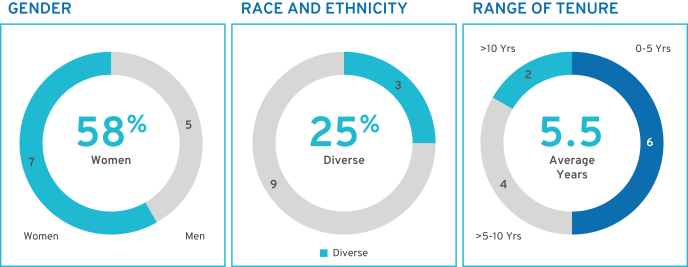
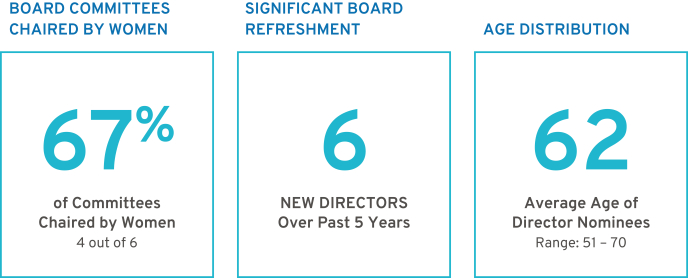
 | 3 |
Skills, Qualifications, and Experience
Your Board nominees offer a diverse range of skills and experience in relevant areas.
Director | Senior Leadership | Industry | Manufacturing | Technology | Risk Management | Global | Finance | Government | Marketing | Diversity | Cyber | |||||||||||
M. Barra | 🌑 | 🌑 | 🌑 | 🌑 | 🌑 | 🌑 | 🌑 |
|
| 🌑 |
| |||||||||||
W. Bush | 🌑 |
| 🌑 | 🌑 | 🌑 | 🌑 | 🌑 | 🌑 |
|
| 🌑 | |||||||||||
L. Gooden | 🌑 |
| 🌑 | 🌑 | 🌑 | 🌑 | 🌑 | 🌑 |
| 🌑 | 🌑 | |||||||||||
J. Jimenez | 🌑 |
| 🌑 |
| 🌑 | 🌑 | 🌑 |
| 🌑 | 🌑 |
| |||||||||||
J. Mendillo | 🌑 |
|
|
| 🌑 | 🌑 | 🌑 |
|
| 🌑 |
| |||||||||||
J. Miscik | 🌑 |
|
|
| 🌑 | 🌑 | 🌑 | 🌑 |
| 🌑 |
| |||||||||||
P. Russo | �� |
| 🌑 | 🌑 | 🌑 | 🌑 | 🌑 |
| 🌑 | 🌑 |
| |||||||||||
T. Schoewe | 🌑 |
| 🌑 | 🌑 | 🌑 | 🌑 | 🌑 |
| 🌑 |
| 🌑 | |||||||||||
C. Stephenson | 🌑 |
|
| 🌑 | 🌑 | 🌑 | 🌑 | 🌑 | 🌑 | 🌑 |
| |||||||||||
M. Tatum | 🌑 |
|
|
| 🌑 | 🌑 |
|
| 🌑 | 🌑 |
| |||||||||||
D. Wenig | 🌑 |
|
| 🌑 | 🌑 | 🌑 | 🌑 |
| 🌑 |
|
| |||||||||||
M. Whitman | 🌑 |
| 🌑 | 🌑 | 🌑 | 🌑 | 🌑 | 🌑 | 🌑 | 🌑 | 🌑 | |||||||||||
Further information on each nominee’s qualifications and relevant experience is provided on the following pages. We believe each of your Board’s nominees is highly qualified with unique experiences that are particularly beneficial to GM.
| 4 |
|
Set forth below is a short biography of each director nominee.
 |  | |||
| Mary T. Barra, Age 59 | Wesley G. Bush, Age 60 | |||
Chairman & Chief Executive Officer, General Motors Company |
Retired Chairman & Chief Executive Officer, Northrop Grumman Corporation | |||
Committees: Executive (Chair)
Current Public Company Directorships: The Walt Disney Company
Prior Public Company Directorships: General Dynamics Corporation (2011 to 2017)
Prior Experience: Ms. Barra has served as Chairman of GM’s Board of Directors since January 2016 and CEO of GM since January 2014. Prior to that time, she served as Executive Vice President, Global Product Development, Purchasing and Supply Chain from 2013 to 2014; Senior Vice President, Global Product Development from 2011 to 2013; Vice President, Global Human Resources from 2009 to 2011; and Vice President, Global Manufacturing Engineering from 2008 to 2009. Ms. Barra began her career at GM in 1980.
Reasons for Nomination: Ms. Barra has in-depth knowledge of the Company and the global automotive industry; extensive senior leadership, strategic planning, operational, and business experience; and a strong engineering background with experience in global product development. |
Committees: Audit, Executive Compensation, Finance
Current Public Company Directorships: Dow Inc. and Cisco Systems Inc.
Prior Public Company Directorships: Norfolk Southern Corporation and Northrop Grumman Corporation (“Northrop Grumman”)
Prior Experience: Mr. Bush served as Chairman of the Board of Directors of Northrop Grumman from 2011 to 2019. He also served as the CEO of Northrop Grumman from 2010 to 2018. Prior to that, Mr. Bush served in numerous leadership roles at Northrop Grumman, including President and Chief Operating Officer, Chief Financial Officer, and President of the company’s Space Technology sector. He also served in a variety of leadership positions at TRW, Inc., before it was acquired by Northrop Grumman in 2002.
Reasons for Nomination: Mr. Bush has valuable experience in a manufacturing enterprise known for its advanced engineering and technology; strong financial acumen; and knowledge of key governance issues, including risk management. | |||
 | 5 |
 |  | |||
| Linda R. Gooden, Age 68 |
| Joseph Jimenez, Age 61 | ||
Retired Executive Vice President, |
Retired Chief Executive Officer, | |||
Committees: Audit, Executive, Risk and Cybersecurity (Chair)
Current Public Company Directorships: The Home Depot, Inc.
Prior Public Company Directorships: WGL Holdings, Inc., and Washington Gas & Light Company, a subsidiary of WGL Holdings, Inc.
Prior Experience: Ms. Gooden served as Executive Vice President, Information Systems and Global Solutions of Lockheed Martin Corporation (“Lockheed Martin”) from 2007 to 2013. She also served as Lockheed Martin’s Deputy Executive Vice President, Information and Technology Services from October to December 2006, and as its President, Information Technology from 1997 to December 2006.
Reasons for Nomination: Ms. Gooden has extensive expertise in cybersecurity and information technology, operational and strategic planning, and government relations. |
Committees: Executive, Executive Compensation, Finance (Chair), Risk and Cybersecurity
Current Public Company Directorships: The Procter & Gamble Co.
Prior Public Company Directorships: Colgate-Palmolive Company (2010 to 2015)
Prior Experience: Mr. Jimenez served as CEO of Novartis AG (“Novartis”) from 2010 until his retirement in 2018. He led Novartis’ Pharmaceuticals Division from October 2007 to 2010 and its Consumer Health Division in 2007. From 2006 to 2007, Mr. Jimenez served as Advisor to the Blackstone Group L.P. He was Executive Vice President, President, and CEO of Heinz Europe from 2002 to 2006; and President and CEO of H.J. Heinz Company North America from 1999 to 2002.
Reasons for Nomination: Mr. Jimenez has extensive senior leadership experience in the consumer products industry, international operations, strategic planning, and finance. | |||
| 6 |
|
 |  | |||
| Jane L. Mendillo, Age 62 | Judith A. Miscik, Age 62 | |||
| Retired President & Chief Executive Officer, Harvard Management Company |
| Chief Executive Officer & Vice Chairman, Kissinger Associates, Inc. | ||
Committees: Audit, Finance, Governance
Current Public Company Directorships: Lazard Ltd.
Prior Public Company Directorships: None
Prior Experience: Ms. Mendillo was President and CEO of the Harvard Management Company (“HMC”) from 2008 to 2014. From 2002 to 2008, she was Chief Investment Officer of Wellesley College. Before that, she spent 15 years at HMC in a wide range of investment management positions, including investments in public and private markets, both domestic and international. She previously chaired the Partners Healthcare System’s investment committee, served as a member of Yale University’s and the Rockefeller Foundation’s investment committees and as a director and investment committee member of the Mellon Foundation and the Boston Foundation. She is currently an advisor and trustee of the Old Mountain Private Trust Company.
Reasons for Nomination: Ms. Mendillo has experience in risk and crisis management, as well as valuable insight into GM’s capital allocation framework, financial policies, and business strategies. |
Committees: Finance, Risk and Cybersecurity
Current Public Company Directorships: Morgan Stanley and HP, Inc.
Prior Public Company Directorships: EMC Corporation (2012 to 2016) and Pivotal Software, Inc. (2014 to 2016)
Prior Experience: In 2017, Ms. Miscik was appointed as CEO and Vice Chairman of Kissinger Associates, Inc. (“Kissinger Associates”). Prior to that time, she served as Co-Chief Executive Officer and Vice Chairman of Kissinger Associates from 2015 to 2017 and as President and Vice Chairman of Kissinger Associates from 2009 to 2015. Prior to joining Kissinger Associates, Ms. Miscik was the Global Head of Sovereign Risk at Lehman Brothers from 2005 to 2008; and from 2002 to 2005, she served as Deputy Director for Intelligence at the U.S. Central Intelligence Agency, where she worked from 1983 to 2005.
Reasons for Nomination: Ms. Miscik has a unique and extensive background in intelligence, security, and risk analysis, bringing valuable experience in assessing and mitigating geopolitical and macroeconomic risks in both the public and the private sectors. | |||
 | 7 |
 |  | |||
| Patricia F. Russo, Age 68 | Thomas M. Schoewe, Age 68 | |||
Chairman, |
|
Retired Executive Vice President & | ||
Committees: Executive, Executive Compensation, Finance, Governance (Chair)
Current Public Company Directorships: Hewlett Packard Enterprise Company (Chairman), KKR Management LLC, and Merck & Co. Inc.
Prior Public Company Directorships: Hewlett-Packard Company (2011 to 2015) (Lead Director 2014 to 2015) and Alcoa, Inc. (2016)
Prior Experience: Ms. Russo served as Lead Director of the Hewlett-Packard Company Board of Directors from 2014 to 2015. She was Independent Lead Director of the GM Board of Directors from March 2010 to January 2014 and will be the Independent Lead Director again, following Mr. Solso’s retirement. She also served as CEO of Alcatel-Lucent S.A. from 2006 to 2008; Chairman and CEO of Lucent Technologies, Inc., (“Lucent”) from 2003 to 2006; and President and CEO of Lucent from 2002 to 2006.
Reasons for Nomination: Ms. Russo has extensive senior leadership experience in corporate strategy, finance, sales and marketing, technology, and leadership development, as well as experience managing business-critical technology disruptions. |
Committees: Audit (Chair), Executive, Finance, Risk and Cybersecurity
Current Public Company Directorships: KKR Management LLC and Northrop Grumman
Prior Public Company Directorship: PulteGroup, Inc. (2009 to 2012)
Prior Experience: Mr. Schoewe served as Executive Vice President and CFO of Wal-Mart Stores, Inc. (“Wal-Mart”) from 2000 to 2011. Prior to joining Wal-Mart, he held several roles at the Black & Decker Corporation (“Black & Decker”), including Senior Vice President and CFO from 1996 to 1999, Vice President and CFO from 1993 to 1999, Vice President of Finance from 1989 to 1993, and Vice President of Business Planning and Analysis from 1986 to 1989. Before joining Black & Decker, Mr. Schoewe worked for Beatrice Companies where he was CFO and Controller of one of its subsidiaries, Beatrice Consumer Durables Inc.
Reasons for Nomination: Mr. Schoewe has extensive financial experience acquired through positions held as the CFO of large public companies, as well as expertise in Sarbanes-Oxley controls, risk management, and mergers and acquisitions. He also gained significant international experience through his service as an executive of large public companies with substantial international operations and large-scale transformational enterprise information technology implementations. | |||
| 8 |
|
 |
| |||
| Carol M. Stephenson, O.C., Age 70 | Mark A. Tatum, Age 51 | |||
Retired Dean, |
Deputy Commissioner & Chief Operating Officer, National Basketball Association | |||
Committees: Executive, Executive Compensation (Chair), Governance
Current Public Company Directorships: Intact Financial Corporation (formerly ING Canada) and Maple Leaf Foods Inc.
Prior Public Company Directorships: Ballard Power Systems, Inc. (2012 to 2017) and Manitoba Telecom Services (2008 to 2016)
Prior Experience: Ms. Stephenson served as Dean of the Ivey Business School at the University of Western Ontario from 2003 until her retirement in 2013. Prior to joining the Ivey Business School, she was President and CEO of Lucent Technologies Canada from 1999 to 2003 and a member of the Advisory Board of General Motors of Canada, Limited, a GM subsidiary, from 2005 to 2009. Ms. Stephenson is an officer of the Order of Canada.
Reasons for Nomination: Ms. Stephenson has expertise in marketing, operations, strategic planning, technology development, financial management, executive compensation, and North American trade issues. |
|
Committees: None
Current Public Company Directorships: None
Prior Public Company Directorships: None
Prior Experience: Mr. Tatum joined the National Basketball Association (“NBA”) in 1999 and was appointed NBA Deputy Commissioner and Chief Operating Officer on February 1, 2014. Prior to that, he served in numerous leadership roles at the NBA, including Executive Vice President of Global Marketing Partnerships, Senior Vice President and Vice President of Business Development, Senior Director and Group Manager of Marketing Properties, and Director of Marketing Partnerships.
Reasons for Nomination: Mr. Tatum has extensive senior leadership experience in marketing and sales strategy, managing media relationships, and global business operations – with a particular expertise in China. | ||
 | 9 |
 |  | |||
| Devin N. Wenig, Age 54 | Margaret C. Whitman, Age 64 | |||
Retired President & Chief Executive Officer, |
Retired President & Chief Executive Officer, | |||
Committees: Risk and Cybersecurity
Current Public Company Directorships: None
Prior Public Company Directorships: eBay Inc. (“eBay”) (2015 to 2019)
Prior Experience: Mr. Wenig served as President and CEO of eBay and as a member of its Board of Directors from July 2015 to August 2019. Prior to that time, he served as President of eBay’s Marketplaces business from 2011 to July 2015. Prior to joining eBay, Mr. Wenig was CEO of Thomson Reuters Corporation’s largest division, Thomson Reuters Markets, from 2008 to 2011; Chief Operating Officer of Reuters Group plc (“Reuters”) from 2006 to 2008; and President of Reuters’ business divisions from 2003 to 2006.
Reasons for Nomination: Mr. Wenig has extensive senior leadership experience in technology, global operations, and strategic planning. |
Committees: None
Current Public Company Directorships: The Procter & Gamble Co.
Prior Public Company Directorships: Dropbox, Inc. (2017 to 2020), Hewlett Packard Enterprise (“HPE”) (2015 to 2018), and HP, Inc. (2015 to 2017)
Prior Experience: From April 2020 to October 2020, Ms. Whitman served as the CEO of Quibi. Prior to that, she served as President and CEO for HPE from 2015 to June 2017. From 2014 to 2015, Ms. Whitman served as President, Chief Executive Officer, and Chairman of Hewlett-Packard Company (now known as HP Inc.), the former parent of HPE, and as its President and CEO from 2011 to 2015. She also served as the President and CEO of eBay, Inc., from 1998 to 2008 and held numerous other leadership roles at Hasbro, Inc., Florists Transworld Delivery (FTD), Stride Rite, and the Walt Disney Co.
Reasons for Nomination: Ms. Whitman has extensive senior leadership experience in technology, global operations, and consumer-products. | |||
| 10 |
|
NON-EMPLOYEE DIRECTOR COMPENSATION
Our non-employee directors receive cash compensation as well as equity compensation in the form of GM Deferred Share Units (“DSUs”) for
their Board service. Compensation for our non-employee directors is set by the Board at the recommendation of the Governance Committee.
Guiding Principles
• Fairly compensate directors for their responsibilities and time commitments.
• Attract and retain highly qualified directors by offering a compensation program consistent with those at companies of similar size, scope, and complexity.
• Align the interests of directors with our shareholders by providing a significant portion of compensation in equity and requiring directors to continue to own our common stock (or common stock equivalents) until retirement.
• Provide compensation that is simple and transparent to shareholders.
|
| u | Annual Review Process |
The Governance Committee annually assesses the form and amount of non-employee director compensation and recommends changes, if appropriate, to the Board. As part of its annual review, the Governance Committee conducts extensive benchmarking by reviewing director compensation data for the executive compensation peer group described in “Executive Compensation—Compensation Overview—Peer Group for Compensation Comparisons” on page 47 of this Proxy Statement.
In March 2020, the Board and the Governance Committee, in response to the COVID-19 pandemic, approved a 20% temporary reduction in the board retainer, effective April 1, 2020, until the restoration of employee base salaries, which occurred on September 1, 2020. In December 2020, the Governance Committee conducted another review of GM’s director compensation and recommended the Board maintain the reinstated structure and level of compensation and stock ownership requirements for 2021, absent the temporary reductions. Director compensation is set forth on pages 13 to 14 of this Proxy Statement.
Director Stock Ownership and Holding Requirements
• Each non-employee director is required to own our common stock or DSUs with a market value of at least $500,000.
• Each director has up to five years from the date he or she is first elected to the Board to meet this ownership requirement.
• Non-employee directors are prohibited from selling any GM securities or derivatives of GM securities, such as DSUs, while they are members of the Board.
• Ownership guidelines are reviewed each year to confirm they continue to be effective in aligning the interests of the Board and our shareholders.
• All of our directors are in compliance with our stock retention requirements.
|
 | 11 |
Annual Compensation
The 2020 and 2021 compensation for non-employee directors are described in the table below. We do not pay any other retainers or meeting fees. The Independent Lead Director and Committee Chairs receive additional compensation due to the increased workload and additional responsibilities associated with these positions. In particular, Mr. Solso’s compensation as Independent Lead Director reflects the additional time commitment for
this role, which includes, among other responsibilities, attending all Board Committee meetings and attending additional meetings with the Company’s senior management, including the CEO. For additional information about the roles and responsibilities of our Independent Lead Director, see “Corporate Governance—The Role of the Independent Lead Director” on page 16 of this Proxy Statement.
| Compensation Element | 2020 Structure | 2020 COVID-19 Response | 2021 Structure | |||||||||
Board Retainer | $ | 305,000 | $ | 244,000 | $ | 305,000 | ||||||
Independent Lead Director Fee | $ | 100,000 | $ | 100,000 | $ | 100,000 | ||||||
Audit Committee Chair Fee | $ | 30,000 | $ | 30,000 | $ | 30,000 | ||||||
All Other Committee Chair Fees (excluding the Executive Committee) | $ | 20,000 | $ | 20,000 | $ | 20,000 | ||||||
Non-employee directors are required to defer at least 50% of their annual Board retainer into DSUs under the General Motors Company Deferred Compensation Plan for Non-Employee Directors (the “Director Compensation Plan”). Directors may elect to defer all or half of their remaining Board retainer or amounts payable (if
any) for serving as a Committee Chair or Independent Lead Director into additional DSUs. The fees for a director who joins or leaves the Board or assumes additional responsibilities during the year are prorated for his or her period of service.
How Deferred Share Units Work
Each DSU is equal in value to one share of GM common stock and is fully vested upon grant but does not have voting rights. DSUs will not be available for disposition until after the director leaves the Board. After leaving the Board, the director will receive a cash payment or payments based on the number of DSUs in the director’s account valued at the average daily closing market price for the quarter immediately
preceding payment. Directors will be paid in a lump sum or in annual installments for up to five years, based on their deferral elections. All DSUs granted are rounded up to the nearest whole unit. Any portion of the retainer that is deferred into DSUs may also earn dividend equivalents, which are credited at the end of each calendar year to each director’s account in the form of additional DSUs. DSUs granted are determined as follows:

| 12 |
|
Other Compensation
We provide certain additional benefits to non-employee directors.
| Type | Purpose | |
u Company Vehicles | We provide directors with the use of Company vehicles to provide feedback on our products as well as enhance the public image of our vehicles. Retired directors also receive the use of a Company vehicle for a period of time. Participants are charged with imputed income based on the lease value of the vehicles and are responsible for associated taxes. | |
u Personal Accident Insurance(1) | We provide personal accident insurance coverage in the event of accidental death or dismemberment. Directors are responsible for associated taxes on the imputed income from the coverage. | |
| (1) | Ms. Barra, our sole employee director, does not receive additional compensation for her Board service other than the personal accident insurance benefit described above, the value of which is reported for Ms. Barra in the Summary Compensation Table on page 69 of this Proxy Statement. |
Non-employee directors are not eligible to participate in any of the savings or retirement programs for our employees. Other than as described in this section, there are no separate benefit plans for directors.
2020 Non-Employee Director Compensation Table
This table shows the compensation that each non-employee director received for his or her 2020 Board and Committee service.
| Director | Fees Earned or Paid in Cash(1) ($) | Stock Awards(2) ($) | All Other Compensation(3) ($) | Total ($) | ||||||||||||||||
Wesley G. Bush | $ | 139,792 | $ | 191,003 | $ | 12,261 | $ | 343,056 | ||||||||||||
Linda R. Gooden | $ | 159,792 | $ | 191,003 | $ | 22,990 | $ | 373,785 | ||||||||||||
Joseph Jimenez | $ | 159,792 | $ | 191,003 | $ | 31,844 | $ | 382,639 | ||||||||||||
Jane L. Mendillo | $ | 139,792 | $ | 191,003 | $ | 11,490 | $ | 342,285 | ||||||||||||
Judith A. Miscik | $ | 139,792 | $ | 191,003 | $ | 30,865 | $ | 361,660 | ||||||||||||
Patricia F. Russo | $ | 159,792 | $ | 191,003 | $ | 25,073 | $ | 375,868 | ||||||||||||
Thomas M. Schoewe | $ | 169,792 | $ | 191,003 | $ | 43,657 | $ | 404,452 | ||||||||||||
Theodore M. Solso | $ | 239,792 | $ | 191,003 | $ | 36,573 | $ | 467,368 | ||||||||||||
Carol M. Stephenson | $ | 159,792 | $ | 191,003 | $ | 16,186 | $ | 363,798 | ||||||||||||
Devin N. Wenig | $ | 169,792 | $ | 191,003 | $ | 10,261 | $ | 371,056 | ||||||||||||
| (1) | As described above, a Director may elect to defer all or a portion of his or her annual cash retainer into a DSU. This column reflects director compensation eligible to be paid in cash, which consists of 50% of the annual Board retainer and any applicable fees for Committee Chairs, the Independent Lead Director, and in the case of Mr. Wenig, for service on the Cruise LLC Board of Directors. As described above, due to the COVID-19 pandemic, the Board retainer was reduced for a portion of 2020. Each of the following directors elected to receive DSUs in lieu of such amounts eligible to be paid in cash in the following amounts: Mr. Bush — $139,792; Mr. Jimenez — $159,792; Ms. Mendillo — $139,792; Ms. Russo — $89,896; Mr. Solso — $239,792; Ms. Stephenson — $79,896; and Mr. Wenig — $169,792. |
 | 13 |
| (2) | Reflects aggregate grant date fair value of DSUs granted in 2020, which does not include any cash fees that directors voluntarily elected to receive as DSUs. Grant date fair value is calculated by multiplying the number of DSUs granted by the closing price of GM common stock on December 31, 2020, which was $41.64. The holders of DSUs also receive dividend equivalents, which are reinvested in additional DSUs based on the market price of the common stock on the date the dividends are paid. |
| (3) | The following table provides more information on the type and amount of benefits included in the All Other Compensation column. |
| Director | Company Vehicle Program (a) | Other (b) | Total | Director | Company Vehicle Program (a) | Other (b) | Total | |||||||||||||||||||||||
Mr. Bush | $ | 12,021 | $ | 240 | $ | 12,261 | Ms. Russo | $ | 24,833 | $ | 240 | $ | 25,073 | |||||||||||||||||
Ms. Gooden | $ | 22,750 | $ | 240 | $ | 22,990 | Mr. Schoewe | $ | 43,417 | $ | 240 | $ | 43,657 | |||||||||||||||||
Mr. Jimenez | $ | 31,604 | $ | 240 | $ | 31,844 | Mr. Solso | $ | 36,333 | $ | 240 | $ | 36,573 | |||||||||||||||||
Ms. Mendillo | $ | 11,250 | $ | 240 | $ | 11,490 | Ms. Stephenson | $ | 12,763 | $ | 240 | $ | 13,003 | |||||||||||||||||
Ms. Miscik | $ | 30,625 | $ | 240 | $ | 30,865 | Mr. Wenig | $ | 10,021 | $ | 240 | $ | 10,261 | |||||||||||||||||
| (a) | The Company vehicle program includes the estimated annual lease value of the Company vehicles driven by directors. We include the annual lease value because it is more reflective of the value of the Company vehicle perquisite than the Company’s incremental costs, which are generally significantly lower because the Company manufactures and ordinarily disposes of Company vehicles for a profit, resulting in minimal incremental costs, if any. Taxes related to imputed income are the responsibility of each director. |
| (b) | Reflects the cost of premiums for providing personal accident insurance (annual premium cost of $240 is prorated, as applicable, for the period of service). |
| 14 |
|
GM is governed by a Board of Directors and Committees of the Board that meet throughout the year. The Board is elected by shareholders to oversee and provide guidance on the Company’s business and affairs. It is the ultimate decision-making body of the Company except for those matters reserved for shareholders by law or pursuant to the Company’s governance instruments. Among other things, the Board oversees Company strategy and execution of the strategic plan. In addition, it oversees
management’s proper safeguarding of the assets of the Company, maintenance of appropriate financial and other internal controls, compliance with applicable laws and regulations, and proper governance. The Board is committed to sound corporate governance policies and practices that are designed and routinely assessed to enable the Company to operate its business responsibly, with integrity, and to position GM to compete more effectively, sustain its success, and build long-term shareholder value.
| u | Board Size |
The Board sets the number of directors from time to time by a resolution adopted by a majority of the Board. The Governance Committee reassesses the suitability of the Board’s size at least annually. The Board has the flexibility to increase or decrease the size of the Board as circumstances warrant, although the Company’s Certificate of Incorporation limits the total number of directors to 17. There are currently 13 members of the
Board. If all of the Board’s nominees are elected, the Board will be composed of 12 members immediately following the Annual Meeting because Mr. Solso will not stand for re-election. If any nominee is unable to serve as a director or if any director leaves the Board between annual meetings, the Board, by resolution, may reduce the number of directors or elect an individual to fill the resulting vacancy.
| u | Director Independence |
GM’s Bylaws and Corporate Governance Guidelines define our standards for director independence and reflect applicable NYSE and SEC requirements. At least two-thirds of our directors are and must be independent under these standards. In addition, all members of the Audit Committee and the Executive Compensation Committee must meet heightened independence standards under applicable NYSE and SEC rules.
The Governance Committee annually assesses the independence of each director and makes recommendations to the Board. For a director to be “independent,” the Board must determine that the director has no material relationship with the Company other than his or her service as a director.
In recommending to the Board that it determine each director is independent, the Governance Committee considered whether there were any other facts or circumstances that might impair a director’s independence. The Governance Committee also considered that GM, in the ordinary course of business, during the last three
years, has sold fleet vehicles to and purchased products and services from companies at which some of our directors serve as non-employee directors or executives. The Board determined that these transactions were not material to GM or the other companies involved and that none of our directors had a material interest in the transactions with these companies. In each case, these transactions were in the ordinary course of business for GM and the other companies involved and were on terms and conditions available to similarly situated customers and suppliers. Therefore, the Board determined they did not impair such directors’ independence.
Consistent with these standards, the Board has reviewed all relationships between the Company and each director and considered all relevant quantitative and qualitative criteria. The Board has affirmatively determined that all directors were independent during 2020 and all current members are independent, except Ms. Barra, who serves as CEO.
 | 15 |
Board Leadership Structure and Composition
The Board has the flexibility to decide when the positions of Chairman and CEO should be combined or separated and whether a GM executive or an independent director should be Chairman. This allows the Board to choose the leadership structure that it believes will best serve the interests of our shareholders at any particular time. In January 2016, the Board recombined the positions of Chairman and CEO under the leadership of Ms. Barra and designated Mr. Solso as Independent Lead Director. Prior to that time, Mr. Solso served as the Board’s non-executive chairman.
Since then, each year the Board has voted to elect Ms. Barra as Chairman of the Board. The Board believes that Ms. Barra’s in-depth knowledge of GM’s business and vision for the future bring focused leadership to the Board and, therefore, combining the role of Chairman and CEO and electing a strong Independent Lead Director results in the optimal Board leadership structure for GM at this time.
Mr. Solso will not stand for re-election, and Ms. Russo will succeed him as the Independent Lead Director upon his retirement.
| u | The Role of the Independent Lead Director |
The role of the Independent Lead Director is to provide strong, independent leadership to the Board and assist the other independent directors to oversee and shape the partnership between management and the Board. Below is a summary of the key duties and responsibilities of GM’s Independent Lead Director.
• Presiding over all Board meetings when the Chairman is not present, including executive sessions of non-management directors, and advising the Chairman of any actions taken;
• Providing Board leadership if circumstances arise in which the Chairman actually has, potentially has, or is perceived to have a conflict of interest;
• Calling executive sessions for non-management directors, relaying feedback from these sessions to the Chairman, and implementing decisions made by the non-management directors;
• Leading non-management directors in the annual evaluation of the CEO’s performance, communicating the results of that evaluation to the CEO, and overseeing CEO succession planning;
• Approving Board meeting agendas to ensure sufficient time for discussion of all items; | • Advising on the scope, quality, quantity, and timeliness of the flow of information between management and the Board;
• Serving as a liaison between non-management directors and the Chairman when requested to do so (although all non-management directors have direct and complete access to the Chairman at any time that they deem necessary or appropriate);
• Interviewing, along with the Chair of the Governance Committee, all director candidates and making recommendations to the Governance Committee and the Board;
• Being available to advise the Board Committee Chairs in fulfilling their designated roles and responsibilities to the Board; and
• Engaging, when requested to do so, with shareholders. |
| 16 |
|
| u | Board Membership Criteria, Refreshment, and Succession Planning |
The selection of qualified directors is fundamental to the Board’s successful oversight of GM’s strategy and enterprise risks. We seek directors who bring diverse viewpoints and perspectives, possess a variety of skills, professional experiences, and backgrounds, and effectively represent the long-term interests of shareholders. The priorities for recruiting new directors are continually evolving based on the Company’s strategic needs. It is important that the Board remains a strategic asset capable of overseeing and helping management address the risks, trends, and opportunities that GM will face in the future.
In evaluating potential director candidates, the Governance Committee considers, among other factors, the criteria on page 4 of this Proxy Statement in the skills and qualifications matrix for current directors and any additional characteristics that it believes one or more directors should possess based on an assessment of the needs of the Board at that time. In every case, director candidates must be able to contribute significantly to the Board’s discussion and decision-making on the broad array of complex issues facing GM. The Governance Committee also engages a reputable, qualified search firm that uses our skills matrix to inform the search and help identify and evaluate potential candidates. In addition, GM’s Corporate
Governance Guidelines include the general policy that non-employee directors will not stand for election after reaching age 72.
Last summer, the Governance Committee accelerated its Board succession plan by developing a five-year roadmap that will serve the Company and its shareholders in preparation for the departure of Mr. Solso, who will not be standing for re-election at the Annual Meeting, and other current director’s approaching the Company’s retirement age. The Governance Committee believes its succession plan will help it replace departing skills, but also identify the new skills sets required as the Company’s strategy evolves. As a result of this work, in March, the Governance Committee nominated, and the Board elected, Mr. Tatum and Ms. Whitman to serve on our Board. The Governance Committee made these nominations by employing the process described below and taking into account, among other factors, shareholders’ interest in board refreshment, enhancing the Board’s diversity, adding directors with experience in technology and customer experience, and replacing other skills lost by the departure of Mr. Solso. The Board believes the new directors will help ensure a smooth transition over the next several years and bolster its expertise as GM continues to execute its EV and growth strategy.
Director Recruitment Process

 | 17 |
Candidate Recommendations
The Governance Committee will consider director candidates recommended by shareholders. The Governance Committee will review the qualifications and experience of each recommended candidate using the same criteria for candidates proposed by Board members and
communicate its decision to the candidate or the person who made the recommendation. Shareholder nominations must be submitted to the Company by the deadlines found on page 96 of this Proxy Statement.

The Board of Directors has six standing Committees: Audit, Compensation, Executive, Finance, Governance, and Risk and Cybersecurity. The key responsibilities, recent activities, and focus areas of each Committee, together with their current membership and the number of meetings held in 2020, are set forth on pages 19 to 21 of this Proxy Statement. Each Committee Chair meets regularly with management during the year to discuss Committee business, shape agendas, and facilitate efficient meetings. The
Chairman, Ms. Barra, attends all Committee meetings to serve as a resource and identify topics requiring the full Board’s attention. The Board has determined that each member of the Audit, Compensation, Finance, Governance, and Risk and Cybersecurity Committees is independent according to NYSE listing standards and our Corporate Governance Guidelines. Each Committee’s charter is available at investor.gm.com/resources.
| u | Board and Committee Meetings and Attendance |
In 2020, the Board held 11 meetings, and average director attendance at Board and Committee meetings was 99%. Each director standing for re-election attended at least 95% of the total meetings of the Board and Committees on which he or she served in 2020. In addition, the Board conducted five special informational sessions throughout the year to receive briefings on the
COVID-19 pandemic and other strategic initiatives, including progress updates on the Company’s EV acceleration plans.
Directors are encouraged to attend our Annual Meeting of Shareholders, which is held in conjunction with a regularly scheduled Board meeting. All directors then in office attended the 2020 Annual Meeting.
| u | Executive Sessions |
Independent directors have an opportunity to meet in executive session without management present as part of each regularly scheduled Board and Committee meeting. Executive sessions are chaired by our Independent Lead Director or the respective Committee Chair.
During executive sessions of the Board, the independent directors may review CEO performance, compensation, and succession
planning; strategy; key enterprise risks; future Board agendas and the flow of information to directors; corporate governance matters; and any other matters of importance to the Company raised during a meeting or otherwise presented by the independent directors.
The non-management directors of the Board, all of whom are independent, met in executive session six times in 2020.
| u | Access to Outside Advisors |
The Board and each Board Committee can select and retain the service of outside advisors at the Company’s expense.
| 18 |
|
| AUDIT |
| EXECUTIVE COMPENSATION | ||||||
Thomas M. Schoewe Chair | Members: Thomas M. Schoewe (Chair), Wesley G. Bush, Linda R. Gooden, and Jane L. Mendillo
Meetings held in 2020: 7 |
|
Carol M. Stephenson Chair | Members: Carol M. Stephenson (Chair), Wesley G. Bush, Joseph Jimenez, and Patricia F. Russo
Meetings held in 2020: 4 | ||||
Key Responsibilities ● Monitors the effectiveness of GM’s financial reporting processes and systems, as well as disclosure and internal controls; ● Selects and engages GM’s external auditors and reviews and evaluates the audit process; ● Reviews and evaluates the scope and performance of the internal audit function; ● Facilitates ongoing communications about GM’s financial position and affairs between the Board and the external auditors, GM’s financial and senior management, and GM’s internal audit staff; ● Reviews GM’s policies and procedures regarding ethics and compliance; and ● Oversees the preparation of the Audit Committee Report and related disclosures for the annual Proxy Statement.
The Board has determined that all members of the Audit Committee meet heightened independence and qualification criteria and are financially literate in accordance with the NYSE Corporate Governance Standards and SEC rules, and that Mr. Bush, Ms. Gooden, Ms. Mendillo, and Mr. Schoewe are each qualified as an “audit committee financial expert” as defined by the SEC.
|
Key Responsibilities ● Reviews the Company’s executive compensation policies, practices, and programs; ● Reviews and approves corporate goals and objectives for compensation, evaluates performance (along with the full Board), and determines compensation levels for the Chairman and CEO; ● Reviews and approves compensation of NEOs, executive officers, and other senior leaders under its purview; ● Reviews compensation policies and practices so that the plans do not encourage unnecessary or excessive risks; and ● Reviews the Company’s compensation policies and practices that promote diversity and inclusion.
The Board has determined that all members of the Compensation Committee meet heightened independence and qualification criteria in accordance with NYSE listing standards and SEC rules. The Compensation Committee’s charter permits the Committee to delegate its authority to members of management and also form and delegate authority to subcommittees consisting of one or more members when it deems it appropriate.
| |||||||
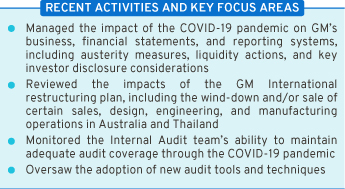 | 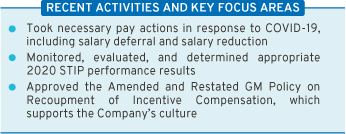 | |||||||
 | 19 |
FINANCE
| GOVERNANCE AND CORPORATE RESPONSIBILITY | |||||||
Joseph Jimenez Chair |
Members: Joseph Jimenez (Chair), Wesley G. Bush, Jane L. Mendillo, Judith A. Miscik, Patricia F. Russo, and Thomas M. Schoewe
Meetings held in 2020: 5 |
Patricia F. Russo Chair |
Members: Patricia F. Russo (Chair), Jane L. Mendillo, Theodore M. Solso, and Carol M. Stephenson
Meetings held in 2020: 4 | |||||
Key Responsibilities ● Reviews financial policies, strategies, and capital structure; ● Reviews the Company’s cash management policies and proposed capital plans, capital expenditures, dividend actions, stock repurchase programs, issuances of debt or equity securities, and credit facility and other borrowings; ● Reviews any significant financial exposures and risks, including foreign exchange, interest rate, and commodities exposures, and the use of derivatives to hedge those exposures; and ● Reviews the regulatory compliance, administration, financing, investment performance, risk and liability profile, and funding of the Company’s pension obligations.
|
Key Responsibilities ● Reviews the Company’s corporate governance framework, including all significant governance policies and procedures; ● Monitors Company policies and strategies related to corporate responsibility, sustainability, and political contributions and lobbying activities; ● Reviews the appropriate composition of the Board and recommends director nominees; ● Monitors the self-evaluation process of the Board and Committees; ● Recommends compensation of non-employee directors to the Board; and ● Reviews and approves related party transactions and any potential Board conflicts of interest, as applicable.
| |||||||
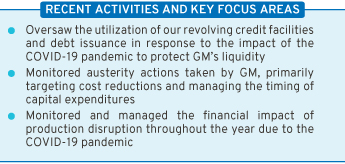 | 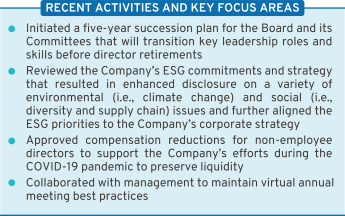 | |||||||
| 20 |
|
| RISK AND CYBERSECURITY | EXECUTIVE | |||||||
Linda R. Gooden Chair |
Members: Linda R. Gooden (Chair), Joseph Jimenez, Judith A. Miscik, Thomas M. Schoewe, and Devin N. Wenig
Meetings held in 2020: 3 |
Mary T. Barra Chair |
Members: Mary T. Barra (Chair), Theodore M. Solso, Linda R. Gooden, Joseph Jimenez, Patricia F. Russo, Thomas M. Schoewe, and Carol M. Stephenson
Meetings held in 2020: 0 | |||||
Key Responsibilities ● Reviews the Company’s key strategic, enterprise, and cybersecurity risks; ● Reviews privacy risk, including potential impact to the Company’s employees, customers, and stakeholders; ● Reviews the Company’s risk management framework and management’s implementation of risk policies, procedures, and governance to assess their effectiveness; ● Reviews management’s evaluation of strategic and operating risks, including risk concentrations, mitigating measures, and the types and levels of risk that are acceptable in the pursuit and protection of shareholder value; and ● Reviews the Company’s risk culture, including the integration of risk management into the Company’s behaviors, decision-making, and processes.
|
The Board has an Executive Committee composed of the Chairman and CEO, the Independent Lead Director, and the Chairs of all other standing Committees. The Executive Committee is chaired by Ms. Barra, and it can act on certain limited matters for the full Board in intervals between meetings of the Board. The Executive Committee meets as necessary, and all actions by the Executive Committee are reported and ratified at the next succeeding Board meeting. Because the Board was able to address all items throughout the year, no Executive Committee meetings were needed in 2020. | |||||||
 | 21 |
Board and Committee Oversight of Risk
| u | Role of the Board of Directors |
The Board of Directors has overall responsibility for risk oversight and focuses on the most significant risks facing the Company. The Board discharges its risk oversight responsibilities, in part, through delegation to its Committees. The Company’s risk governance is facilitated through a top-down and bottom-up communication structure, with the tone established at the top by Ms. Barra, our Chairman and CEO, who is also our Chief Risk Officer, and other members of management, specifically the Senior Leadership Team. The Senior Leadership Team also utilizes our Risk Advisory Council, an executive-level body with delegates from each business unit and function, to discuss and monitor the most significant enterprise risks in a cross-functional setting. They are tasked with championing risk management practices and integrating them into their functional or regional business units.
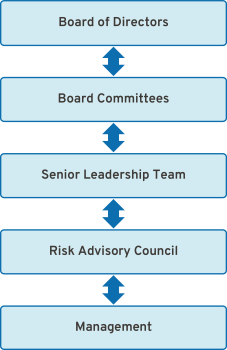
| u | Role of the Board Committees |
Each of the Board’s Committees has a critical role to play in the overall execution of the Board’s risk oversight duties. The Board delegates oversight for certain risks to each Committee based on the risk categories relevant to the subject matter of the Committee. The Chair of the Risk and Cybersecurity Committee coordinates with the Chairs of the other Committees to support them in managing the relationship between risk management policies
and practices and their respective oversight responsibilities. The Risk and Cybersecurity Committee also assists the Board by monitoring the overall effectiveness of the Company’s risk management framework and processes. Below is a summary of the key risk oversight responsibilities that the Board has delegated to the Committees.
| 22 |
|
RISKAND CYBERSECURITY COMMITTEE
|
AUDIT COMMITTEE
| |||
Oversees risks related to the Company’s key strategic, enterprise, and cybersecurity risks, including workplace and product safety and privacy
| Oversees risks related to financial reporting, internal controls, and auditing matters
Oversees risks related to legal, regulatory, and compliance programs | |||
FINANCE COMMITTEE
|
GOVERNANCE AND CORPORATE RESPONSIBILITY COMMITTEE | |||
Oversees significant financial exposures and contingent liabilities of the Company
Oversees regulatory compliance of employee-defined benefits plans | Oversees risks related to public policy and political activities
Oversees risks related to director independence and related party transactions
Oversees risks related to the sustainability of our operations and products | |||
EXECUTIVE COMPENSATION COMMITTEE
|
Oversees risks related to executive and employee compensation plans, including by designing compensation plans that promote prudent risk management
|
| u | Enterprise Risk Oversight |
In addition to supporting the risk governance structure outlined above, GM’s Strategic Risk Management team conducts an annual risk assessment designed to prioritize GM’s most significant enterprise risks. The Risk and Cybersecurity Committee reviews this assessment, approves the Enterprise Risk Profile, and receives more detailed management updates on these risks during the year. The Committee also receives updates on the overall risk landscape, including the Enterprise Risk
Dashboard, which highlights risk trends, and an Emerging Risk Radar, which provides a perspective on risks on the horizon. Finally, summaries of management risk reviews, conducted across our business units and regions, are provided to share risk management practices and give a sense for risk topics being covered. Below are certain key enterprise risks that the Board and management have identified for 2021.
Talent |
Electric Vehicle Transition
|
Supply Chain Disruptions |
Privacy & Data Management |
Manufacturing Disruptions | ||||||||||||
| ||||||||||||||||
Workplace Safety & Health
|
Vehicle Safety |
Shifting Trade & Government
|
Economic Fluctuations |
Cybersecurity |
 | 23 |
| u | Cybersecurity Risk Oversight |
At each quarterly meeting, the Risk and Cybersecurity Committee reviews management’s Cybersecurity Maturity Scorecard, which leverages both the National Institute of Standards and Technology cybersecurity framework and the Federal Financial Institutions Examination Council maturity rating. Management discusses various information security, manufacturing cybersecurity, and product cybersecurity topics and provides intelligence briefings on notable cyber events impacting the industry. The briefings summarize the vulnerabilities that led to the event, provide insight into what happened, and highlight learnings that GM can leverage in the future.
GM’s Global Cybersecurity organization aligns cybersecurity domains across GM, GM Financial (our automotive finance subsidiary), Cruise (our subsidiary responsible for the development and commercialization of autonomous vehicle technology), and our growth businesses. It also enables GM to leverage both business and technical experts to accelerate the development and execution of security solutions. Our global team is charged with executing enterprise, product, and manufacturing cybersecurity programs, with a focus on security architecture,
penetration testing, cyber risk management, incident response, vulnerability management, intelligence, awareness and training, and governance. GM applies a defense-in-depth cybersecurity strategy, making it more difficult for attackers to breach the defenses and allowing for quick detection, deflection, and counteraction attempts of unauthorized access.
GM also includes multi-domain cybersecurity training as part of its corporate required training program. In addition, training and awareness is integrated and continues throughout the year, utilizing various delivery methods such as phishing campaigns, live training sessions, and informational articles. GM continues to invest heavily in cybersecurity, including through the nearly 500 dedicated employees. These employees have diverse skillsets and include pen-testers, cryptologists, analysts, architects, data analysts, security engineers, program managers, and “true hackers.” Global Cybersecurity uses a balanced approach in validating the efficacy of its risk management program, leveraging cybersecurity resources, and GM’s internal audit services as well as engaging with external, third-party expertise at least annually across the domains.
| u | Privacy Risk Oversight |
In recent years, GM’s Strategic Risk Management team determined that privacy risks were increasing in significance due to the enactment of new and more stringent U.S. and global regulations on the use and protection of personal information. Accordingly, the Risk and Cybersecurity Committee has taken steps to continue to enhance its oversight on GM’s data privacy policies and practices. The Committee’s
charter makes it clear that the Committee is responsible for overseeing GM’s privacy risks relating to the Company’s employees, customers, and stakeholders. The Committee also devotes portions of its meetings to discuss critical privacy issues with management, including GM’s processes and policies designed to ensure compliance with the California Consumer Privacy Act.
| 24 |
|
The Board’s Governance Policies and Practices
| u | Code of Business Conduct and Ethics: “Winning with Integrity” |
The Board is committed to the highest legal and ethical standards in fulfilling its responsibilities. We have adopted a code of business conduct and ethics, “Winning with Integrity,” that applies to our directors and employees, including the Company’s executive officers. This Code of Conduct forms the foundation for compliance with corporate policies and procedures and creates a Company-wide focus on uncompromising integrity in every aspect of our operations. It embodies our expectations for a number of topics, including workplace and vehicle safety, conflicts of interest, protection of confidential information, insider trading, competition and fair dealing, human rights, community involvement and corporate citizenship, political activities and lobbying,
preservation and use of Company assets, and compliance with all laws and regulations applicable to the conduct of our business. Employees are expected to report any conduct that they believe in good faith to be an actual or apparent violation of our Code of Conduct. The Code of Conduct is available at investor.gm.com/resources.
In addition, GM’s Insider Trading Policy prohibits all GM directors and employees, including executive officers, from trading in GM derivatives (i.e., puts or calls), engaging in short sales, or otherwise engaging in hedging activities, and pledging of GM securities. This policy is posted on our website at investor.gm.com/resources.
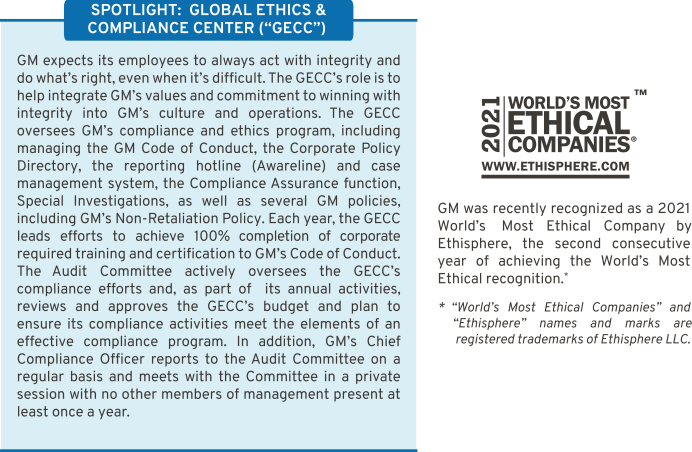
 | 25 |
| u | Corporate Governance Guidelines |
Our Corporate Governance Guidelines form a transparent framework for the effective governance of the Company. The Corporate Governance Guidelines address matters such as the respective roles and responsibilities of the Board and management, the Board’s leadership structure, the responsibilities of the Independent Lead Director, director independence, the Board membership criteria, Board Committees, and Board and CEO evaluation. The Governance
Committee regularly reviews the Corporate Governance Guidelines and periodically recommends to the Board the adoption of amendments in response to changing regulations, evolving best practices, and shareholder concerns. For a summary of our corporate governance best practices, please see “Shareholder Protections and Governance Best Practices” on page 30 of this Proxy Statement.
| u | CEO Succession Planning |
Our Independent Lead Director oversees the CEO succession planning process and leads, at least annually, the Board’s discussion of CEO succession planning. Our CEO provides the Board with recommendations for and evaluations of potential CEO successors and reviews with the Board development plans for these successors. Directors engage with potential CEO and senior
management talent at Board and Committee meetings and in less formal settings to enable directors to personally assess candidates. The Board reviews management succession in the ordinary course of business as well as contingency planning in the event of an emergency or unanticipated event.
| u | Board and Committee Evaluations |
The Governance Committee periodically reviews the form and process for Board and Committee self-evaluations. In 2020, following extensive benchmarking, engagement with shareholders, interviewing third-party facilitators, and internal
discussion, the Board approved, based on the recommendation of the Governance Committee, changes to its self-evaluation process. Beginning in 2021, the Board and its Committees will observe the following self-evaluation process:

Throughout the process, directors have ample opportunity to provide feedback on individual director performance.
The Board is committed to incorporating feedback from its self-evaluations. Recent examples of changes to practice include evolving the
composition of the Board (see page 17 of this Proxy Statement), conducting an extensive review of the Company’s e-commerce strategy, increasing the number of standing Audit Committee meetings, and increasing the frequency of off-cycle Board touchpoints and communications.
| u | Annual Evaluation of CEO |
Each year, the Board reviews the CEO’s performance against her annual strategic goals. The non-management directors, meeting separately in executive session, annually conduct a formal evaluation of the CEO, which is communicated to the CEO by the Independent Lead Director. The evaluation is based on both objective and subjective criteria, including, but not limited to, the Company’s financial performance;
accomplishment of ongoing initiatives in furtherance of the Company’s long-term strategic objectives; and development of the Company’s top management team. The results of the evaluation are considered by the Compensation Committee in its deliberations when determining the compensation of the CEO as further described in “Executive Compensation” on page 57 of this Proxy Statement.
| 26 |
|
| u | Director Orientation and Continuing Education |
All new directors participate in the Company’s director orientation program. The orientation enables new directors to become familiar with the Company’s business and strategic plans; significant financial matters; core values and behaviors, including ethics; compliance programs; corporate governance practices; and other key policies and practices.
Continuing education opportunities are provided to keep directors updated with information about the Company and its strategy, operations,
products, and other matters relevant to Board service. Board members are encouraged to visit GM facilities and dealers and attend auto shows and other key corporate and industry events to enhance their understanding of the Company and its competitors in the auto industry. In addition, all directors are encouraged to attend, at our expense, director continuing education programs sponsored by governance organizations and other institutions.
| u | Director Service on Other Public Company Boards |
The Board recognizes that service on other public company boards provides directors valuable experience that benefits the Company. The Board also believes, however, that it is critical that directors dedicate sufficient time to their service on the Company’s Board. Directors are expected to advise the Chairman, Independent Lead Director, or Chair of the Governance Committee in advance of accepting an invitation to serve on another board of directors or any audit committee of another public company board. This allows the Governance Committee to assess the impact of the director’s joining another board based on various factors relevant to the specific situation, including the nature and extent of a director’s other professional obligations and the time commitment attendant to the new position. Directors who are engaged in active, full-time employment, for example, could have less time to devote to Board service than a director whose
principal occupation is serving on boards. Our Corporate Governance Guidelines provide that without obtaining the approval of the Board:
| • | A director may not serve on the boards of more than four other public companies (excluding nonprofits and subsidiaries). |
| • | No member of the Audit Committee may serve on more than two other public company audit committees. |
In general, senior members of management may not serve on the board of more than one other public company or for-profit entity, and executive officers must obtain the approval of the Governance Committee prior to accepting an invitation to serve on an outside board. All directors and senior members of management are in compliance with this policy.
| u | Compensation Committee Interlocks and Insider Participation |
Mses. Stephenson and Russo and Messrs. Bush and Jimenez served on the Compensation Committee in 2020. As of the date of this Proxy Statement, no member of the Compensation Committee was or is a GM officer or employee,
and no executive officer of the Company served or serves on the compensation committee or board of any company that employed or employs any member of the Company’s Compensation Committee or Board.
The Company routinely engages with shareholders and stakeholders to help the Board and management gain feedback on a variety of topics.
For example, every year since 2017, the Board has invited at least one shareholder to a Board meeting to provide its perspective on the Company’s strategic direction. In 2020, for the
 | 27 |
first time, the Board invited a non-GM shareholder into the boardroom to solicit perspectives on potential actions the Company could take to attract new investors. The constructive insights, experiences, and ideas exchanged during these engagements have helped the Board evaluate and assess key initiatives during the Company’s ongoing transition to an all-electric future.
Members of the Board and senior management also regularly engage with institutional shareholders on topics including executive compensation, Board composition and leadership structure, as well as on important environmental and social issues. The table below provides an overview of common themes we have heard that led to boardroom discussion and action.
Message | Actions | |
Encouraged to communicate the Board’s succession plan given Mr. Solso’s retirement. | For a discussion of the actions taken to transition the Independent Lead Director role, see page 17 of this Proxy Statement. | |
Encouraged to enhance climate change disclosures. | Please see the 2020 Sustainability Report for specific information regarding the Company’s recently announced plans to be carbon neutral by 2040 and the science-based targets we set to achieve those goals. | |
Encouraged to enhance disclosures regarding lobbying expenditures and public policy priorities. | Please see gm.com for actions taken to enhance our lobbying disclosure to (1) publish a list of our primary trade association memberships (i.e., those trade associations where in excess of $25,000 of our membership dues were used for lobbying activities); (2) outline our top state and federal policy priorities; and (3) discuss how the Board and management oversee our lobbying and political activities. In addition, prior to December 31, 2021, we will provide a report that will disclose how GM’s lobbying activity is aligned with the Paris Agreement’s goal of limiting average global warming to below 2° Celsius, which we believe our lobbying for policies supporting our vision for zero crashes, zero emissions, and zero congestion does, and if GM determines there is misalignment (with the Paris Agreement), we will highlight GM’s actions to mitigate. | |
Encouraged to disclose our Consolidated Federal Employer Information Report (EEO-1) and take action to help create a more diverse workforce. | We have committed to disclosing our annual Consolidated EEO-1 Report beginning in 2021. We will be posting GM’s 2020 Consolidated EEO-1 Report to our website. | |
Encouraged to report on the Company’s systems to ensure effective implementation of our Human Rights Policy. | We plan to revise our Human Rights Policy to align more strongly with international human rights frameworks. Please see the 2020 Sustainability Report for more information. | |
See page 44 of this Proxy Statement for feedback and actions taken related to GM’s Executive Compensation program.
| 28 |
|

Corporate Political Contributions and Lobbying Expenditures
| u | Board Oversight |
We participate in the political process to help shape public policy and address legislation that impacts GM, our industry, our shareholders, and other stakeholders. GM has supported and will continue to support public policies that drive the achievement of our long-term, sustainable growth. To guide our activities, the Board has adopted a U.S. Corporate Political Contributions and Expenditures Policy (“Political Contributions Policy”).
The Governance Committee oversees the Political Contributions Policy and annually reviews the Company’s engagement in the public policy process. The Governance Committee also annually
reviews all corporate political contributions, GM Political Action Committee contributions and expenditures (which are funded entirely by voluntary director and employee contributions), and the process by which such contributions and expenditures are made. Management also provides updates twice per year to the Governance Committee regarding the Company’s lobbying expenditures. In addition, the full Board also receives a monthly report on the most pressing public policy issues. The Board uses this report to continuously assess which issues are important to the Company’s long-term interests and which organizations the Company is working with to advance those interests.
| u | Transparency and Disclosure |
As part of our overall effort to promote political transparency and accountability, GM publishes an annual voluntary report of political contributions. In addition, GM files publicly available federal Lobbying Disclosure Act Reports each quarter, which disclose GM’s lobbying expenditures, describe legislation and general issues that were the topic of communication, and identify the individuals who lobbied on behalf of GM. GM also
files similar periodic reports with state agencies. In 2020, the Center for Political Accountability’s Zicklin Index of Corporate Political Accountability and Disclosure, which benchmarks the political disclosure and accountability policies and practices of leading U.S. public companies, recognized the quality of our disclosures and ranked GM among the First Tier of S&P 500 companies.
 | 29 |
Certain Relationships and Related Party Transactions
Our Code of Conduct requires all of our employees and directors to avoid any activity that is in conflict with our business interests. In addition, the Board has adopted a written policy regarding the review and approval or ratification of related party transactions (the “Related Party Transactions Policy”). Under the Related Party Transactions Policy, which is administered by our Governance Committee, directors and executive officers must report any potential related party transactions (including transactions involving immediate family members of directors and executive officers) to the General Counsel or Corporate Secretary to determine whether the transaction constitutes a related party transaction. If any member of the Governance Committee has a potential interest in any related party transaction, such member will recuse himself or herself and abstain from voting on the approval or ratification of the related party transaction.
For purposes of our Related Party Transactions Policy, a related party transaction includes transactions in which our Company (or a subsidiary), is a participant, the amount involved exceeds $120,000, and the related party has or will have a direct or an indirect material interest. Related parties of our Company consist of directors (including nominees for election as directors), executive officers, shareholders beneficially owning more than 5% of the Company’s voting securities, and the immediate family members of these individuals. Once a related party transaction has been identified, the Governance Committee will review all of the relevant facts and circumstances and approve or disapprove entry into the transaction. As required under SEC rules, we disclose all related party transactions annually in our Proxy Statement.
| u | Factors Used in Assessing Related Party Transactions |
• Whether the terms of the related party transaction are fair to the Company and on the same basis as if the transaction had occurred on an arm’s-length basis;
• Whether there are any compelling business reasons for the Company to enter into the related party transaction and the nature of alternative transactions, if any;
• Whether the related party transaction would impair the independence of an otherwise independent director; | • Whether the Company was notified about the related party transaction before its commencement, and if not, why preapproval was not sought and whether subsequent ratification would be detrimental to the Company; and
• Whether the related party transaction would present an improper conflict of interest for any director or executive officer of the Company, taking into account the specific facts and circumstances of such transaction. | |
The son of Craig Glidden, our Executive Vice President and General Counsel, is employed by Cruise as a Manager, Reliability and Lifecycle Planning, and in 2020 he had a salary and bonus in excess of $120,000. The SEC has identified employment of immediate family members of directors and executive officers as per-se related person transactions and subject to disclosure if the $120,000 threshold is met. In 2020, two holders of 5% or more of the Company’s common stock – BlackRock and Vanguard – provided
investment management services to Company-sponsored pension plans. The practice of disclosing related party transactions with investment management funds that are also 5% holders of an issuer’s stock is becoming more commonplace. In 2021, GM entered into an agreement for consulting services with Kissinger Associates for approximately $500,000. Our director, Ms. Miscik, is the Chief Executive Officer of Kissinger Associates.
 | 31 |
Our Values
Customers
We put the customer at the center of everything we do. We listen intently to our customers’ needs. Each interaction matters. Safety and quality are foundational commitments, never compromised.
Excellence
We act with integrity. We are driven by ingenuity and innovation. We have the courage to do and say what’s difficult. Each of us takes accountability for results, drives for continued efficiencies, and has the tenacity to win.
Relationships
Our success depends on our relationships inside and outside the Company. We encourage diverse thinking and collaboration from all over the world to create great customer experiences.
Seek Truth
We pursue facts, respectfully challenge assumptions, and clearly define objectives. When we disagree, we provide additional context and consider multiple perspectives.
Our Behaviors
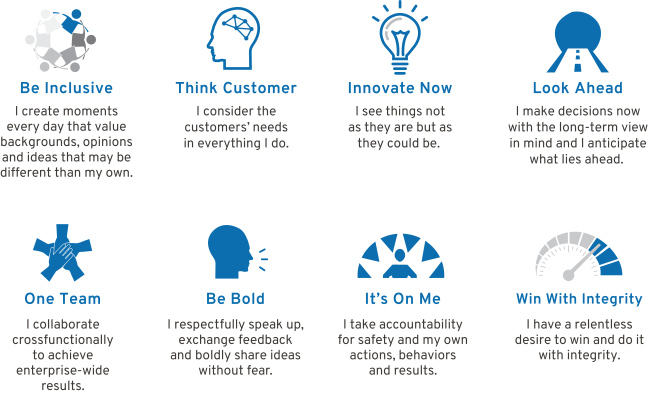
| 32 |
|
Our People, Our Communities, and Our Environment
Our Social and Environmental Impact strategy represents our commitment to our people, our communities, and our environment. We are proud of our efforts to build an inclusive and unified workforce while responding to a world in need during the COVID-19 pandemic. The GM team rose to the occasion to protect each other, our customers, and our communities. As some of our plants suspended production in the earliest days of the pandemic, our teams rapidly turned to
producing critical-care ventilators and personal protective equipment for patients and frontline healthcare workers. After our first conversation with Ventec Life Systems, we began production in just 30 days and built 30,000 ventilators in 154 days. Despite the challenges we faced as a society, we remained steadfast in our vision of a world with zero crashes, zero emissions, and zero congestion.
Our People
We are building a diverse, equitable, and inclusive team that is inspired to make people’s lives safer, more convenient, and more sustainable. In pursuit of our ambition to become the most inclusive company in the world, we are also committed to bringing our workforce along as we transform our
business and execute GM’s growth strategy. By applying our GM behaviors, we strive to inspire our team across various key dimensions, including teamwork, fairness, trust, growth, commitment, and recognition to make a lasting impact.
| u | Key Workforce Priorities |
| • | Talent Acquisition: Hiring top talent and investing in their success. |
| • | Talent Engagement: Creating a positive work environment and a place where employees feel inspired to do their best work and feel valued for doing it. |
| • | Talent Development: Increasing the number and variety of career resources available to employees. |
| • | Wellness and Benefits: Providing benefits that help employees balance their jobs with other |
aspects of their lives: market competitive pay; quality health care; 401(k) plans with Company contributions and matching programs; paid time off for vacations, illness, family care needs, and military leave; physical and mental health and well-being programs; and support for flexible and alternative work arrangements. |
| • | Labor Relations: Respecting our employees’ right to freedom of association in all countries, complying with all local labor laws and regulations, and engaging our workforce in our collective future. |
| u | Diversity, Equity, and Inclusion |
While we have a longstanding history of valuing diversity, equity, and inclusion, in 2020, as social and racial justice protests escalated across the United States, we took decisive actions to lead by example and stand up against injustices prevalent in society by setting an aspirational goal to become the world’s most inclusive company. As part of this effort, Ms. Barra, our Chairman and CEO, commissioned an Inclusion Advisory Board (“IAB”) composed of both internal and external leaders. The IAB’s role is to consult with GM’s Senior Leadership Team with the long-term goal of inspiring the Company to be inclusive through our words, deeds, and culture. We know there is more work ahead, yet we are proud of our efforts to create positive, sustainable social change, including the following:
| • | GM has long been a global leader in advocating for women’s equity in the workplace, with |
women in 30% of our top management positions within two levels of the CEO. We have also been recognized by organizations such as Equileap and the Bloomberg Gender-Equality Index for gender equality in the corporate sector. |
| • | GM’s policies and practices support the LGBTQ+ community. We extended same-sex domestic partner benefits early on and continue to provide full benefits to married LGBTQ+ couples. We also have a strong anti-discrimination policy that protects LGBTQ+ employees at GM. Beyond these measures designed to increase inclusion for our own employees, GM became a signatory to the Business Coalition for the Corporate Equality Act, which provides the same workplace protections to LGBTQ+ people as are provided to other protected groups under federal law. |
 | 33 |
| • | GM joined the Business Roundtable’s Multiple Pathways Initiative to hire employees based on the value of skills rather than just degrees and to improve equity and diversity in the workplace. GM also joined OneTen, a consortium of companies who have committed to create career opportunities for 1 million Black Americans over the next 10 years. |
| • | We signed the Gender and Diversity KPI Alliance (“KPI Alliance”) on International Women’s Day in 2021. The KPI Alliance is a group of diversity, equity, and inclusion advocates, corporations, academics, and trade organizations that support the adoption and use of a set of key performance indicators to measure gender and diversity. By signing on to the KPI Alliance, GM continues to advance its commitment to workplace inclusion and pledges to use three key performance indicators – percentage of representation on the GM board, percentage of representation by employee category, and pay equality – as part of its efforts to measure and improve diversity in its organization. |
| • | GM has also introduced a new employee behavior: Be Inclusive. This behavior involves creating moments every day that value backgrounds, opinions, and ideas that may be different from a person’s own. It also means creating opportunities where everyone can speak up and be heard, have active dialogues, be curious, and value differences. |
| • | GM has 11 Employee Resource Groups (“ERGs”) which are voluntary, employee-led groups that serve as a resource for their constituent members and a catalyst for promoting a diverse, inclusive workplace that aligns with the vision and core values of the Company. These ERGs, with chapters across the U.S. and the globe, all work toward our corporate effort to make GM the most inclusive company in the world. Importantly, ERGs are fully open to anyone interested in joining, and we are proud that one in three GM employees participates in an ERG. |

“At GM, promoting a culture that is inclusive and free of any and all discrimination allows our team members to proudly be who they are at work – in an environment that is open, supportive, and empowering – where everyone is valued and accepted.”
Telva McGruder
Chief of Diversity, Equity, and Inclusion
Our Communities
GM’s philanthropic investments create inclusive and sustainable solutions for our communities. This work puts people at the center and is structured under three focus areas aligned with the United Nations Sustainable Development Goals: expand access to science, technology, engineering, and math (“STEM”) educational opportunities, vehicle and road safety, and community development. We also prioritize programs that create equitable opportunities and
advance diversity, equity, and inclusion. In 2020, more than 65% of our grant funding supported a variety of diverse communities. While our social investments last year supported many COVID-related response programs, we maintained a portfolio of nearly $35 million in funding to 357 U.S.-based nonprofits. Together, these projects will impact an estimated 5 million individuals through a variety of support services.

| 34 |
|
Our Environment
Advancing an all-electric, zero-carbon future is not just our commitment – we are already underway. Earlier this year, we announced the following:
| • | We plan to be carbon neutral in our global products and operations by 2040, 10 years ahead of the goals set forth in the Paris Agreement on climate change. |
| • | We signed the Business Ambition for 1.5° C commitment and set science-based targets that align with the Paris Agreement. |
| • | We aspire to eliminate tailpipe emissions from new light-duty vehicles by 2035. |
| • | We will source 100% renewable energy to power our U.S. facilities by 2030 and our global facilities by 2035, five years earlier than our previously announced goal. |
Last year, we accelerated our transition to an all-electric lineup and announced our investment of more than $27 billion through 2025 on electric and autonomous vehicle programs. These investments will allow GM to offer 30 EVs globally by 2025. In that same year, 40% of GM’s U.S. models will be battery electric vehicles. Cadillac, GMC, Chevrolet, and Buick will all be represented, with EVs at price points for work, adventure, performance, and family use.
As we strive to meet our renewable energy goals, we expect to be 60% of the way toward our U.S. renewable energy commitment by 2023. GM is also currently the tenth largest off-taker of renewable energy in the world. In recognition of this, last year we received the 2020 Green Power Leadership Award from the U.S. Environmental Protection Agency.
We also recently announced that GM plans to reduce the water intensity of its operations by 35% by 2035, compared to a 2010 baseline. Ms. Barra has also signed the CEO Water Mandate – a U.N. Global Compact Initiative – joining other global business leaders to address the key challenges around water security and further aligning to the U.N. Sustainable Development Goals.
You can learn more about our sustainability accomplishments and goals in our 2020 Sustainability Report available at gmsustainability.com.

“Sustainability to me is about making sure that people can thrive now and in the future. That means things like having an inhabitable planet, safe ways for people to provide for themselves and their families, and helping to create a world in which everyone is treated equitably. As we continue to take bold action toward our vision of a world with zero emissions, we will focus equally on bringing everyone along.”
Kristen Siemen
Chief Sustainability Officer
 | 35 |
SECURITY OWNERSHIP INFORMATION
Security Ownership of Directors, Named Executive Officers, and Certain Other Beneficial Owners
The following table and accompanying footnotes show information regarding the beneficial ownership of GM’s issued and outstanding common stock by (i) each of our directors and NEOs, and all directors and executive officers as a group, each as of April 15, 2021, and (ii) each person known by us to beneficially own more than 5% of the issued and outstanding common stock as of the dates indicated in the footnotes. All directors and executive officers have sole voting and dispositive power over their shares. The Percentage of Outstanding Shares is based on 1,451,247,770 shares issued and outstanding as of April 15, 2021.
| Name | Shares of Common Stock Beneficially Owned | Percentage of Outstanding | ||||||
Non-Employee Directors(1) | ||||||||
Wesley G. Bush | 10,000 | (2) | * | |||||
Linda R. Gooden | 1,000 | (2) | * | |||||
Joseph Jimenez | 32,330 | (2) | * | |||||
Jane L. Mendillo | 4,560 | (2) | * | |||||
Judith A. Miscik | — | (2) | * | |||||
Patricia F. Russo | 25,000 | (2) | * | |||||
Thomas M. Schoewe | 22,005 | (2) | * | |||||
Theodore M. Solso | 6,561 | (2) | * | |||||
Carol M. Stephenson | 800 | (2) | * | |||||
Mark A. Tatum | — | (2) | * | |||||
Devin N. Wenig | — | (2) | * | |||||
Margaret C. Whitman | — | (2) | * | |||||
Named Executive Officers(1) | ||||||||
Mary T. Barra | 2,753,251 | (3) | * | |||||
Paul A. Jacobson(4) | 87,654 | (3) | * | |||||
Mark L. Reuss | 670,814 | (3) | * | |||||
Douglas L. Parks | 100,868 | (3) | * | |||||
Stephen K. Carlisle(5) | 83,344 | (3) | * | |||||
Dhivya Suryadevara(6) | — | (3) | * | |||||
John P. Stapleton(7) | 183,211 | (3) | * | |||||
Barry L. Engle II(8) | 1,579 | (3) | * | |||||
All Directors and Executive Officers as a Group (26 persons, including the foregoing) | 5,766,125 | (3) | * | |||||
Certain Other Beneficial Owners(9) | ||||||||
BlackRock, Inc.(10) | 106,303,679 | 7.3 | % | |||||
The Vanguard Group(11) | 90,641,771 | 6.2 | % | |||||
Capital Research Global Investors(12) | 90,122,701 | 6.2 | % | |||||
Capital World Investors(13) | 81,002,941 | 5.6 | % | |||||
Berkshire Hathaway Inc.(14) | 72,500,000 | 5.0 | % | |||||
| * | Less than 1%. |
| 36 |
|
| (1) | c/o General Motors Company, 300 Renaissance Center, Detroit, Michigan 48265. |
| (2) | These amounts represent common stock only and do not include DSUs, which are unit equivalents of our common stock, under the Director Compensation Plan described on page 12 of this Proxy Statement. Directors hold the following number of DSUs: 16,348 DSUs for Mr. Bush; 26,416 DSUs for Ms. Gooden; 49,863 DSUs for Mr. Jimenez; 39,363 DSUs for Ms. Mendillo; 9,695 DSUs for Ms. Miscik; 51,164 DSUs for Ms. Russo; 40,336 DSUs for Mr. Schoewe; 102,143 DSUs for Mr. Solso; 76,552 DSUs for Ms. Stephenson; 0 DSUs for Mr. Tatum; 24,461 DSUs for Mr. Wenig; and 0 DSUs for Ms. Whitman. |
| (3) | These amounts include shares that may be acquired upon exercise of stock options that are currently exercisable or will become exercisable within 60 days of April 15, 2021, as follows: 1,627,619 shares for Ms. Barra; 12,654 shares for Mr. Jacobson; 530,644 shares for Mr. Reuss; 73,046 shares for Mr. Parks; 24,306 shares for Mr. Carlisle; and 162,301 shares for Mr. Stapleton. |
| (4) | Mr. Jacobson joined the Company as the Executive Vice President and Chief Financial Officer, effective December 1, 2020. |
| (5) | Mr. Carlisle was named Executive Vice President and President, North America, effective July 15, 2020. |
| (6) | Ms. Suryadevara resigned as Executive Vice President and Chief Financial Officer, effective September 1, 2020. |
| (7) | Mr. Stapleton served as the Acting Chief Financial Officer from August 15, 2020, through November 30, 2020. |
| (8) | On July 6, 2020, the Company determined that Mr. Engle would leave his position as Executive Vice President and President, North America, and separated from the Company effective September 1, 2020. |
| (9) | The Company is permitted to rely on the information reported by each beneficial owner in filings with the SEC and has no reason to believe that the information is incomplete or inaccurate or that the beneficial owner should have filed an amended report and did not. |
| (10) | Based solely on information set forth in a Schedule 13G/A filed with the SEC on January 29, 2021, BlackRock, Inc., reported that it and its subsidiaries listed on Exhibit A to Schedule 13G/A were the beneficial owners of 106,303,679 shares of GM’s outstanding common stock as of December 31, 2020. BlackRock reported having sole voting power over 94,239,240 shares and sole dispositive power over 106,303,679 shares. No shared voting or dispositive powers were reported. The address for BlackRock, Inc., is 55 East 52nd Street, New York, New York 10055. |
| (11) | Based solely on information set forth in a Schedule 13G/A filed with the SEC on February 10, 2021, The Vanguard Group reported that it and its subsidiaries listed on Appendix A of Schedule 13G/A were the beneficial owners of 90,641,771 shares of GM’s outstanding common stock as of December 31, 2020. The Vanguard Group reported having sole dispositive power over 85,272,471 shares, shared voting power over 2,017,193 shares, and shared dispositive power over 5,369,300 shares. No sole voting power was reported. The address for The Vanguard Group is 100 Vanguard Boulevard, Malvern, Pennsylvania 19355. |
| (12) | Based solely on information set forth in a Schedule 13G filed with the SEC on February 16, 2021, Capital Research Global Investors reported that it is the beneficial owner of 90,122,701 shares of GM’s outstanding common stock as of December 31, 2020. Capital Research Global Investors reported having sole voting power over 90,119,869 shares and sole dispositive power over 90,122,701 shares. No shared voting or dispositive powers were reported. |
| (13) | Based solely on information set forth in a Schedule 13G/A filed with the SEC on February 16, 2021, Capital World Investors reported that it is the beneficial owner of 81,002,941 shares of GM’s outstanding common stock as of December 31, 2020. Capital World Investors reported having sole voting power over 80,878,094 shares and sole dispositive power over 81,002,941 shares. No shared voting or dispositive powers were reported. |
| (14) | Based solely on information set forth in a Schedule 13G/A filed with the SEC on February 16, 2021, Warren E. Buffett and Berkshire Hathaway Inc. and its subsidiaries listed on Exhibit A to Schedule 13G/A reported being the beneficial owners of 72,500,000 shares of GM’s outstanding common stock as of December 31, 2020, over which they had shared voting and dispositive power. No sole voting or dispositive power was reported. The address for Berkshire Hathaway Inc. is 3555 Farnam Street, Omaha, Nebraska 68131. |
 | 37 |
The Audit Committee of the Board of Directors of General Motors Company is a standing committee composed of five directors: Thomas M. Schoewe (Chair), Wesley G. Bush, Linda R. Gooden, and Jane L. Mendillo.


Purpose
The Audit Committee’s core purpose is to assist the Board by providing oversight of:
| • | The quality and integrity of GM’s financial statements; |
| • | GM’s compliance with legal and regulatory requirements; and |
| • | The qualifications and independence of GM’s external auditors and the performance of GM’s internal audit staff and external auditors. |
The Audit Committee operates under a written charter adopted by the Audit Committee and approved by the Board of Directors. The Audit Committee’s charter is posted on our website at investor.gm.com/resources. The Audit Committee’s charter is reviewed at least annually and updated as necessary to address changes in
regulatory requirements, authoritative guidance, evolving oversight practices, and shareholder feedback.
Management is responsible for the Company’s internal controls and the financial reporting process and has delivered its opinion on the effectiveness of the Company’s controls. EY is responsible for performing an independent audit of the Company’s consolidated financial statements and opining on the effectiveness of internal controls over financial reporting in accordance with the standards of the Public Company Accounting Oversight Board (United States) (the “PCAOB”) and issuing its reports thereon. As provided in its charter, the Audit Committee’s responsibilities include monitoring and overseeing these processes.
Required Disclosures
In 2020, the Audit Committee met seven times and fulfilled all of its core charter obligations. Consistent with its charter responsibilities, the Audit Committee met and held discussions with management and EY regarding the Company’s audited financial statements and internal controls for the year ended December 31, 2020. In this context, management represented to the Audit Committee that the Company’s consolidated financial statements were prepared in accordance with accounting principles generally accepted in the United States. The Audit Committee reviewed and discussed the consolidated financial statements with management and EY and further discussed with EY the matters required to be discussed by the requirements of the PCAOB and the SEC. This review included a discussion with management and EY of the quality, not merely the acceptability, of GM’s accounting principles, the reasonableness of significant estimates and
judgments, and the clarity of disclosure in GM’s financial statements, including the disclosures related to critical accounting estimates and critical audit matters. EY also provided to the Audit Committee the written disclosures and letter required by the applicable requirements of the PCAOB concerning independence, and the Audit Committee discussed with EY the auditor’s independence. The Audit Committee also considered and determined that the provision of non-audit services to GM is compatible with maintaining EY’s independence. The Audit Committee concluded that EY was independent from the Company and management.
For additional information about GM’s policies and procedures related to the approval of EY’s audit and non-audit services, see “Policy for Approval of Audit and Permitted Non-Audit Services” on page 40 of this Proxy Statement.
| 38 |
|
Recommendation
Based upon the Audit Committee’s discussions with management and EY as described in this report and the Audit Committee’s review of the representation of management and the reports of EY to the Audit Committee, the Audit Committee recommended to the Board of Directors, and the Board of Directors approved, the inclusion of the audited consolidated financial statements in the Company’s Annual Report on Form 10-K for the year ended December 31, 2020, as filed with the U.S. Securities and Exchange Commission on February 10, 2021.
Audit Committee
Thomas M. Schoewe (Chair)
Wesley G. Bush
Linda R. Gooden
Jane L. Mendillo
The preceding Audit Committee Report shall not be deemed incorporated by reference by any general statement incorporating by reference this Proxy Statement or any portion hereof into any filing under the Securities Act of 1933, as amended, or the Securities Exchange Act of 1934, as amended, and shall not otherwise be deemed filed thereunder.
 | 39 |
Fees Paid to Independent Registered Public Accounting Firm
The following table summarizes the fees for professional services provided by EY for the audit of GM’s annual financial statements and internal control over financial reporting for the years ended December 31, 2020 and 2019, together with the fees billed for other services rendered by EY during these periods.
| Type of Fees | 2020 ($ in millions) | 2019 ($ in millions) | ||||||
Audit | 21 | 22 | ||||||
Audit-Related | 4 | 5 | ||||||
Tax | 2 | 3 | ||||||
Subtotal | 27 | 30 | ||||||
All Other Services | — | — | ||||||
TOTAL | 27 | 30 | ||||||
Audit Fees — Includes fees for the integrated audit of the Company’s annual consolidated financial statements and attestation of the effectiveness of the Company’s internal controls over financial reporting, including reviews of the interim financial statements contained in the Company’s Quarterly Reports on Form 10-Q and audits of statutory financial statements.
Audit-Related Fees — Includes fees for assurance and related services that are traditionally performed by the independent registered public accounting firm. More specifically, these services include employee benefit plan audits, comfort letters in connection with funding transactions, other attestation services, and consultations concerning financial accounting and reporting standards.
Tax Fees — Includes fees for tax compliance, tax planning, and tax advice. Tax compliance involves preparation of original and amended tax returns and claims for refund. Tax planning and tax advice encompass a diverse range of services, including assistance with tax audits and appeals, tax advice related to mergers and acquisitions and employee benefit plans, and requests for rulings or technical advice from taxing authorities.
All Other Fees — Includes fees for services that are not contained in the above categories and consists of permissible advisory services.
Policy for Approval of Audit and Permitted Non-Audit Services
The services performed by EY in 2020 were preapproved in accordance with the preapproval policy and procedures established by the Audit Committee. This policy requires that prior to the provision of services by the auditor, the Audit Committee will be presented, for consideration, with a description of the types of Audit-Related, Tax, and All Other Services expected to be performed by the auditor during the fiscal year, with amounts budgeted for each category (Audit-Related, Tax, and All Other Services). Any requests for such services for $1 million or more not contemplated and approved by the Audit Committee initially must thereafter be submitted to the Audit Committee for specific preapproval. Requests for services less than $1 million individually can be approved by management based on the amounts approved for each
category. Management must report actual spending for each category to the full Audit Committee periodically throughout the year.
These services are actively monitored (both spending and work content) by the Audit Committee to maintain the appropriate objectivity and independence in EY’s core work, which is the audit of the Company’s consolidated financial statements and internal controls. The Audit Committee determined that all services provided by EY in 2020 were compatible with maintaining the independence of EY.
| 40 |
|

| Compensation Discussion and Analysis |
| |||
| Compensation Overview | 42 | |||
| Compensation Principles | 49 | |||
| Compensation Elements | 49 | |||
| Performance Measures | 51 | |||
| Performance Results and Compensation Decisions | 54 | |||
| Compensation Policies and Governance Practices | 65 | |||
| Compensation Committee Report | 68 | |||
| Executive Compensation Tables |
| |||
| Summary Compensation Table | 69 | |||
| Grants of Plan-Based Awards | 72 | |||
| Outstanding Equity Awards at Fiscal Year-End | 74 | |||
| Option Exercises and Stock Vested | 75 | |||
| Pension Benefits | 76 | |||
| Nonqualified Deferred Compensation Plan | 78 | |||
| Potential Payments Upon Termination | 79 | |||

AFCF | — | Automotive Free Cash Flow | ||
AV | — | Autonomous Vehicle | ||
DB | — | Defined Benefit | ||
DC | — | Defined Contribution | ||
EBIT | — | Earnings Before Interest and Taxes | ||
EPS | — | Earnings Per Share | ||
ESG | — | Environmental, Social, and Governance  | ||
EV | — | Electric Vehicle | ||
GICS | — | Global Industry Classification Standard | ||
HCM | — | Human Capital Management | ||
LTIP | — | Long-Term Incentive Plan | ||
NEO | — | Named Executive Officer | ||
NQ | — | Nonqualified | ||
OEM | — | Original Equipment Manufacturer | ||
PSU | — | Performance Share Unit | ||
ROIC | — | Return on Invested Capital | ||
RSU | — | Restricted Stock Unit | ||
STIP | — | Short-Term Incentive Plan | ||
TSR | — | Total Shareholder Return | ||
WACC | — | Weighted Average Cost of Capital | ||

Mary T. Barra |
|
Chairman and Chief Executive Officer | ||
Paul A. Jacobson |
|
Executive Vice President and Chief Financial Officer | ||
Mark L. Reuss |
|
President | ||
Douglas L. Parks |
|
Executive Vice President, Global Product Development, Purchasing and Supply Chain | ||
Stephen K. Carlisle |
|
Executive Vice President and President, North America | ||
Dhivya Suryadevara |
|
Former Executive Vice President and Chief Financial Officer | ||
John P. Stapleton |
|
Vice President and Chief Financial Officer, North America, and Former Acting Chief Financial Officer | ||
Barry L. Engle II |
|
Former Executive Vice President and President, North America | ||
Positions as of December 31, 2020.
 | 41 |
| u | Our Company Performance |
In 2020, General Motors met the challenges presented by COVID-19 while working towards our vision of a world with zero crashes, zero emissions, and zero congestion. The results below demonstrate our commitment to safety for our employees and our customers, and highlight GM’s accelerated strategy to deliver an all-electric future powered by the strength of our core business.
 | ||||||
|
Committed more than $27 billion to EV and AV technologies through 2025 and announced plans to offer 30 EVs globally by 2025
| We ended 2020 with the following key financial results:(1)
(1) The financial information (2) These are non-GAAP (3) Refer to Appendix A for the | ||||
| Launched new business, BrightDrop, an ecosystem of first-to-last mile products, software, and services designed to help businesses deliver goods and services more efficiently while improving overall sustainability
| |||||
|
Announced North American alliance with Honda to jointly develop two EVs using the Ultium platform
| |||||
|
Announced Vehicle Intelligence Platform as the software foundation for all vehicle platforms. By 2023, 38 models will have the Vehicle Intelligence Platform allowing for over-the-air updates
| |||||
|
Showed strength and resiliency of the business responding to the challenges of the global pandemic while delivering $122.5 billion in revenue and launching and refreshing 23 vehicles globally
| |||||
|
Increased the retail average transaction price in the U.S. for the ninth year in a row, with a new record of $39,356 for 2020
| |||||
|
GM Financial generated record-breaking earnings before tax-adjusted of $2.7 billion and paid $800 million in dividends to GM
| |||||
|
Achieved highest-ever retail average transaction price for full-size trucks in the U.S. of $47,599
| |||||
|
Launched entirely new line-up of full-size SUVs, including the 2021 Chevrolet Tahoe and Suburban, 2021 GMC Yukon and Yukon XL, and 2021 Cadillac Escalade
| |||||
|
Sold over 1 million crossovers in the U.S. for the third year in a row
| |||||
|
Attracted highest ever percentage of new customers to the Chevrolet brand, with 46.7% of sales coming from conquest buyers
| |||||
|
Delivered strong performance in China, increasing Buick deliveries by 4.1% year-over-year driven by strong demand for premium multi-purpose vehicles and SUVs
| |||||
|
Debuted the all-new GMC HUMMER EV powered by Ultium
| |||||
|
Revealed the Cadillac LYRIQ show car, the first entry in the brand’s electric portfolio, positioning Cadillac to lead in electrification, connectivity, and hands-free driving
| |||||
|
Announced new OnStar Insurance Services, exemplifying our commitment to focus on safety and delivering a world-class customer experience
| |||||
|
Announced Microsoft will join GM, Honda, and institutional investors to accelerate the commercialization of self-driving, shared, all-electric vehicles in a combined new equity investment of more than $2 billion in Cruise, bringing the post-money valuation of Cruise to $30 billion | |||||
|
Received a permit from the California Department of Motor Vehicles to operate without anyone behind the wheel. Unveiled the Cruise Origin, a self-driving EV developed for a million miles of 24-hour EV service. Provided over 200,000 COVID-19 relief deliveries and announced a pilot with Wal-Mart Delivery
| |||||
|
Rapidly repurposed GM facilities to produce critical-care ventilators, masks, and personal protective equipment for front-line healthcare workers and first responders to help fight the COVID-19 pandemic
| |||||
|
Implemented cost-saving austerity measures across the organization in response to the global pandemic while maintaining employment levels and preserving liquidity by issuing unsecured bonds and drawing on our revolving credit facilities, which were paid off in full by the end of 2020
| |||||
|
Delivered the first Infantry Squad Vehicles to the U.S. Army as part of a $214.3 million contract awarded in 2020
| |||||
| 42 |
|
| u | Leadership Changes |
The Company made the following leadership changes during 2020:
Barry L. Engle II – On July 6, 2020, the Company determined that Mr. Engle would leave his position as Executive Vice President and President, North America, and support the transition of his duties and responsibilities to Mr. Carlisle. The Company and Mr. Engle entered into a separation agreement on September 1, 2020, as a qualified termination without cause under the terms of the General Motors LLC U.S. Executive Severance Program (“Executive Severance Program”) (filed as an exhibit to the 2020 Form 10-K). Mr. Engle is subject to the terms of a one-year non-compete agreement and other standard covenants. For additional details, see page 79 of this Proxy Statement.
Stephen K. Carlisle – Promoted to Executive Vice President and President, North America, effective July 15, 2020.
Dhivya Suryadevara – Resigned as Executive Vice President and Chief Financial Officer, effective September 1, 2020.
John P. Stapleton – Served as Acting Chief Financial Officer from August 15, 2020, through November 30, 2020.
Paul A. Jacobson – Named Executive Vice President and Chief Financial Officer, effective December 1, 2020.
| u | Compensation Governance and Best Practices |
| WHAT WE DO | ||
| ✓ | Provide short-term and long-term incentive plans with performance targets aligned to business goals | |
| ✓ | Maintain a Compensation Committee composed entirely of independent directors who are advised by an independent compensation consultant | |
| ✓ | Require stock ownership for all senior leaders | |
| ✓ | Engage with shareholders and other stakeholders on various topics with members of management and directors, including our Compensation Committee and our Independent Lead Director | |
| ✓ | Include non-compete and non-solicitation terms in all grant agreements with senior leaders | |
| ✓ | Maintain an Insider Trading Policy requiring directors, executive officers, and all other senior leaders to trade only during pre-established periods after receiving preclearance from the GM Legal Staff | |
| ✓ | Require equity awards to have double trigger (change in control and termination of employment) vesting provisions | |
| ✓ | Complete an annual risk review evaluating incentive compensation plans | |
| ✓ | Require short-term cash and long-term equity awards for all executive officers to be subject to clawback and cancellation provisions | |
| ✓ | Conduct an annual audit of senior executive expenses and perquisites | |
| ||
| WHAT WE DON’T DO | ||
× | Provide gross-up payments to cover personal income taxes or excise taxes pertaining to executive severance benefits | |
× | Pay above-market interest on deferred compensation in retirement plans | |
× | Allow directors or executives to engage in hedging or pledging of GM securities | |
× | Reward executives for excessive, imprudent, inappropriate, or unnecessary risk-taking | |
× | Allow the repricing or backdating of equity awards | |
 | 43 |
| u | Shareholder Engagement |
The Company views shareholder engagement as a continuous process and annually seeks feedback directly from our shareholders. Through these engagements, we received positive feedback in support of executive compensation programs and, in particular, the Compensation Committee’s decision to further drive accountability and reinforce our safety culture and ESG results.
Shareholder feedback is reflected through the new 2020 LTIP where PSU measures are equally weighted for Relative ROIC-adjusted (37.5% of total LTIP) and Relative TSR (37.5% of total LTIP), and performance measure payouts are subject to caps. These discussions, Say-on-Pay voting results, and alignment to the Company vision and strategic goals are key drivers in our ongoing assessment of our current and future programs. As executive compensation programs evolve, the Board remains committed to continuing the dialogue with shareholders regarding our compensation philosophy and practices.
|
SHAREHOLDER SAY-ON-PAY The Compensation Committee seeks to align the Company’s executive compensation programs with the interests of the Company’s shareholders. The Compensation Committee considers the results of the annual Say-on-Pay vote, the long-term vision and strategic goals of the Company, input from management, input from its independent compensation consultant, and investor engagement feedback when setting compensation for our executives. In 2020, 96.5% of our shareholders voted in favor of our executive compensation programs.
|
| Investor Alignment Topics | 2020 Activities | |
Enhanced Human Capital Management Disclosure | We remain committed to providing robust HCM practices and disclosure. Each year, the Company provides HCM updates through our Sustainability Report, which describes both the development of our workforce and updates on diversity, equity, and inclusion. We have taken further steps to foster an inclusive Company culture by creating our Inclusion Advisory Board, led by our Chairman and CEO, and adding “Be Inclusive” to our GM Behaviors to continue to impact positive social change. For additional information on our HCM initiatives, see “Our People, Our Communities, and Our Environment” section on page 33 of this Proxy Statement. | |
Evaluation of ESG Performance | ESG performance continues to be a focus for the Company and our shareholders. The Compensation Committee factors ESG performance into strategic goals for each NEO. We identify ESG results with a green leaf in the “Our Company Performance” section on page 42 of this Proxy Statement and the “Performance Results and Compensation Decisions” section for individuals starting on page 57 of this Proxy Statement, which reflect our ongoing commitment to ESG performance outcomes. | |
Balanced Approach to Short-Term and Long-Term Plans | The 2020 STIP focuses leadership on driving strong profitability and cash flow, as well as evaluating individual performance to strategic goals. The 2020 LTIP focuses leadership on stock price appreciation and encourages sound capital investments. We continue to evaluate the external market and hold conversations with investors to ensure the competitiveness, appropriateness, and overall balance of the STIP and LTIP. | |
Appropriate Peer Group Selection | The Compensation Committee reviews recommendations from its independent compensation consultant annually to determine any additions or deletions to the peer group that is used for compensation comparisons. We ensure our peer group composition remains competitive and appropriate as we continue to transform the organization. All companies in the peer group have been included for at least five consecutive years. A full disclosure of our consistent approach and framework can be found in the “Peer Group for Compensation Comparisons” section on page 47 of this Proxy Statement. | |
| 44 |
|
| u | Compensation Program Evolution |
Our compensation programs focus leadership on key areas that drive the business forward and align to the short-term and long-term interests of our shareholders. The Compensation Committee regularly reviews and discusses plan performance at each meeting. The Compensation Committee considers many factors when electing to make plan changes for future incentive plans, including results, market trends, feedback from its independent compensation consultant, and shareholder feedback. The timeline below shows the actions we have taken to develop compensation programs that align the interests of our senior leaders with those of our shareholders, including actions taken in response to COVID-19.
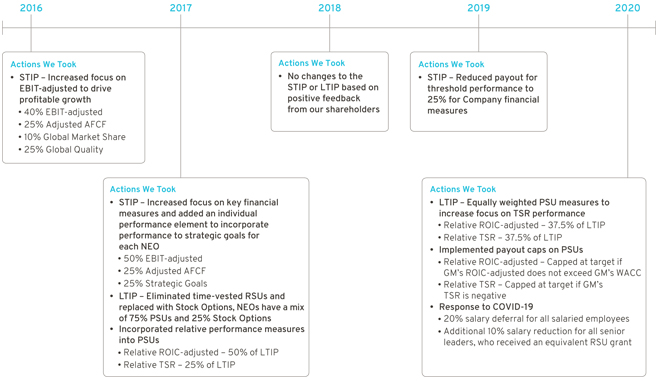
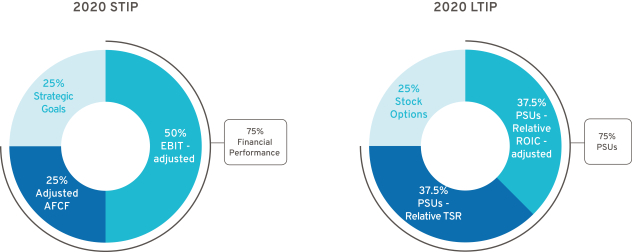
 | 45 |
The 2020 STIP focuses leadership on key financial measures (75% of STIP) and strategic goals (25% of STIP). The total payout for the STIP ranges from 0% to 200% based on performance against pre-established targets. The Compensation Committee determines performance to strategic goals using a rigorous assessment process measuring performance against pre-established operational goals, safety results, and other measures, including ESG outcomes. Payout for strategic goals performance will occur only if threshold performance of at least one financial measure is met.
The 2020 LTIP features Stock Options (25% of total LTIP) to align our most senior leaders with shareholders’ interest in stock price appreciation and PSUs (75% of total LTIP) with relative performance measures that drive long-term results. New for 2020, in response to feedback from our shareholders, PSUs are equally weighted for Relative ROIC-adjusted (37.5% of total LTIP) and Relative TSR (37.5% of total LTIP), and performance payouts are capped, as described below.
Relative ROIC-adjusted – Capped at target if GM’s ROIC-adjusted does not exceed GM’s WACC
Relative TSR – Capped at target if GM’s TSR is negative over the performance period
Focusing performance on EBIT-adjusted, Adjusted AFCF, and strategic goals in the short term, combined with measuring Relative ROIC-adjusted and Relative TSR compared to our OEM peer group in the long term, provides direct alignment of our executive compensation program with the interests of our shareholders and focuses senior leaders on making the investments that will provide profitable long-term growth.
| u | Peer Group for 2020–2022 LTIP Performance |
We use the following OEMs in the Dow Jones Automobiles & Parts Titans 30 Index to measure relative performance for Relative ROIC-adjusted and Relative TSR measures for the 2020–2022 PSU awards. The Compensation Committee uses this index for performance comparisons because these companies represent our global competition and are subject to similar macroeconomic challenges.
| Dow Jones Automobiles & Parts Titans 30 Index – OEM Peer Group(1) | ||||||
Bayerische Motoren Werke AG |
Honda Motor Co. Ltd. |
Nissan Motor Co. Ltd |
Suzuki Motor Corp. | |||
Daimler AG |
Hyundai Motor Co. |
Peugeot SA(2) |
Tesla, Inc. | |||
Fiat Chrysler Automobiles NV(2) |
Kia Motors Corp. |
Renault SA |
Toyota Motor Company | |||
Ford Motor Company |
Mazda Motor Corp. |
Subaru Corp. |
Volkswagen AG | |||
| (1) | GM is a member of the Dow Jones Automobiles & Parts Titans 30 Index. Our performance is determined on a continuous ranking for performance relative to the OEM peer group following the completion of the performance period. |
| (2) | Fiat Chrysler Automobiles NV and Peugeot SA merged on January 15, 2021. |
| 46 |
|
| u | Peer Group for Compensation Comparisons |
The Compensation Committee annually reviews the peer group for compensation comparisons and makes updates as needed to align with both the established criteria and Company strategy. We do not limit the peer group to our industry alone because we believe compensation practices for NEOs at other large U.S.-based multinational companies affect our ability to attract and retain diverse talent around the globe.
The Compensation Committee considered the following factors when selecting the peer group used to inform 2020 target compensation levels for our NEOs:
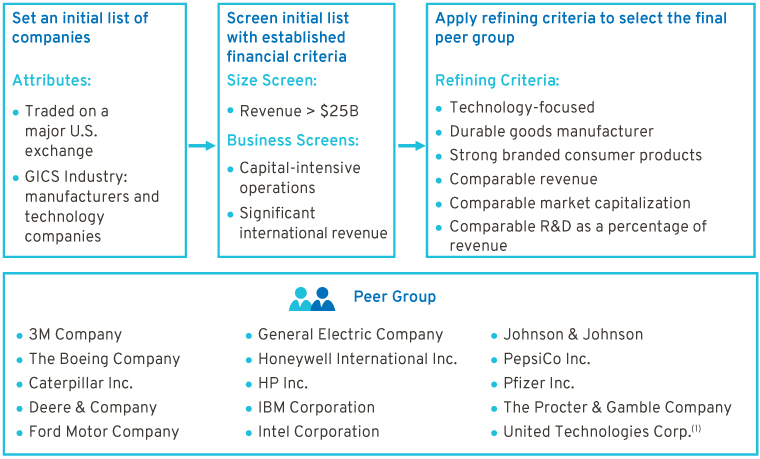
| (1) | United Technologies merged with Raytheon on April 3, 2020, forming Raytheon Technologies. United Technologies’ compensation data prior to the merger was used for 2020 compensation peer group comparisons. |

| u | How We Use Comparator Data to Assess Compensation |
We benchmark pay practices and compensation levels against the proxy statement disclosures of our peer group. In addition, we use executive compensation surveys to benchmark relevant market data for executive positions and adjust this data to reflect GM’s size and market-expected compensation trends. Furthermore, the Compensation Committee reviews an analysis completed by its independent compensation consultant of the competitive position of each of our executives relative to its benchmark data.
 | 47 |
We review each element of compensation compared with the market and generally target each element of our total direct compensation (base salary, STIP, and LTIP) for the executive group to be on average at or near the market median. An individual element or an individual’s total direct compensation may be positioned above or below the market median due to such considerations as specific responsibilities, experience, and performance.
| u | How We Plan Compensation |

| u | Performance-Based Compensation Structure |
Our incentive plans are designed to optimize long-term financial returns for our shareholders and reward our NEOs for delivering on the Company’s vision and strategy of zero crashes, zero emissions, and zero congestion. The performance-based structure for 2020 incorporated short-term and long-term incentives tied to financial and operational measures to drive Company performance for fiscal year 2020 and beyond. The Compensation Committee believes a majority of the compensation opportunity should be in the form of equity to align the interests of executives with those of shareholders.
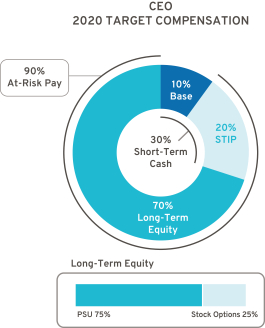 | 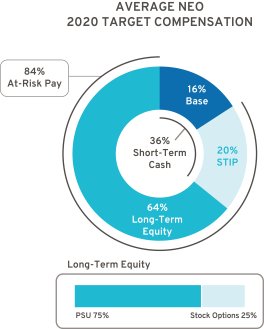 |
| 48 |
|
The compensation provided to our senior leaders is guided by pay-for-performance and the following principles:
Align with Shareholders – Compensation paid should align directly with the long-term interests of our shareholders, and our executives should share with them in the performance and value of our common stock.
Enable Company Strategy – Compensation should be based on challenging Company performance and strategic goals, which are within our executives’ control, and reward performance aligned with GM’s strategy, values, and expected behaviors.
Market Competitive – Target compensation should have an appropriate mix of short-term and long-term pay elements and should be competitive (market median) with that paid to individuals at peer group companies so that it attracts, motivates, and retains talent.
Avoid Excessive Risk Taking – Compensation structure should avoid incentivizing unnecessary and excessive risk taking.
Simple Design – Compensation plans should be easy to understand and communicate and minimize unintended consequences.
| u | Compensation Structure |
The 2020 compensation structure is market competitive with each pay element targeted at or near the market median and includes the following pay elements:
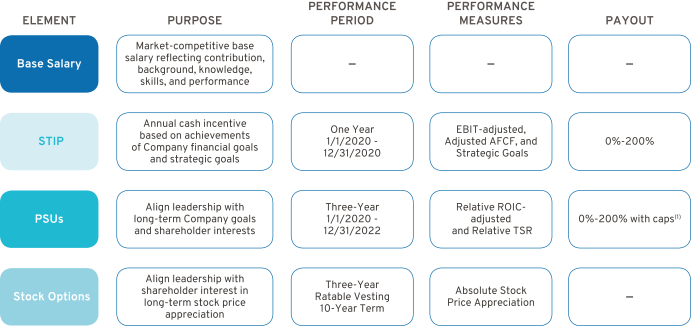
| (1) | Relative ROIC-adjusted is capped at target if GM’s ROIC-adjusted does not exceed GM’s WACC, and Relative TSR is capped at target if GM’s TSR is negative over the performance period. |
| u | Perquisites and Other Compensation |
We provide perquisites and other compensation to our NEOs consistent with market practices. The following perquisites and other compensation were provided in 2020.
Personal Air Travel – Ms. Barra is prohibited by Company policy from commercial air travel for business and personal use due to security reasons identified by an independent third-party security consultant. As
 | 49 |
a result, the Company pays the costs associated with the use of aircraft for both business and personal use. Other NEOs may travel on company aircraft in certain circumstances with prior approval from the CEO or the Senior Vice President, Global Human Resources. No NEOs, other than the CEO, had personal use of aircraft in 2020. All NEOs, including our CEO, incur imputed income when aircraft is used for personal travel and do not receive any tax gross-ups. NEOs may be eligible to reimburse personal travel pursuant to time-sharing agreements that the Company may enter into from time-to-time, subject to Federal Aviation Administration regulations.
Company Vehicle Programs – NEOs are eligible to participate in the Executive Company Vehicle Program and may use evaluation vehicles for the purpose of providing feedback on Company products. In addition, NEOs are eligible to use driver services provided by the Company in accordance with Company policies.
Security – NEOs may receive security services, including home security systems and monitoring, for specific security-related reasons identified by independent third-party security consultants. We maintain security staff in order to provide all employees with a safe and secure environment, which aligns and reinforces our safety culture.
Financial Counseling – NEOs are eligible to receive financial counseling, estate planning, and tax preparation services through an approved provider. These services allow our NEOs to focus on Company business and ensure accurate personal tax reporting.
Executive Physicals – The health and wellness of our workforce is a priority, and our employees are encouraged to complete an annual physical. NEOs are eligible to receive a comprehensive wellness examination with an approved provider. These wellness visits promote employee well-being and enable employees to take appropriate steps in the event of illness or a medical condition that may impact their ability to perform their duties.
| u | 2020 Target Compensation |
Our target total direct compensation for each NEO in 2020 was as follows:
| LTIP | ||||||||||||||||||||||||||||||||||||
Name | Base Salary ($) | STIP (%) | STIP ($) | Target Total Cash Compensation ($) | PSUs(1) ($) | Stock ($) | Target Total Compensation ($) | |||||||||||||||||||||||||||||
Mary T. Barra | 2,100,000 | 200 | % | 4,200,000 | 6,300,000 | 11,250,000 | 3,750,000 | 21,300,000 | ||||||||||||||||||||||||||||
Paul A. Jacobson(2) | 1,000,000 | 125 | % | 1,250,000 | 2,250,000 | 3,937,500 | 1,312,500 | 7,500,000 | ||||||||||||||||||||||||||||
Mark L. Reuss | 1,300,000 | 125 | % | 1,625,000 | 2,925,000 | 4,275,000 | 1,425,000 | 8,625,000 | ||||||||||||||||||||||||||||
Douglas L. Parks | 850,000 | 125 | % | 1,062,500 | 1,912,500 | 3,065,625 | 1,021,875 | 6,000,000 | ||||||||||||||||||||||||||||
Stephen K. Carlisle(2) | 800,000 | 125 | % | 1,000,000 | 1,800,000 | 2,925,000 | 875,000 | 5,600,000 | ||||||||||||||||||||||||||||
Dhivya Suryadevara(2) | 1,150,000 | 125 | % | 1,437,500 | 2,587,500 | 3,496,875 | 1,165,625 | 7,250,000 | ||||||||||||||||||||||||||||
John P. Stapleton(2) | 625,000 | 125 | % | 781,300 | 1,406,300 | 712,500 | 237,500 | 2,356,300 | ||||||||||||||||||||||||||||
Barry L. Engle II(2) | 850,000 | 125 | % | 1,062,500 | 1,912,500 | 3,065,625 | 1,021,875 | 6,000,000 | ||||||||||||||||||||||||||||
| (1) | The number of PSUs awarded is determined by using the target PSU value divided by the closing stock price on the date of grant. A portion of the PSU award with performance tied to Relative TSR is valued in the Summary Compensation Table using a Monte Carlo analysis resulting in amounts that may be higher or lower than target. |
| (2) | Table reflects full-year target total direct compensation. NEOs indicated were only in their roles for a partial year. |
| 50 |
|
| u | How We Set Performance Targets |
The Compensation Committee approves the performance measures for the STIP and LTIP annually. The Compensation Committee reviews recommendations from management, receives input from its independent compensation consultant, evaluates the annual budget and mid-term business plan, and reviews prior year performance to approve value-creating goals tied to long-term shareholder value.
| u | 2020 STIP Performance Measures |
STIP performance measures are linked to the Company’s annual financial goals and strategic goals that drive our long-term strategy. The Compensation Committee annually reviews and approves STIP performance measures that align with shareholders’ interests. 2020 STIP targets were set at the beginning of the performance period based on the business plan and prior to the start of the global pandemic.
Each year, the Compensation Committee approves strategic goals that align to delivering on our long-term Company strategy and objectives. Following the performance period, the Committee uses a scorecard to assess individual performance results to strategic goals and makes final compensation decisions as discussed beginning on page 57 of this Proxy Statement.
STIP awards, if any, are determined based on final Company performance and the Compensation Committee’s assessment of performance to strategic goals for each NEO. The table below describes each STIP performance measure — its weighting, its target, and the leadership behavior each measure drives. The targets for EBIT-adjusted and Adjusted AFCF aligned to the guidance provided in the Form 10-K for the year ended December 31, 2019, and were set above prior year results and prior to the start of the global pandemic.
STIP Performance Measure | Weight | Target | Leadership Behaviors | |||||||
EBIT-adjusted ($B)(1) | 50% | $12.9 | Focus on operating profit and driving strong profitability | |||||||
Adjusted AFCF ($B)(2) | 25% | $7.1 | Focus on driving strong cash flow to invest in the business | |||||||
Strategic Goals | 25% | 25 pts. | Focus on performance that aligns to the Company vision and drives business results | |||||||
| (1) | Measure adjusted for incentive purposes and excludes the impact of Cruise. For a description of how EBIT-adjusted is calculated, see Appendix A of this Proxy Statement. |
| (2) | Measure adjusted for incentive purposes and excludes payments related to certain recall-related expenses attributable to events occurring in 2014. For a description of how Adjusted AFCF is calculated, see Appendix A of this Proxy Statement. |
 | 51 |
The potential payouts for each Company performance measure ranges from 0% to 200% of target based on actual Company performance. The payout for threshold performance is 25% for both EBIT-adjusted and Adjusted AFCF; performance below threshold results in a 0% payout. Final STIP awards are calculated as follows:
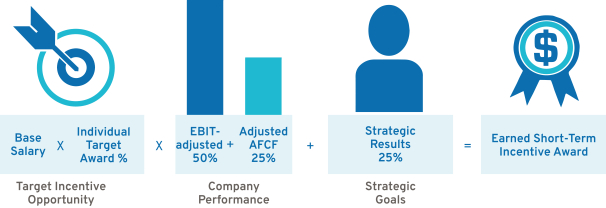
| u | 2020–2022 LTIP Performance Measures |
Grants made under the LTIP are intended to link the financial interests of NEOs with the long-term interests of shareholders. When determining grant amounts, the Compensation Committee considers factors such as individual responsibilities, experience, and performance. In addition, the Compensation Committee factors relevant market compensation comparison data and input provided by its independent compensation consultant. The structure includes 75% PSUs and 25% Stock Options. PSUs cliff-vest following a three-year performance period, and Stock Options vest ratably over three years.
PSUs are based on Relative ROIC-adjusted and Relative TSR performance against our OEM peer group shown on page 46 of this Proxy Statement. Beginning in 2020, PSUs are equally weighted for Relative ROIC-adjusted and Relative TSR, and both measures are subject to performance caps. The PSU performance measures promote the efficient use of capital for long-term growth in shareholder value with an increased focus on stock price appreciation. The table below describes each PSU performance measure — its weighting, the leadership behavior each measure drives, and its payout.
Performance Measure | Weight | Leadership Behaviors | 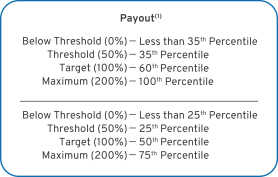 | |||||
Relative ROIC-adjusted | 50% | Focus on making sound investments that follow the disciplined capital approach of driving 20% or higher returns in world-class vehicles and leading technology | ||||||
Relative TSR | 50% | Focus on delivering shareholder returns that outperform our OEM peer group | ||||||
| (1) | Relative ROIC-adjusted is capped at target if GM’s ROIC-adjusted does not exceed GM’s WACC, and Relative TSR is capped at target if GM’s TSR is negative over the performance period. |
| 52 |
|
The 2020–2022 PSUs vest and are awarded and delivered following the completion of the three-year performance period beginning January 1, 2020, and may be earned at a level between 0% and 200% of target based on actual Company results relative to the OEM peer group. Final PSU awards are calculated as follows:
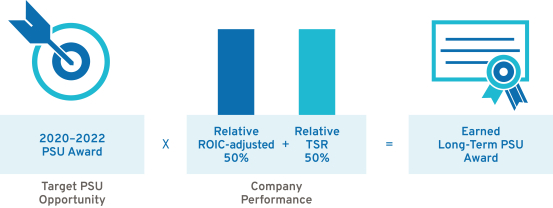
| u | Summary of Outstanding Performance Awards |
Each PSU award features a three-year performance period resulting in overlapping awards that, in aggregate, cover a five-year period. The potential payout for each PSU award ranges from 0% to 200%. The table below illustrates the performance period for the three outstanding PSU awards as of the filing date of this Proxy Statement and the corresponding performance measures and weights.

| (1) | The performance of each PSU award will be measured and determined at the end of the performance period. |
| (2) | Relative ROIC-adjusted is capped at target if GM’s ROIC-adjusted does not exceed GM’s WACC, and Relative TSR is capped at target if GM’s TSR is negative over the performance period. |
 | 53 |
Performance Results and Compensation Decisions
| u | 2020 STIP Results |
In 2020, the Company not only responded to the challenges presented by the global pandemic, which included work stoppages and global restrictions on consumers that impacted sales, but also positioned itself to emerge from the crisis in a stronger position by accelerating our long-term strategy of an all-electric future in the areas of EV and AV technologies.
During 2020, the Compensation Committee regularly reviewed and assessed Company performance. Following the completion of the performance year, the Committee completed a comprehensive assessment of total business results, including:
Initial Response to COVID-19 — How the Company responded to the immediate uncertainty of COVID-19 and its swift, societal response of re-focusing efforts to manufacture ventilators, masks, and other personal protective equipment, which were in short supply and desperately needed.
Adaptation During COVID-19 — How the Company adapted to meet the continued uncertainty and challenges faced during COVID-19 and developed plans to safely reopen manufacturing sites.
Operating in a COVID-19 Environment — How the Company conserved cash and still delivered strong 2020 financial results and other key business highlights as detailed in the “Our Company Performance” section on page 42 of this Proxy Statement, along with the collective achievement of strategic goals.
STIP Results to Pre-Established Targets — How the Company performed relative to the targets set at the beginning of the plan year prior to the start of the pandemic.
Delivering on Our EV and AV Strategy — How the Company continued to invest and accelerate plans for an all-electric future.
Despite the impact of the global pandemic, which disrupted operations and resulted in multiple plant closures and unprecedented global supply chain challenges, the Company delivered strong performance, reflected in EBIT-adjusted and Adjusted AFCF results. These performance measures and goals (threshold, target, and maximum), comprising the Company portion of the 2020 STIP, were set at the beginning of the performance period prior to the onset of the COVID-19 pandemic and were not adjusted during the year. In addition to Company financial measures, a portion of each NEO’s STIP evaluates his or her performance against pre-established strategic goals.
Given Company performance, actions taken, and results achieved during an unprecedented year, using informed judgement the Compensation Committee approved the final STIP performance displayed below.
| STIP Measure | Weight | Threshold | Target | Maximum | Performance Results | |||||||||||||||
EBIT-adjusted ($B)(1) | 50% | $7.0 | $12.9 | $14.8 | $10.6 | |||||||||||||||
Adjusted AFCF ($B)(2) | 25% | $0.0 | $7.1 | $8.1 | $2.7 | |||||||||||||||
Strategic Goals(3) | 25% | 0 pts. | 25 pts. | 50 pts. | 25-35 pts. | |||||||||||||||
Performance Payout | 73%—83% of Target | |||||||||||||||||||
Performance Payout with 2020 Review |
| 85%—95% of Target | ||||||||||||||||||
| (1) | Measure adjusted for incentive purposes and excludes the impact of Cruise. For a description of how EBIT-adjusted is calculated, see Appendix A of this Proxy Statement. |
| 54 |
|
| (2) | Measure adjusted for incentive purposes and excludes payments related to certain recall-related expenses attributable to events occurring in 2014. For a description of how Adjusted AFCF is calculated, see Appendix A of this Proxy Statement. |
| (3) | Performance results to strategic goals are discussed beginning on page 57 of this Proxy Statement. |
| u | 2018–2020 LTIP Results |
The 2018–2020 PSUs vested on February 13, 2021, based on Company performance for the three-year performance period beginning January 1, 2018, against pre-established performance targets for Relative ROIC-adjusted and Relative TSR. Final LTIP performance approved by the Compensation Committee is displayed below.
| Percentile | ||||||||||||||||||||
| LTIP Measure | Weight | Threshold | Target | Maximum | Performance Results | |||||||||||||||
Relative ROIC-adjusted | 67% | 35th | 60th | 100th | 100th Percentile | |||||||||||||||
Relative TSR | 33% | 25th | 50th | 75th | 65th Percentile | |||||||||||||||
Performance Payout | 187% of Target | |||||||||||||||||||
The Company continues to focus on ROIC and delivering best results among the OEMs, while driving TSR performance with a focus on the long-term interest of our shareholders. We continue to prioritize and focus on investing in new and existing businesses, including opportunities in EV, AV, and connected services to achieve strong, profitable growth with solid return on investment.
| u | Response to COVID-19 |
The Company responded quickly to the challenges initially presented during the COVID-19 pandemic. In anticipation of possible, although unknown, ramifications of the global pandemic, the Company immediately put in place austerity measures to preserve cash and maintain our strong balance sheet in preparation for a prolonged economic downturn. The Company took the pay actions described below, suspended the dividend, drew on our revolving credit facilities, and required many employees to work from home in order to direct our critical resources to manufacturing facilities. The Company also entered into new areas of manufacturing, including partnering with Ventec Life Systems to produce life-saving ventilators in the early months of the pandemic, and manufactured masks and other personal protection equipment for global distribution to fight the spread of COVID-19.
Specific pay actions taken related to COVID-19 included the following:
20% Salary Deferral — All global salaried employees, where legally allowed, had 20% of their salary deferred. This was intended as a temporary deferral and due to the successful actions on the part of the Company, all employees received full reimbursement of their deferred pay with interest in October 2020.
Additional 10% Salary Reduction — Senior leaders took an additional 10% salary reduction, receiving an equivalent RSU grant (the “Salary Reduction RSUs”) on May 7, 2020. The Salary Reduction RSUs were intended to replace their cash salary for a period of six months and vested and settled on April 1, 2021, prorated for service.
Downtime Pay — For employees who were unable to complete their work remotely while our facilities were closed, we provided 75% of normal pay.
 | 55 |
As the Company continued to respond to COVID-19, we were able to safely open our manufacturing facilities and return to full production using robust safety protocols. This positioned the Company to end the salary deferral earlier than anticipated and to repay all amounts drawn on our revolving credit facilities by the end of the year. As disclosed in the 2020 Form 10-K, the Company remains committed to the three objectives of our capital allocation program:
1.
| Grow the business at an average ROIC-adjusted rate of 20% or greater | 2.
| Maintain a strong investment-grade balance sheet, including a target average automotive cash balance of $18 billion | 3.
| After the first two objectives are met, return available cash to shareholders |
In making the decisions above, the Compensation Committee and Board of Directors carefully considered possible effects of unforeseen challenges and uncertainties posed by the COVID-19 pandemic and assessed these in consideration of our compensation principles and the need to retain and motivate talent.
| u | Other Actions Taken During 2020 |
The Company made the following equity grants during 2020 to support leadership changes as discussed on page 43 of this Proxy Statement while navigating challenges presented by COVID-19 and continuing to invest in future technologies to position GM as an industry leader.
Paul A. Jacobson — Mr. Jacobson received a one-time RSU grant on December 1, 2020, worth $2.5 million to replace certain awards forfeited at his previous employer. Fifty percent of his RSUs will vest on December 1, 2022, and the balance will vest on December 1, 2023, which aligns with the vesting schedule of awards forfeited at his previous employer.
Douglas L. Parks — Mr. Parks received an additional LTIP grant of $1.33 million consisting of 75% PSUs and 25% Stock Options on October 1, 2020, following a competitive market review of his position and the importance of his contributions to our zero emissions future. As head of global product development, Mr. Parks is key to supporting GM’s plans to offer 30 EVs globally by mid-decade. The PSU and Stock Option grants follow the terms and performance requirements of the 2020–2022 LTIP as described on page 52 of this Proxy Statement.
Stephen K. Carlisle — Mr. Carlisle received an additional LTIP grant of $1.97 million consisting of 75% PSUs and 25% Stock Options on October 1, 2020, and a PSU grant of $0.3 million on December 1, 2020, in connection with his promotion to Executive Vice President and President, North America, establishing one leader for GM’s sales, service, and marketing across our full portfolio of automotive and connected services brands in North America; including Chevrolet, Buick, GMC, Cadillac, OnStar, ACDelco, and GM Genuine Parts. The PSU and Stock Option grants follow the terms and performance requirements of the 2020–2022 LTIP as described on page 52 of this Proxy Statement.
John P. Stapleton — Mr. Stapleton received a one-time PSU grant of $1.0 million on October 1, 2020, to lead the finance organization as Acting Chief Financial Officer as the Company searched for a new Chief Financial Officer. The PSU grant follows the terms and performance requirements of the 2020–2022 LTIP as described on page 52 of this Proxy Statement.
| 56 |
|
| u | Compensation Decisions for Mary T. Barra |
Chairman and Chief Executive Officer
| 2020 performance highlights to strategic goals include the following: |
| ||
Culture & People • Exemplified a safety-first culture through our response to COVID-19 by mass producing ventilators, masks, and other personal protective equipment to support global relief efforts | ||||
• Formed the Inclusion Advisory Board to guide our work to improve diversity and inclusion by creating action plans and guiding principles of our words, our deeds, and our culture | ||||
• Added “Be Inclusive” to our GM Behaviors to reflect a culture that values all backgrounds, opinions, and ideas | ||||
• Named one of the 2021 World’s Most Ethical Companies by Ethisphere for the second year in a row | ||||
• Joined the Business Roundtable Multiple Pathways Initiative to hire employees based on the value of skills, rather than just degrees, to improve equity and diversity in the workplace | ||||
| Transformation | ||||
• Accelerated EV and AV initiatives by increasing investment to more than $27 billion through 2025 and announcing plans to launch 30 EVs globally by 2025 | ||||
• Launched new business, BrightDrop, which will offer an integrated ecosystem of first-to-last-mile electric products | ||||
• Committed to carbon neutrality in global products and operations by 2040, aspiring to eliminate tailpipe emissions from new light-duty vehicles by 2035 | ||||
• Earned 2020 ENERGY STAR Partner of the Year Sustained Excellence Award for the ninth year for continued leadership and superior contributions to reducing energy intensity | ||||
• Received the Environmental Protection Agency’s 2020 Green Power Leadership Award in Excellence in Green Power Use for our commitment to procuring renewable energy, demonstrating progress towards our 100% renewable energy commitment | ||||
• Announced by 2023, 38 models will have the Vehicle Intelligence Platform allowing for over-the-air updates | ||||
| Core Operations | ||||
• Posted our largest year-over-year market share gain since 1990, driven by full-size trucks and SUVs and new crossover entries | ||||
• Generated $122.5 billion in revenue, $6.4 billion in net income, $9.7 billion in EBIT-adjusted, 14.9% return on equity, 15.0% ROIC-adjusted, EPS-diluted of $4.33, and EPS-diluted-adjusted of $4.90 in the challenging environment of a global pandemic | ||||
• GM Financial generated revenue of $13.8 billion and record EBT-adjusted of $2.7 billion | ||||
• Sold more than 1 million crossovers for the third year in a row in the U.S. | ||||
• Safely restarted vehicle production as a result of strong teamwork, comprehensive safety procedures, and support from our supplier partners
| ||||
The Compensation Committee made the following pay decisions based on performance, competitive market data, and feedback from its independent compensation consultant:
Base Salary – Held base salary at $2,100,000.
Short-Term Incentive – Awarded 30 points based on results to strategic goals, highlighted above, for the 2020 STIP performance year.
Long-Term Incentive – In February 2020, awarded an annual LTIP grant of $15.0 million, consisting of 75% PSUs and 25% Stock Options.
Salary Reduction RSUs – Received $105,020 of RSUs.
Total awarded compensation for 2020, including salary, STIP, and LTIP, is displayed below.
| Pay Element | Majority of Pay Is At-Risk | Awarded Value | ||||
Base Salary | Only Fixed Pay Element | $1,995,000 | ||||
STIP | Performance to Metrics | $3,780,000 | ||||
PSUs(1) | Performance to Metrics and Stock Price | $12,988,702 | ||||
Stock Options | Performance to Stock Price | $3,750,002 | ||||
RSUs | Performance to Stock Price | $105,020 | ||||
TOTAL | $22,618,724 | |||||
| (1) | Value reflects grant date fair value at target performance for Relative ROIC-adjusted awards and reflects the accounting value based on the results from the Monte Carlo analysis for Relative TSR awards. |
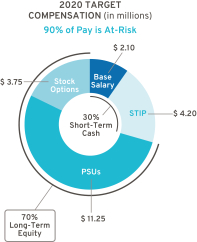
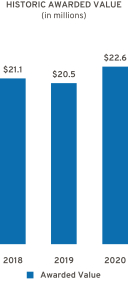
Awarded Value reflects the amount included in the Summary Compensation Table, excluding change in pension value and all other compensation.
 Represents ESG Results
Represents ESG Results
 | 57 |
| u | Compensation Decisions for Paul A. Jacobson |
Executive Vice President and Chief Financial Officer
| Mr. Jacobson was named Executive Vice President and Chief Financial Officer effective December 1, 2020. He is helping the Company accelerate mission-critical growth initiatives, like EV and AV investments, and leading the strategy that invests in new and existing businesses to drive strong, profitable growth with solid return on investment. By leveraging the strength of our core business, Mr. Jacobson is helping fund a new chapter at GM that is electric, connected, sustainable, inclusive, and focused on growth.
By the end of 2020, the Company had repaid the remaining balance on our corporate revolving credit draw and fulfilled the strategic decisions made in 2018 to accelerate the business transformation by strengthening the core business, capitalizing on the future of mobility, and driving cost efficiencies, realizing $4.5 billion in cost savings, inclusive of $200 million of savings related to the wind-down of Holden and sale of our Thailand business.
|
| ||
The Compensation Committee made the following pay decisions based on performance, competitive market data, and feedback from its independent compensation consultant and management:
Base Salary – Effective December 1, 2020, upon Mr. Jacobson’s hiring, set base salary at $1,000,000.
Short-Term Incentive – Awarded 25 points. Final 2020 STIP award reflects a prorated amount based on the number of months Mr. Jacobson was with the Company during 2020.
Long-Term Incentive – In December 2020, awarded an annual LTIP grant of $2.1 million, consisting of 75% PSUs and 25% Stock Options. And, in December 2020, awarded a one-time RSU grant of $2.5 million to replace shares forfeited at his previous employer.
Total awarded compensation for 2020, including salary, STIP, and LTIP, is displayed below.
| Pay Element | Majority of Pay Is At-Risk | Awarded Value | ||||
Base Salary | Only Fixed Pay Element |
| $83,333 |
| ||
STIP | Performance to Metrics |
| $88,600 |
| ||
PSUs(1) | Performance to Metrics and Stock Price |
| $1,975,103 |
| ||
Stock Options | Performance to Stock Price |
| $525,001 |
| ||
RSUs | Performance to Stock Price |
| $2,500,025 |
| ||
TOTAL |
| $5,172,062 |
| |||
| (1) | Value reflects grant date fair value at target performance for Relative ROIC-adjusted awards and reflects the accounting value based on the results from the Monte Carlo analysis for Relative TSR awards. |
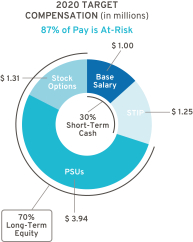
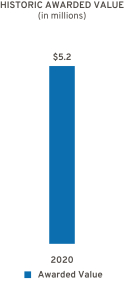
Awarded Value reflects the amount included in the Summary Compensation Table, excluding change in pension value and all other compensation.
| 58 |
|
| u | Compensation Decisions for Mark L. Reuss |
President
| 2020 performance highlights to strategic goals include the following: |
| ||
| Culture & People | ||||
• Exemplified a safety-first culture through our response to COVID-19 by mass producing ventilators, masks, and other personal protective equipment to support global relief efforts | ||||
• Joined as one of 37 founding members of OneTen with the goal of upskilling, hiring, and advancing 1 million Black Americans over the next 10 years into family-sustaining jobs with opportunities for advancement | ||||
• Designated $10 million to support organizations that promote inclusion and racial justice to help root out racism, bigotry, and discrimination | ||||
Transformation | ||||
• Kept GM’s progress towards an all-electric future on track and accelerated EV programs, including the GMC HUMMER EV and Cadillac LYRIQ | ||||
• Announced $2.2 billion investment at Detroit-Hamtramck Assembly, now known as Factory ZERO, to become GM’s first manufacturing facility to be fully dedicated to building EVs | ||||
• Announced $2 billion investment at Spring Hill Assembly to transition the facility to become GM’s third vehicle manufacturing site to produce EVs | ||||
• Announced Ultifi, a reimagined, personalized EV customer experience with a single platform that simplifies discovery, education, and management of GM products and services | ||||
Core Operations | ||||
• Launched all-new lineup of highly profitable full-size SUVs | ||||
• Introduced new brand campaign, Everybody In, our call to action to get everyone in an EV | ||||
• Achieved 42% of GMC’s retail sales in the highly profitable Denali and AT4 trims | ||||
• Established Chevrolet as the fastest-growing full-line brand in the industry | ||||
• Earned Chevrolet’s 32nd NASCAR Cup Series Drivers Championship, more than any other manufacturer, with the 2020 NASCAR Cup Series championship win by Chevrolet driver, Chase Elliott
| ||||
The Compensation Committee made the following pay decisions based on performance, competitive market data, and feedback from its independent compensation consultant and management:
Base Salary – Effective January 1, 2020, increased base salary from $1,200,000 to $1,300,000.
Short-Term Incentive – Awarded 30 points based on results to strategic goals, highlighted above, for the 2020 STIP performance year.
Long-Term Incentive – In February 2020, awarded an annual LTIP grant of $5.95 million, consisting of 75% PSUs and 25% Stock Options. The LTIP award includes an additional $0.25 million above target in recognition of 2019 performance.
Salary Reduction RSUs – Received $65,009 of RSUs.
Total awarded compensation for 2020, including salary, STIP, and LTIP, is displayed below.
Pay Element | Majority of Pay Is At-Risk | Awarded Value | ||||
Base Salary | Only Fixed Pay Element |
| $1,235,000 |
| ||
STIP | Performance to Metrics |
| $1,462,500 |
| ||
PSUs(1) | Performance to Metrics and Stock Price |
| $5,152,198 |
| ||
Stock Options | Performance to Stock Price |
| $1,487,501 |
| ||
RSUs | Performance to Stock Price |
| $65,009 |
| ||
TOTAL |
|
| $9,402,208 |
| ||
| (1) | Value reflects grant date fair value at target performance for Relative ROIC-adjusted awards and reflects the accounting value based on the results from the Monte Carlo analysis for Relative TSR awards. |
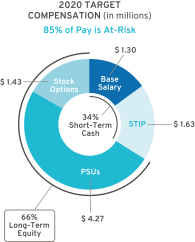
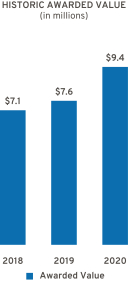
Awarded Value reflects the amount included in the Summary Compensation Table, excluding change in pension value and all other compensation.
 Represents ESG Results
Represents ESG Results
 | 59 |
| u | Compensation Decisions for Douglas L. Parks |
Executive Vice President, Global Product Development, Purchasing and Supply Chain
| 2020 performance highlights to strategic goals include the following: |
| ||
| Culture & People | ||||
• Exemplified a safety-first culture through our response to COVID-19 by mass producing ventilators, masks, and other personal protective equipment to support global relief efforts | ||||
• Responded quickly to shift production to build critical-care ventilators, working with Ventec Life Systems and hundreds of GM suppliers | ||||
• Committed to hire 3,000 new employees across engineering, design, and IT to help transform the future of product development and software as a service | ||||
Transformation | ||||
• Led the development of the GMC HUMMER EV Edition 1, a first-of-its-kind electric supertruck with off-road capability powered by Ultium Drive with up to 1,000 horsepower and 11,500 lb-ft of torque | ||||
• Agreed to jointly develop two all-new EVs for Honda based on Ultium batteries | ||||
• Began joint venture with LG Energy Solution, bringing EVs closer in cost to conventional vehicles | ||||
• Led development in next-generation Ultium battery chemistry, which is expected to enable twice the energy density of batteries in use today and reduce cost by 60% | ||||
• Announced plans to supply Hydrotec fuel cell power cubes to Navistar for use in its production model fuel cell EV | ||||
Core Operations | ||||
• Introduced new safety brand, Periscope, that will advance us towards a world of zero crashes by integrating vehicle technology, research, and advocacy | ||||
• Launched enhanced Super Cruise driver assistance availability on new Vehicle Intelligence Platform with the Cadillac Escalade and announced Super Cruise availability on 22 different models by 2023 | ||||
• Broke ground on new Ultium Cells LLC plant, a nearly 3 million-square-foot plant in Lordstown, Ohio, that will produce millions of battery cells every year
| ||||
The Compensation Committee made the following pay decisions based on performance, competitive market data, and feedback from its independent compensation consultant and management:
Base Salary – Effective August 1, 2020, increased base salary from $775,000 to $850,000.
Short-Term Incentive – Awarded 32 points based on results to strategic goals, highlighted above, for the 2020 STIP performance year.
Long-Term Incentive – In February 2020, awarded an annual LTIP grant of $2.76 million. In October 2020, awarded an additional LTIP grant of $1.33 million. Both grants consisted of 75% PSUs and 25% Stock Options.
Salary Reduction RSUs – Received $38,754 of RSUs.
Total awarded compensation for 2020, including salary, STIP, and LTIP, is displayed below.
Pay Element | Majority of Pay Is At-Risk | Awarded Value | ||||
Base Salary | Only Fixed Pay Element |
| $767,500 |
| ||
STIP | Performance to Metrics |
| $977,500 |
| ||
PSUs(1) | Performance to Metrics and Stock Price |
| $3,504,928 |
| ||
Stock Options | Performance to Stock Price |
| $1,021,888 |
| ||
RSUs | Performance to Stock Price |
| $38,754 |
| ||
TOTAL |
| $6,310,570 |
| |||
| (1) | Value reflects grant date fair value at target performance for Relative ROIC-adjusted awards and reflects the accounting value based on the results from the Monte Carlo analysis for Relative TSR awards. |
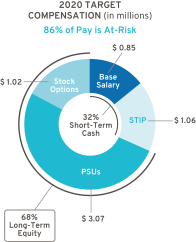
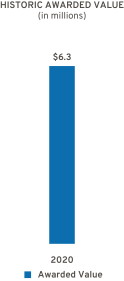
Awarded Value reflects the amount included in the Summary Compensation Table, excluding change in pension value and all other compensation.
 Represents ESG Results
Represents ESG Results
| 60 |
|
| u | Compensation Decisions for Stephen K. Carlisle |
Executive Vice President and President, North America
| 2020 performance highlights to strategic goals include the following: |
| ||
Culture & People | ||||
• Exemplified a safety-first culture through our response to COVID-19 by mass producing ventilators, masks, and other personal protective equipment to support global relief efforts | ||||
• Serves as executive champion of GM PLUS, an Employee Resource Group committed to fostering visibility, empowerment, education, advocacy, recruitment, and retention for LGBTQ and allied employees | ||||
Transformation | ||||
• Accelerated plans for LYRIQ, Cadillac’s first all-electric vehicle, and revealed the GMC HUMMER EV | ||||
• Expanded our customer care initiative through the CLEAN program, a CDC/EPA-approved program with guidelines for safely reopening dealerships | ||||
• Completed power purchase agreement for a 180-megawatt solar project to supply three GM sites with sustainable solar power energy | ||||
Core Operations | ||||
• Achieved year-over-year retail, fleet, and total U.S. market share growth | ||||
• Achieved record U.S. retail average transaction price of $39,356 | ||||
• Achieved highest-ever U.S. retail average transaction price for full-size trucks of $47,559, driven by the Chevrolet Silverado and best full-year retail and total sales ever of the GMC Sierra, with industry-record average transaction prices for LD and HD models | ||||
• Achieved the highest year-over-year share growth in the industry in Canada | ||||
• Announced plans to expand full-size pickup truck production to Oshawa Assembly in early 2022 as part of ratified labor agreement with Unifor | ||||
• Launched all-new line-up of full-size SUVs, including the Cadillac Escalade, 40% of which transacted above $100,000
| ||||
The Compensation Committee made the following pay decisions based on performance, competitive market data, and feedback from its independent compensation consultant and management:
Base Salary – Effective July 15, 2020, upon Mr. Carlisle’s promotion, increased base salary from $700,000 to $800,000.
Short-Term Incentive – Awarded 32 points based on results to strategic goals, highlighted above, for the 2020 STIP performance year.
Long-Term Incentive – In February 2020, awarded an annual LTIP grant of $1.53 million, consisting of 75% PSUs and 25% Stock Options. Upon Mr. Carlisle’s promotion, awarded LTIP grants in October 2020 of $1.97 million, consisting of 75% PSUs and 25% Stock Options, and in December 2020 of $0.3 million consisting of 100% PSUs.
Salary Reduction RSUs – Received $35,007 of RSUs.
Total awarded compensation for 2020, including salary, STIP, and LTIP, is displayed below.
| Pay Element | Majority of Pay Is At-Risk | Awarded Value | ||||
Base Salary | Only Fixed Pay Element |
| $711,136 |
| ||
STIP | Performance to Metrics |
| $920,000 |
| ||
PSUs(1) | Performance to Metrics and Stock Price |
| $3,355,766 |
| ||
Stock Options | Performance to Stock Price |
| $875,009 |
| ||
RSUs | Performance to Stock Price |
| $35,007 |
| ||
TOTAL |
| $5,896,918 |
| |||
| (1) | Value reflects grant date fair value at target performance for Relative ROIC-adjusted awards and reflects the accounting value based on the results from the Monte Carlo analysis for Relative TSR awards. |
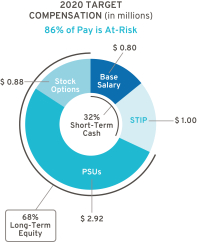
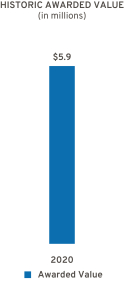
Awarded Value reflects the amount included in the Summary Compensation Table, excluding change in pension value and all other compensation.
 Represents ESG Results
Represents ESG Results
 | 61 |
| u | Compensation Decisions for Dhivya Suryadevara |
Former Executive Vice President and Chief Financial Officer
| Ms. Suryadevara resigned as Executive Vice President and Chief Financial Officer, effective September 1, 2020.
|
| ||
The Compensation Committee made the following pay decisions based on performance, competitive market data, and feedback from its independent compensation consultant and management:
Base Salary – Effective January 1, 2020, increased base salary from $1,000,000 to $1,150,000.
Short-Term Incentive – Ms. Suryadevara did not receive a payout for the 2020 STIP performance year.
Long-Term Incentive – In February 2020, awarded an annual LTIP grant of $4.89 million, consisting of 75% PSUs and 25% Stock Options. The LTIP award includes an additional $0.23 million above target in recognition of 2019 performance. Ms. Suryadevara forfeited all PSUs and Stock Options upon her termination.
Salary Reduction RSUs – Received $57,514 of RSUs. Ms. Suryadevara forfeited a portion of the RSUs upon her termination.
Total awarded compensation for 2020, including salary, STIP, and LTIP, is displayed below.
| Pay Element | Majority of Pay Is At-Risk | Awarded Value | ||||
Base Salary | Only Fixed Pay Element | $718,750 | ||||
STIP | Performance to Metrics | $— | ||||
PSUs(1) | Performance to Metrics and Stock Price | $4,232,180 | ||||
Stock Options | Performance to Stock Price | $1,221,878 | ||||
RSUs | Performance to Stock Price | $57,514 | ||||
TOTAL | $6,230,322 | |||||
| (1) | Value reflects grant date fair value at target performance for Relative ROIC-adjusted awards and reflects the accounting value based on the results from the Monte Carlo analysis for Relative TSR awards. |
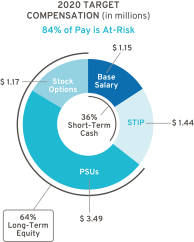
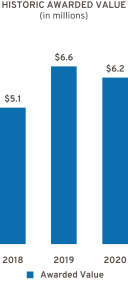
Awarded Value reflects the amount included in the Summary Compensation Table, excluding change in pension value and all other compensation.
| 62 |
|
| u | Compensation Decisions for John P. Stapleton |
Vice President and Chief Financial Officer, North America, and Former Acting Chief Financial Officer
| Mr. Stapleton served as Acting Chief Financial Officer from August 15, 2020, through November 30, 2020.
|
| ||
The Compensation Committee made the following pay decisions based on performance, competitive market data, and feedback from its independent compensation consultant and management:
Base Salary – Effective August 15, 2020, upon Mr. Stapleton’s appointment to Acting Chief Financial Officer, increased base salary to $625,000.
Short-Term Incentive – Awarded 35 points for the 2020 STIP performance year for his integral role in the position of Acting Chief Financial Officer and transitioning the duties of Executive Vice President and Chief Financial Officer from Ms. Suryadevara to Mr. Jacobson.
Long-Term Incentive – In February 2020, awarded an annual LTIP grant of $0.9 million, consisting of 75% PSUs and 25% Stock Options. In October 2020, awarded a one-time PSU grant of $1.0 million to lead the finance organization as the Company searched for a new Chief Financial Officer.
Salary Reduction RSUs – Received $28,163 of RSUs.
Total awarded compensation for 2020, including salary, STIP, and LTIP, is displayed below.
| Pay Element | Majority of Pay Is At-Risk | Awarded Value | ||||
Base Salary | Only Fixed Pay Element | $556,320 | ||||
STIP | Performance to Metrics | $742,200 | ||||
PSUs(1) | Performance to Metrics and Stock Price | $1,899,343 | ||||
Stock Options | Performance to Stock Price | $225,001 | ||||
RSUs | Performance to Stock Price | $28,163 | ||||
TOTAL | $3,451,027 | |||||
| (1) | Value reflects grant date fair value at target performance for Relative ROIC-adjusted awards and reflects the accounting value based on the results from the Monte Carlo analysis for Relative TSR awards. |
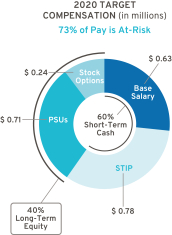
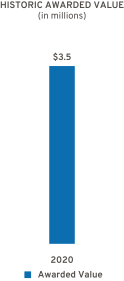
Awarded Value reflects the amount included in the Summary Compensation Table, excluding change in pension value and all other compensation.
 | 63 |
| u | Compensation Decisions for Barry L. Engle II |
Former Executive Vice President and President, North America
| On July 6, 2020, the Company determined that Mr. Engle would leave his position as Executive Vice President and President, North America, and support the transition of his duties and responsibilities to Mr. Carlisle. The Company and Mr. Engle entered into a separation agreement on September 1, 2020, as a qualified termination without cause under the terms of the Executive Severance Program. Mr. Engle is subject to the terms of a one-year non-compete agreement and other standard covenants. For additional details, see page 79 of this Proxy Statement.
|
| ||
The Compensation Committee made the following pay decisions based on performance, competitive market data, and feedback from its independent compensation consultant and management:
Base Salary – Effective January 1, 2020, increased base salary from $800,000 to $850,000.
Short-Term Incentive – Mr. Engle did not receive a payout for the 2020 STIP performance year.
Long-Term Incentive – In February 2020, awarded an annual LTIP grant of $4.24 million, consisting of 75% PSUs and 25% Stock Options. The LTIP award includes an additional $0.15 million above target in recognition of 2019 performance. Mr. Engle forfeited PSUs and Stock Options in accordance with the Executive Severance Program upon his termination.
Salary Reduction RSUs – Received $42,502 of RSUs. Mr. Engle forfeited a portion of the RSUs upon his termination.
Total awarded compensation for 2020, including salary, STIP, and LTIP, is displayed below.
| Pay Element | Majority of Pay Is At-Risk | Awarded Value | ||||
Base Salary | Only Fixed Pay Element | $531,251 | ||||
STIP | Performance to Metrics | $— | ||||
PSUs(1) | Performance to Metrics and Stock Price | $3,669,312 | ||||
Stock Options | Performance to Stock Price | $1,059,378 | ||||
RSUs | Performance to Stock Price | $42,502 | ||||
TOTAL | $5,302,443 | |||||
| (1) | Value reflects grant date fair value at target performance for Relative ROIC-adjusted awards and reflects the accounting value based on the results from the Monte Carlo analysis for Relative TSR awards. |
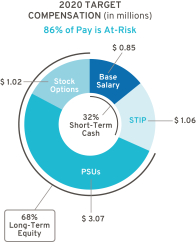
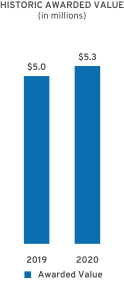
Awarded Value reflects the amount included in the Summary Compensation Table, excluding change in pension value and all other compensation.
| 64 |
|
Compensation Policies and Governance Practices
| u | Stock Ownership Requirements |
The Company requires our senior leaders to own GM stock to align their interests with those of our shareholders. Our stock ownership requirements:
| • | Cover all senior leaders |
| • | Set five years as the time frame to meet ownership requirements |
| • | Require senior leaders to hold vested shares to maintain ownership requirements |
| • | Establish a multiple of each executive’s base salary on the date first covered |
| • | Make it possible to meet ownership requirements by owning either a multiple of base salary in shares or a required number of shares |
| • | Count only actual share holdings and unvested RSUs |
The table below shows the stock ownership requirement by level in the Company. As of December 31, 2020, all NEOs have met or are on track to meet stock ownership requirements by their respective dates.

| u | Compensation Risk Assessment |
The Compensation Committee annually reviews the potential impact of our compensation programs on organizational risk. The Compensation Committee discusses the compensation programs and risk mitigation features when evaluating whether the programs encourage or reward employees for engaging in excessive, imprudent, inappropriate, or unnecessary risk.
The annual risk review, completed on December 7, 2020, with assistance from our human resources, audit, and legal organizations, involved analyzing our current compensation programs in relation to risk. Our analysis concluded that our compensation programs include the following risk mitigation features:
Mix of Pay Elements – Base salary, STIP, PSUs, and Stock Options are included in the executive compensation program, and, for 2020, Salary Reduction RSUs.
Short-Term and Long-Term Programs – The mix of our short-term and long-term compensation programs appropriately reward employees while balancing risk through the delayed payment of long-term awards.
Adjustments to Compensation – Maximum payout caps are in place for incentive compensation, and the Compensation Committee has the ability to apply negative discretion.
Compensation Committee Oversight – Our Compensation Committee reviews plan performance and approves all executive compensation programs and payouts.
Multiple Performance Measures – Multiple performance measures work together to balance risk in our incentive compensation programs.
Stock Ownership Requirements – All senior leaders are subject to stock ownership requirements of at least 1x their salary, as described above.
 | 65 |
Clawback and Cancellation Provisions – All awards are subject to our Policy on Recoupment of Incentive Compensation, as described below. In addition, cancellation provisions apply to all outstanding STIP and LTIP awards.
In 2020, the Compensation Committee determined that our compensation programs have sufficient risk mitigation features and do not encourage or reward employees for engaging in excessive, imprudent, inappropriate, or unnecessary risk. Based on the Compensation Committee’s review, the Committee determined our compensation programs to be low risk.
| u | Policy on Recoupment of Incentive Compensation |
The Compensation Committee approved an Amended and Restated Policy on Recoupment of Incentive Compensation on December 7, 2020 (available on our website at investor.gm.com/resources). The Committee is empowered to recoup (“clawback”) compensation paid to executive officers, and it expanded this capability to include other executives under its purview. In the event of employee misconduct that causes specified financial or reputational damage, a materially inaccurate performance calculation, or an accounting restatement, the Committee may seek to clawback paid incentive compensation. The Committee may also cancel outstanding equity-based awards granted to any covered employee if that employee engages in conduct detrimental to the Company.
Clawback Policy | Cancellation and Non-Solicitation Terms | Cancellation of and Outstanding | ||||
Covered Population | Executive officers and executives under the purview of the Committee | Approximately 275 senior leaders | All employees that receive awards through the STIP or LTIP | |||
Event Applicable | Following employee misconduct that causes specified financial or reputational damage, a materially inaccurate performance calculation, or an accounting restatement, as defined by the policy | Employee violates non-compete or non-solicitation terms | Employee engages in conduct deemed detrimental to the Company | |||
Awards Subject to Cancellation, Forfeiture, and/or Recoupment | STIP, PSUs, RSUs, and Stock Options | PSUs, RSUs, and Stock Options | STIP, PSUs, RSUs, and Stock Options | |||
| u | Trading GM Securities |
Our Insider Trading Policy prohibits our employees from buying or selling GM securities when in possession of material nonpublic information and during other closed periods. Any sale or purchase of common stock by directors, executive officers, and all other senior leaders must be made during pre-established periods after receiving preclearance by a member of the GM Legal Staff or pursuant to a preapproved and pre-established Rule 10b5-1 plan.
Trading in GM derivatives (i.e., puts or calls), engaging in short sales or otherwise engaging in hedging activities, and pledging of GM securities is prohibited for all employees. All executive officers are expected to be in compliance with the Insider Trading Policy and to not hedge nor pledge any shares of GM common stock. This policy is posted on our website at investor.gm.com/resources.
| 66 |
|
| u | Tax Considerations |
The Tax Cuts and Jobs Act enacted on December 22, 2017, modified Internal Revenue Code (“IRC”) Section 162(m) and, among other things, limits the federal tax deduction for annual individual compensation paid up to $1 million for NEOs beginning with the 2018 tax year. Previously, compensation paid in excess of $1 million could be deducted if it was performance-based. The Tax Cuts and Jobs Act includes a transition relief rule in which these changes do not apply to compensation payable pursuant to a written binding contract in effect on November 2, 2017, and is not materially modified after that date. To the extent it is applicable to our existing arrangements, the Compensation Committee may avail itself of this rule. The Committee continues to closely align executive pay with performance, regardless of the performance-based exception being removed under IRC Section 162(m).
| u | Compensation Committee and Consultant Independence |
Our Compensation Committee is composed entirely of independent directors as determined by the Board under NYSE guidelines and as defined for various regulatory purposes. The Compensation Committee was assisted by Frederic W. Cook & Co., Inc. (“FW Cook”) for 2020. FW Cook is an independent compensation consulting firm that takes direction from and is solely responsible to the Compensation Committee. The Compensation Committee is also aided in its deliberations by in-house legal counsel.
Under its charter, the Compensation Committee has the authority to hire outside consultants and advisors at the Company’s expense. The Compensation Committee retains the services of an independent consultant for advice on issues related to the compensation of NEOs and other executive compensation-related matters. A representative from FW Cook attended all Compensation Committee meetings, either in person or via telephone, consulted with and advised the Compensation Committee members on executive compensation, including the structure and amounts of various pay elements, and developed executive benchmarking data. FW Cook does not provide services to the Company’s management.
The Compensation Committee annually reviews the performance of its compensation consultant and considers the following factors when assessing the independence of FW Cook in accordance with NYSE standards:
| • | Services provided to GM management outside the services provided to the Compensation Committee |
| • | Fees paid as a percentage of total revenue |
| • | Policies and procedures designed to prevent conflicts of interest |
| • | Any business or personal relationships between members of the Compensation Committee and FW Cook |
| • | Stock ownership by employees of FW Cook |
| • | Any business or personal relationships between GM and FW Cook |
After reviewing the performance and independence of their consultant, the Compensation Committee determined FW Cook was independent based on the standards above.
| u | Employment and Termination Agreements |
The Company has no employment or pre-defined termination agreements with any of our 2020 NEOs. All NEOs participate in the General Motors LLC U.S. Executive Severance Program filed as an exhibit to the 2020 Form 10-K.
 | 67 |
The Compensation Committee has reviewed and discussed with management the Compensation Discussion and Analysis and, based on that review and discussion, has recommended to the Board of Directors that the Compensation Discussion and Analysis be included in this Proxy Statement and incorporated by reference into the Company’s Annual Report on Form 10-K for the year ended December 31, 2020, as filed with the U.S. Securities and Exchange Commission on February 10, 2021.
Compensation Committee
Carol M. Stephenson (Chair) Wesley G. Bush Joseph Jimenez Patricia F. Russo |
| 68 |
|
| u | Summary Compensation Table |
Name and Principal Position(1) | Year | Salary ($) | Bonus ($) | Stock Awards(2) ($) | Option Awards(3) ($) | Nonequity Incentive Plan Compensation(4) ($) | Change in Pension Value and NQ Deferred Compensation Earnings(5) ($) | All Other Compensation(6) ($) | Total ($) | |||||||||||||||||||||||||||
Mary T. Barra Chairman and Chief Executive Officer | 2020 | 1,995,000 | — | 13,093,722 | 3,750,002 | 3,780,000 | 423,608 | 615,655 | 23,657,987 | |||||||||||||||||||||||||||
| 2019 | 2,100,000 | — | 12,141,801 | 3,525,000 | 2,730,000 | 302,986 | 831,080 | 21,630,867 | ||||||||||||||||||||||||||||
| 2018 | 2,100,000 | — | 11,081,760 | 3,425,006 | 4,452,000 | — | 811,684 | 21,870,450 | ||||||||||||||||||||||||||||
Paul A. Jacobson Executive Vice President and Chief Financial Officer | 2020 | 83,333 | — | 4,475,128 | 525,001 | 88,600 | — | 7,610 | 5,179,672 | |||||||||||||||||||||||||||
Mark L. Reuss President | 2020 | 1,235,000 | — | 5,217,207 | 1,487,501 | 1,462,500 | 333,492 | 227,702 | 9,963,402 | |||||||||||||||||||||||||||
| 2019 | 1,200,000 | — | 4,133,385 | 1,200,000 | 1,050,000 | 250,488 | 348,374 | 8,182,247 | ||||||||||||||||||||||||||||
| 2018 | 1,200,000 | — | 3,276,007 | 1,012,504 | 1,590,000 | — | 277,579 | 7,356,090 | ||||||||||||||||||||||||||||
Douglas L. Parks Executive Vice President, Global Product Development, Purchasing and Supply Chain | 2020 | 767,500 | — | 3,543,682 | 1,021,888 | 977,500 | 260,113 | 163,025 | 6,733,708 | |||||||||||||||||||||||||||
Stephen K. Carlisle Executive Vice President and President, North America | 2020 | 711,136 | — | 3,390,773 | 875,009 | 920,000 | 232,390 | 160,155 | 6,289,463 | |||||||||||||||||||||||||||
Dhivya Suryadevara Former Executive Vice President and Chief Financial Officer | 2020 | 718,750 | — | 4,289,694 | 1,221,878 | — | 995 | 119,622 | 6,350,939 | |||||||||||||||||||||||||||
| 2019 | 1,000,000 | — | 3,659,772 | 1,062,503 | 875,000 | 2,890 | 167,392 | 6,767,557 | ||||||||||||||||||||||||||||
| 2018 | 668,100 | — | 2,446,635 | 796,263 | 1,192,500 | — | 402,592 | 5,506,090 | ||||||||||||||||||||||||||||
John P. Stapleton Vice President and Chief Financial Officer, North America, and Former Acting Chief Financial Officer | 2020 | 556,320 | — | 1,927,506 | 225,001 | 742,200 | 164,734 | 131,040 | 3,746,801 | |||||||||||||||||||||||||||
Barry L. Engle II Former Executive Vice President and President, North America | 2020 | 531,251 | — | 3,711,814 | 1,464,369 | — | — | 2,458,665 | 8,166,099 | |||||||||||||||||||||||||||
| 2019 | 800,000 | — | 2,747,276 | 800,003 | 650,000 | — | 149,005 | 5,146,284 | ||||||||||||||||||||||||||||
| (1) | Titles reflect position as of December 31, 2020. Messrs. Jacobson, Parks, Carlisle, and Stapleton were not NEOs in 2018 or 2019. Mr. Engle was not an NEO in 2018. |
 | 69 |
| (2) | Stock Awards displays the grant date fair value of PSUs and RSUs issued under the LTIP, computed in accordance with Financial Accounting Standards Board (“FASB”) Accounting Standards Codification (“ASC”) Topic 718. PSUs will vest based on GM’s performance against Relative ROIC-adjusted and Relative TSR. The maximum award for PSUs for the 2020–2022 performance period is 200% of PSUs granted. The assumptions used for the Monte Carlo valuation of the Relative TSR portion of the PSUs are summarized below: |
| Grant Date | Stock Price | Implied Volatility | Risk-Free Interest Rate | Valuation Price | Valuation Price as a Percent of Target | |||||
| 2/12/2020 | $35.49 | 25% | 1.42% | $46.46 | 130.9% | |||||
| 10/1/2020 | $30.38 | 45% | 0.15% | $37.67 | 124.0% | |||||
| 12/1/2020 | $44.68 | 42% | 0.17% | $67.38 | 150.8% | |||||
There is no dividend yield as dividends are assumed to be reinvested for the TSR calculation. The table below shows the PSUs valued based on the closing stock price on the date of grant and the maximum grant value based on maximum performance. Upon their terminations, Ms. Suryadevara and Mr. Engle forfeited all PSUs and a portion of the Salary Reduction RSUs. |
| Value of PSU Awards at Target and Maximum Performance | ||||||||
|
| 2020 Target ($) | 2020 Maximum ($) | ||||||
Mary T. Barra | 11,250,011 | 22,500,022 | ||||||
Paul A. Jacobson | 1,575,015 | 3,150,030 | ||||||
Mark L. Reuss | 4,462,513 | 8,925,026 | ||||||
Douglas L. Parks | 3,065,650 | 6,131,300 | ||||||
Stephen K. Carlisle | 2,925,066 | 5,850,132 | ||||||
Dhivya Suryadevara | 3,665,656 | 7,331,312 | ||||||
John P. Stapleton | 1,675,038 | 3,350,076 | ||||||
Barry L. Engle II | 3,178,130 | 6,356,260 | ||||||
| (3) | Option Awards displays the grant date fair value of Stock Options issued under the LTIP, computed in accordance with FASB ASC Topic 718 using a Black-Scholes valuation. The assumptions used for the Black-Scholes valuation of the Stock Options are summarized below: |
| Grant Date | Dividend Yield | Implied Volatility | Risk-Free Interest Rate | Expected Option Life | Grant Date Fair Value | |||||
| 2/12/2020 | 4.28% | 25% | 1.50% | 6.00 years | $5.04 | |||||
| 10/1/2020 | 1.94% | 44% | 0.30% | 5.37 years | $9.96 | |||||
| 12/1/2020 | 2.00% | 42% | 0.45% | 5.20 years | $13.83 | |||||
For Mr. Engle, the amount also reflects the incremental fair value computed in accordance with FASB ASC Topic 718 as of July 6, 2020, associated with modifications made to certain option awards in connection with the separation agreement, totaling $404,991. Upon their terminations, Ms. Suryadevara forfeited all Stock Options, and Mr. Engle forfeited a portion of the Stock Options. |
| (4) | All NEOs were eligible for a payment under the STIP for 2020 performance based on the Company’s achievement of annual performance goals and individual performance. Individual performance decisions for each NEO are determined by the Compensation Committee; results are discussed beginning on page 57 of this Proxy Statement. Mr. Jacobson received a prorated STIP award based on the number of months he was with the Company in 2020. Ms. Suryadevara and Mr. Engle did not receive a STIP payout due to their departures from the Company. |
| (5) | These amounts represent the actuarial change in the present value of the NEO’s accrued benefit for 2020 attributed to year-over-year variances in applicable discount rates, lump sum interest rates, mortality rates, and employer contributions to tax-qualified and non-tax-qualified plans, as described in “Pension Benefits” on page 76 of this Proxy Statement. The Company does not credit interest at above-market rates to any deferred retirement accounts, and no interest amounts are included in these totals. Mr. Jacobson and Mr. Engle are not eligible for DB pension plans. |
| (6) | The amounts included as All Other Compensation are described in the table below. |
| 70 |
|
All Other Compensation
|
| M. T. Barra ($) | P. A. ($) | M. L. Reuss ($) | D. L. ($) | S. K. ($) | D. ($) | J. P. ($) | B. L. ($) | ||||||||||||||||||||||||
Perquisites and Other Personal Benefits(1) | 235,587 | 943 | 31,077 | 27,212 | 20,435 | 24,458 | 27,007 | 29,894 | ||||||||||||||||||||||||
Employer Contributions to Savings Plans(2) | 363,300 | 6,667 | 186,500 | 129,700 | 134,114 | 92,500 | 100,356 | 68,500 | ||||||||||||||||||||||||
Life and Other Insurance Benefits(3) | 13,735 | — | 8,247 | 4,994 | 4,584 | 1,578 | 2,864 | 3,588 | ||||||||||||||||||||||||
Other(4)(5) | 3,033 | — | 1,878 | 1,119 | 1,022 | 1,086 | 813 | 2,356,683 | ||||||||||||||||||||||||
TOTAL | 615,655 | 7,610 | 227,702 | 163,025 | 160,155 | 119,622 | 131,040 | 2,458,665 | ||||||||||||||||||||||||
| (1) | The amounts included as Perquisites and Other Personal Benefits are described in the table below. |
| (2) | Includes employer contributions to tax-qualified and non-tax-qualified savings and retirement plans during 2020. |
| (3) | Includes premiums paid by the Company for Group Variable Universal Life insurance for executives. Executives are responsible for any ordinary income taxes resulting from the cost of the GM-paid premiums. For Ms. Barra, amounts also include the Company’s cost of premiums for providing personal accident insurance for members of the Board. |
| (4) | Reflects interest paid on repayment of the salary deferral discussed on page 55 of this Proxy Statement. |
| (5) | Reflects Mr. Engle’s payment upon separation pursuant to the terms of the Executive Severance Program. For additional details, see page 79 of this Proxy Statement. |
Perquisites and Other Personal Benefits
|
| M. T. ($) | P. A. ($) | M. L. ($) | D. L. ($) | S. K. ($) | D. ($) | J. P. ($) | B. L. ($) | ||||||||||||||||||||||||
Personal Travel(1) | 158,199 | — | — | — | — | — | — | — | ||||||||||||||||||||||||
Security(2) | 39,767 | — | 2,694 | — | — | — | — | — | ||||||||||||||||||||||||
Company Vehicle Programs(3) | 23,650 | 943 | 14,412 | 13,241 | 6,464 | 15,137 | 15,001 | 16,803 | ||||||||||||||||||||||||
Executive Physical(4) | 4,650 | — | 4,650 | 4,650 | 4,650 | — | 4,650 | 4,650 | ||||||||||||||||||||||||
Financial Counseling(5) | 9,321 | — | 9,321 | 9,321 | 9,321 | 9,321 | 7,356 | 8,441 | ||||||||||||||||||||||||
Other(6) | — | — | — | — | — | — | — | — | ||||||||||||||||||||||||
TOTAL | 235,587 | 943 | 31,077 | 27,212 | 20,435 | 24,458 | 27,007 | 29,894 | ||||||||||||||||||||||||
| (1) | Personal travel, pursuant to Company policy as discussed on page 49 of this Proxy Statement, includes incremental costs (fuel, flight crew expenses, landing fees, ground transportation fees, and other miscellaneous variable expenses) associated with aircraft use. Ms. Barra serves on outside boards, which we view as directly and integrally related to her role as Chairman and CEO and her professional development. The cost of travel to outside boards for 2020 was $40,917 and is excluded from the amount above. |
| (2) | Amounts include the incremental cost of providing security services and residential security system monitoring for Ms. Barra and Mr. Reuss as recommended by an independent third-party security consultant. For security personnel employed by the Company, the cost is the actual incremental cost of expenses incurred by the security personnel. Total salary, wages, and benefits are not allocated, as the Company already incurs these costs for business purposes. |
| (3) | Includes the cost of providing cars, drivers, and the estimated annual lease value of the Company vehicles, inclusive of fuel and insurance, driven by NEOs. The annual lease value is included because it is more reflective of the value of the Company vehicle perquisite than of the Company’s incremental costs, which are generally significantly lower because the Company manufactures and ordinarily disposes of Company vehicles for a profit, resulting in minimal incremental costs, if any. Taxes related to imputed income are the responsibility of each participant. |
 | 71 |
| (4) | Costs associated with executive physicals with our approved provider. |
| (5) | Costs associated with financial counseling and estate planning services with our approved provider. |
| (6) | Occasionally, unused tickets from sponsorship agreements are made available for personal use. Tickets are included in sponsorship agreements and typically result in no incremental costs to the Company. In 2020, there were no incremental costs associated with the personal use of tickets to GM-sponsored events. Occasionally, limited souvenirs may be included as part of a sponsorship agreement and no incremental costs are incurred by the Company. |
| u | Grants of Plan–Based Awards |
STIP awards for the 2020 performance year were made under the terms of the 2017 STIP. Equity awards granted to each NEO prior to June 17, 2020, were under the terms of the 2017 LTIP, grants made on or after June 17, 2020, were under the terms of the 2020 LTIP. PSUs vest and deliver at the end of the performance period and will be earned at a level between 0% and 200% of target. PSUs are based on the achievement of performance conditions relating to Relative ROIC-adjusted and Relative TSR over a three-year performance period from January 1, 2020, to December 31, 2022. Stock Options vest ratably over a three-year period. The Salary Reduction RSUs granted on May 7, 2020, were intended to replace the NEOs’ cash salary for a period of six months, and vested and settled on April 1, 2021, prorated for service. The RSUs granted to Mr. Jacobson on December 1, 2020, replace certain awards forfeited by his previous employer. Fifty percent of his RSUs will vest on December 1, 2022, and the balance will vest on December 1, 2023, which aligns with the vesting schedule of awards forfeited at his previous employer.
|
|
|
|
|
Estimated Future Payouts Under Non-Equity Incentive Plan Awards | Estimated Future Payouts Under Equity Incentive Plan Awards | All Other Stock Awards: Number of Shares of Stock or Units (#) | All Other Option Awards: Number of Securities Underlying Options (#) | Exercise or Base Price of Option Awards ($/share) | Grant Date Fair Value of Stock and Option Awards($)(1) | |||||||||||||||||||||||||||||||||||||||||||
| Name | Award Type | Grant Date | Approval Date |
Threshold ($) |
Target ($) |
Maximum ($) |
Threshold (#) |
Target (#) |
Maximum (#) | |||||||||||||||||||||||||||||||||||||||||||
Mary T. Barra | STIP | 1/1/2020 | 12/9/2019 | 262,500 | 4,200,000 | 8,400,000 | ||||||||||||||||||||||||||||||||||||||||||||||
| Options | 2/12/2020 | 12/9/2019 | 744,048 | 35.49 | 3,750,002 | |||||||||||||||||||||||||||||||||||||||||||||||
| PSU | 2/12/2020 | 12/9/2019 | 79,248 | 316,991 | 633,982 | 12,988,702 | ||||||||||||||||||||||||||||||||||||||||||||||
| RSU | 5/7/2020 | 3/25/2020 | 4,680 | 105,020 | ||||||||||||||||||||||||||||||||||||||||||||||||
Paul A. Jacobson | STIP | 12/1/2020 | 10/16/2020 | 78,125 | 1,250,000 | 2,500,000 | ||||||||||||||||||||||||||||||||||||||||||||||
| Options | 12/1/2020 | 10/16/2020 | 37,961 | 44.68 | 525,001 | |||||||||||||||||||||||||||||||||||||||||||||||
| PSU | 12/1/2020 | 10/16/2020 | 8,813 | 35,251 | 70,502 | 1,975,103 | ||||||||||||||||||||||||||||||||||||||||||||||
| RSU | 12/1/2020 | 10/16/2020 | 55,954 | 2,500,025 | ||||||||||||||||||||||||||||||||||||||||||||||||
Mark L. Reuss | STIP | 1/1/2020 | 12/9/2019 | 101,563 | 1,625,000 | 3,250,000 | ||||||||||||||||||||||||||||||||||||||||||||||
| Options | 2/12/2020 | 12/9/2019 | 295,139 | 35.49 | 1,487,501 | |||||||||||||||||||||||||||||||||||||||||||||||
| PSU | 2/12/2020 | 12/9/2019 | 31,435 | 125,740 | 251,480 | 5,152,198 | ||||||||||||||||||||||||||||||||||||||||||||||
| RSU | 5/7/2020 | 3/25/2020 | 2,897 | 65,009 | ||||||||||||||||||||||||||||||||||||||||||||||||
Douglas L. Parks | STIP | 1/1/2020 | 12/9/2019 | 66,407 | 1,062,500 | 2,125,000 | ||||||||||||||||||||||||||||||||||||||||||||||
| Options | 2/12/2020 | 12/9/2019 | 136,717 | 35.49 | 689,054 | |||||||||||||||||||||||||||||||||||||||||||||||
| Options | 10/1/2020 | 8/10/2020 | 33,417 | 30.38 | 332,834 | |||||||||||||||||||||||||||||||||||||||||||||||
| PSU | 2/12/2020 | 12/9/2019 | 14,562 | 58,246 | 116,492 | 2,386,631 | ||||||||||||||||||||||||||||||||||||||||||||||
| PSU | 10/1/2020 | 8/10/2020 | 8,217 | 32,867 | 65,734 | 1,118,297 | ||||||||||||||||||||||||||||||||||||||||||||||
| RSU | 5/7/2020 | 3/25/2020 | 1,727 | 38,754 | ||||||||||||||||||||||||||||||||||||||||||||||||
Stephen K. Carlisle | STIP | 1/1/2020 | 12/9/2019 | 62,500 | 1,000,000 | 2,000,000 | ||||||||||||||||||||||||||||||||||||||||||||||
| Options | 2/12/2020 | 12/9/2019 | 75,645 | 35.49 | 381,251 | |||||||||||||||||||||||||||||||||||||||||||||||
| Options | 10/1/2020 | 8/10/2020 | 49,574 | 30.38 | 493,758 | |||||||||||||||||||||||||||||||||||||||||||||||
| PSU | 2/12/2020 | 12/9/2019 | 8,057 | 32,228 | 64,456 | 1,320,543 | ||||||||||||||||||||||||||||||||||||||||||||||
| PSU | 10/1/2020 | 8/10/2020 | 12,190 | 48,758 | 97,516 | 1,658,992 | ||||||||||||||||||||||||||||||||||||||||||||||
| PSU | 12/1/2020 | 11/5/2020 | 1,679 | 6,715 | 13,430 | 376,231 | ||||||||||||||||||||||||||||||||||||||||||||||
| RSU | 5/7/2020 | 3/25/2020 | 1,560 | 35,007 | ||||||||||||||||||||||||||||||||||||||||||||||||
| 72 |
|
|
|
|
|
|
Estimated Future Payouts Under Non-Equity Incentive Plan Awards | Estimated Future Payouts Under Equity Incentive Plan Awards | All Other Stock Awards: Number of Shares of Stock or Units (#) | All Other Option Awards: Number of Securities Underlying Options (#) | Exercise or Base Price of Option Awards ($/share) | Grant Date Fair Value of Stock and Option Awards($)(1) | |||||||||||||||||||||||||||||||||||||||||||
| Name | Award Type | Grant Date | Approval Date |
Threshold ($) |
Target ($) |
Maximum ($) |
Threshold (#) |
Target (#) |
Maximum (#) | |||||||||||||||||||||||||||||||||||||||||||
Dhivya Suryadevara | STIP | 1/1/2020 | 12/9/2019 | 89,844 | 1,437,500 | 2,875,000 | ||||||||||||||||||||||||||||||||||||||||||||||
|
Options |
(2) |
|
2/12/2020 |
|
|
12/9/2019 |
|
|
242,436 |
|
|
35.49 |
|
|
1,221,878 |
| |||||||||||||||||||||||||||||||||||
| PSU | (2) | 2/12/2020 | 12/9/2019 | 25,822 | 103,287 | 206,574 | 4,232,180 | |||||||||||||||||||||||||||||||||||||||||||||
| RSU | (2) | 5/7/2020 | 3/25/2020 | 2,563 | 57,514 | |||||||||||||||||||||||||||||||||||||||||||||||
John P. Stapleton | STIP | 1/1/2020 | 12/9/2019 | 48,832 | 781,300 | 1,562,600 | ||||||||||||||||||||||||||||||||||||||||||||||
|
Options |
|
|
2/12/2020 |
|
|
12/9/2019 |
|
|
44,643 |
|
|
35.49 |
|
|
225,001 |
| |||||||||||||||||||||||||||||||||||
| PSU | 2/12/2020 | 12/9/2019 | 4,755 | 19,020 | 38,040 | 779,345 | ||||||||||||||||||||||||||||||||||||||||||||||
| PSU | 10/1/2020 | 8/10/2020 | 8,229 | 32,917 | 65,834 | 1,119,998 | ||||||||||||||||||||||||||||||||||||||||||||||
| RSU | 5/7/2020 | 3/25/2020 | 1,255 | 28,163 | ||||||||||||||||||||||||||||||||||||||||||||||||
Barry L. Engle II | STIP | 1/1/2020 | 12/9/2019 | 66,407 | 1,062,500 | 2,125,000 | ||||||||||||||||||||||||||||||||||||||||||||||
| Options | (3) | 2/12/2020 | 12/9/2019 | 210,194 | 35.49 | 1,059,378 | ||||||||||||||||||||||||||||||||||||||||||||||
| PSU | (3) | 2/12/2020 | 12/9/2019 | 22,388 | 89,550 | 179,100 | 3,669,312 | |||||||||||||||||||||||||||||||||||||||||||||
| RSU | (3) | 5/7/2020 | 3/25/2020 | 1,894 | 42,502 | |||||||||||||||||||||||||||||||||||||||||||||||
| Options | (4) | 7/6/2020 | 70,065 | 35.49 | 80,575 | |||||||||||||||||||||||||||||||||||||||||||||||
| Options | (4) | 7/6/2020 | 20,966 | 37.76 | 18,136 | |||||||||||||||||||||||||||||||||||||||||||||||
| Options | (4) | 7/6/2020 | 53,334 | 39.00 | 43,201 | |||||||||||||||||||||||||||||||||||||||||||||||
| Options | (4) | 7/6/2020 | 66,426 | 41.40 | 42,513 | |||||||||||||||||||||||||||||||||||||||||||||||
| Options | (4) | 7/6/2020 | 78,750 | 34.34 | 67,725 | |||||||||||||||||||||||||||||||||||||||||||||||
| Options | (4) | 7/6/2020 | 151,327 | 30.67 | 152,841 | |||||||||||||||||||||||||||||||||||||||||||||||
| (1) | This column shows the aggregate grant date fair value of equity awards granted to the NEOs in 2020. The aggregate grant date fair value is the amount that the Company expects to expense in its financial statements over the vesting schedule. All grant date fair values have been computed in accordance with FASB ASC Topic 718. |
| (2) | Upon her termination, Ms. Suryadevara forfeited all Stock Options, PSUs, and a portion of the Salary Reduction RSUs. |
| (3) | Upon his termination, Mr. Engle forfeited a portion of the Stock Options, all PSUs, and a portion of the Salary Reduction RSUs. |
| (4) | The grant date fair value for Stock Options on July 6, 2020, represents the incremental fair value computed in accordance with FASB ASC Topic 718 associated with modifications made to previously granted Stock Option awards granted under the 2017 LTIP in connection with the separation agreement, which provided for an extended exercise period. The previously granted Stock Options include, listed in the order in which they are disclosed, Stock Options granted on February 12, 2020; April 1, 2019; February 13, 2019; February 13, 2018; June 7, 2017; and October 1, 2015. |
 | 73 |
| u | Outstanding Equity Awards at Fiscal Year-End |
| Option Awards | Stock Awards(1) | |||||||||||||||||||||||||||||||||||
| Name | Grant Date | Number of Securities Underlying Unexercised Options Exercisable (#) | Number of Securities Underlying Unexercised Options Unexercisable (#) | Option Exercise Price ($) | Option Expiration Date | Number of Shares or Units of Stock That Have Not Vested (#) | Market Value of Shares or Units of Stock That Have Not Vested ($) | Equity Incentive Plan Awards: Number of Unearned Shares, Units, or Other Rights That Have Not Vested (#) | Equity Incentive Plan Awards: Market or Payout Value of Unearned Shares, Units, or Other Rights That Have Not Vested ($) | |||||||||||||||||||||||||||
Mary T. Barra | 5/7/2020 | 4,680 | (6) | 194,875 | ||||||||||||||||||||||||||||||||
| 2/12/2020 | — | 744,048 | (2) | 35.49 | 2/12/2030 | 316,991 | (10)(11) | 13,199,505 | (11) | |||||||||||||||||||||||||||
| 2/13/2019 | 156,667 | 313,333 | (3) | 39.00 | 2/13/2029 | 271,154 | (10)(11) | 11,290,853 | (11) | |||||||||||||||||||||||||||
| 2/13/2018 | 275,765 | 137,883 | (4) | 41.40 | 2/11/2028 | 464,114 | (9) | 19,325,707 | ||||||||||||||||||||||||||||
Paul A. Jacobson | 12/1/2020 | — | 37,961 | (2) | 44.68 | 2/12/2030 | 55,954 | (7) | 2,329,925 | 35,251 | (10)(11) | 1,467,852 | (11) | |||||||||||||||||||||||
Mark L. Reuss | 5/7/2020 | 2,897 | (6) | 120,631 | ||||||||||||||||||||||||||||||||
| 2/12/2020 | — | 295,139 | (2) | 35.49 | 2/12/2030 | 125,740 | (10)(11) | 5,235,814 | (11) | |||||||||||||||||||||||||||
| 2/13/2019 | 53,334 | 106,666 | (3) | 39.00 | 2/13/2029 | 92,308 | (10)(11) | 3,843,705 | (11) | |||||||||||||||||||||||||||
| 2/13/2018 | 81,522 | 40,761 | (4) | 41.40 | 2/11/2028 | 137,202 | (9) | 5,713,091 | ||||||||||||||||||||||||||||
Douglas L. Parks | 10/1/2020 | — | 33,417 | (2) | 30.38 | 2/12/2030 | 32,867 | (10)(11) | 1,368,582 | (11) | ||||||||||||||||||||||||||
| 5/7/2020 | 1,727 | (6) | 71,912 | |||||||||||||||||||||||||||||||||
| 2/12/2020 | — | 136,717 | (2) | 35.49 | 2/12/2030 | 58,246 | (10)(11) | 2,425,363 | (11) | |||||||||||||||||||||||||||
| 2/13/2019 | 8,167 | 16,333 | (3) | 39.00 | 2/13/2029 | 14,135 | (10)(11) | 588,581 | (11) | |||||||||||||||||||||||||||
| 2/13/2018 | 14,795 | 7,398 | (4) | 41.40 | 2/11/2028 | 24,901 | (9) | 1,036,878 | ||||||||||||||||||||||||||||
Stephen K. Carlisle | 12/1/2020 | 6,715 | (10)(11) | 279,613 | (11) | |||||||||||||||||||||||||||||||
| 10/1/2020 | — | 49,574 | (2) | 30.38 | 2/12/2030 | 48,758 | (10)(11) | 2,030,283 | (11) | |||||||||||||||||||||||||||
| 5/7/2020 | 1,560 | (6) | 64,958 | |||||||||||||||||||||||||||||||||
| 2/12/2020 | — | 75,645 | (2) | 35.49 | 2/12/2030 | 32,228 | (10)(11) | 1,341,974 | (11) | |||||||||||||||||||||||||||
| 2/13/2019 | 15,278 | 30,556 | (3) | 39.00 | 2/13/2029 | 26,443 | (10)(11) | 1,101,087 | (11) | |||||||||||||||||||||||||||
| 7/2/2018 | 12,377 | 6,188 | (4) | 39.50 | 2/11/2028 | 18,643 | (9) | 776,295 | ||||||||||||||||||||||||||||
| 2/13/2018 | 16,204 | 8,102 | (4) | 41.40 | 2/11/2028 | 27,273 | (9) | 1,135,648 | ||||||||||||||||||||||||||||
Dhivya Suryadevara | 5/7/2020 | 2,136 | (6) | 88,943 | ||||||||||||||||||||||||||||||||
John P. Stapleton | 10/1/2020 | 32,917 | (10)(11) | 1,370,664 | (11) | |||||||||||||||||||||||||||||||
| 5/7/2020 | 1,255 | (6) | 52,258 | |||||||||||||||||||||||||||||||||
| 2/12/2020 | 44,643 | (2) | 35.49 | 2/12/2030 | 19,020 | (10)(11) | 791,993 | (11) | ||||||||||||||||||||||||||||
| 2/13/2019 | 10,000 | 20,000 | (3) | 39.00 | 2/13/2029 | 17,308 | (10)(11) | 720,705 | (11) | |||||||||||||||||||||||||||
| 10/1/2018 | 17,544 | (8) | 730,532 | |||||||||||||||||||||||||||||||||
| 2/13/2018 | 14,795 | 7,398 | (4) | 41.40 | 2/11/2028 | 24,901 | (9) | 1,036,878 | ||||||||||||||||||||||||||||
Barry L. Engle II | 7/6/2020 | 70,065 | (5)(12) | 35.49 | 8/31/2021 | |||||||||||||||||||||||||||||||
| 7/6/2020 | 10,482 | 10,483 | (5)(12) | 37.76 | 8/31/2021 | |||||||||||||||||||||||||||||||
| 7/6/2020 | 26,667 | 26,667 | (5)(12) | 39.00 | 8/31/2021 | |||||||||||||||||||||||||||||||
| 7/6/2020 | 44,284 | 22,142 | (5)(12) | 41.40 | 8/31/2021 | |||||||||||||||||||||||||||||||
| 5/7/2020 | 1,579 | (6) | 65,750 | |||||||||||||||||||||||||||||||||
| 2/13/2018 | 74,531 | (9)(12) | 3,103,471 | |||||||||||||||||||||||||||||||||
| (1) | The awards are valued based on the closing price of common stock on the NYSE on December 31, 2020, which was $41.64. |
| (2) | Stock Options granted on February 12, 2020, October 1, 2020, and December 1, 2020, vest ratably each February 12 of 2021, 2022, and 2023. |
| (3) | Stock Options granted on February 13, 2019, vest ratably each February 13 of 2020, 2021, and 2022. |
| (4) | Stock Options granted on February 13, 2018, and July 2, 2018, vest ratably each February 13 of 2019, 2020, and 2021. |
| 74 |
|
| (5) | Stock Options with a grant date of July 6, 2020, represent outstanding Stock Option awards granted under the 2017 LTIP that were modified in connection with the separation agreement, which provided for an extended exercise period. Listed in the order in which they are disclosed, the outstanding Stock Options vest on February 12, 2021, February 13, 2021, February 13, 2021, and February 13, 2021. |
| (6) | RSU awards granted on May 7, 2020, vest and settle on April 1, 2021, prorated for service. |
| (7) | RSU awards granted to Mr. Jacobson on December 1, 2020, vest ratably each December 1 of 2022 and 2023. |
| (8) | RSU awards granted to Mr. Stapleton on October 1, 2018, cliff-vest on October 1, 2021. |
| (9) | 2018-2020 PSU awards granted on February 13, 2018, and July 2, 2018, cliff-vested on February 13, 2021, upon determination of results for the performance period January 1, 2018–December 31, 2020. The final performance of the 2018–2020 PSU award was 187% and is discussed on page 55 of this Proxy Statement. |
| (10) | 2020-2022 PSU awards granted on February 12, 2020, October 1, 2020, and December 1, 2020, cliff-vest on February 12, 2023, upon determination of results for the performance period January 1, 2020–December 31, 2022. 2019-2021 PSU awards granted on February 13, 2019, cliff-vest on February 13, 2022, upon determination of results for the performance period January 1, 2019–December 31, 2021. |
| (11) | Assumes target-level payout of PSU awards. The number of shares (and market value of such shares) for maximum-level payout with respect to unvested 2019–2021 PSUs granted on February 13, 2019, outstanding as of December 31, 2020, for Ms. Barra is 542,308 ($22,581,705); for Mr. Reuss is 184,616 ($7,687,410); for Mr. Parks is 28,270 ($1,177,163); for Mr. Carlisle is 52,886 ($2,202,173); and for Mr. Stapleton is 34,616 ($1,441,410). The number of shares (and market value of such shares) for maximum-level payout with respect to unvested 2020–2022 PSUs granted on February 12, 2020, outstanding as of December 31, 2020, for Ms. Barra is 633,982 ($26,399,010); for Mr. Reuss is 251,480 ($10,471,627); for Mr. Parks is 116,492 ($4,850,727); for Mr. Carlisle is 64,456 ($2,683,948); and for Mr. Stapleton is 38,040 ($1,583,986). The number of shares (and market value of such shares) for maximum-level payout with respect to unvested 2020–2022 PSUs granted on October 1, 2020, outstanding as of December 31, 2020, for Mr. Parks is 65,734 ($2,737,164); for Mr. Carlisle is 97,516 ($4,060,566); and for Mr. Stapleton is 65,834 ($2,741,328). The number of shares (and market value of such shares) for maximum-level payout with respect to unvested 2020–2022 PSUs granted on December 1, 2020, outstanding as of December 31, 2020, for Mr. Jacobson is 70,502 ($2,935,703); and for Mr. Carlisle is 13,430 ($559,225). |
| (12) | Awards will be cash-settled pursuant to the terms of the Executive Severance Program. |
| u | Option Exercises and Stock Vested |
| Option Awards(1) | Stock Awards(2) | |||||||||||||||
| Name | Number of Shares Acquired on | Value Realized on Exercise ($) | Number of Shares Acquired on Vesting (#) | Value Realized on Vesting ($) | ||||||||||||
Mary T. Barra | 1,600,000 | 17,890,924 | 460,797 | 16,017,304 | ||||||||||||
Paul A. Jacobson | — | — | — | — | ||||||||||||
Mark L. Reuss | 165,943 | 1,287,280 | 143,557 | 4,990,041 | ||||||||||||
Douglas L. Parks | — | — | 43,848 | 1,447,642 | ||||||||||||
Stephen K. Carlisle | 10,217 | 117,812 | 28,535 | 991,877 | ||||||||||||
Dhivya Suryadevara | 279,195 | 361,557 | 26,054 | 905,637 | ||||||||||||
John P. Stapleton | — | — | 26,054 | 905,637 | ||||||||||||
Barry L. Engle II | 311,510 | 1,565,593 | 55,606 | 1,932,865 | ||||||||||||
| (1) | The aggregate dollar value realized upon exercise is computed by multiplying the number of shares at exercise by the difference between the market price of common stock and the exercise price of the options. |
| (2) | The aggregate dollar value realized upon vesting is computed by multiplying the number of shares vested by the closing stock price on the vesting date. |
 | 75 |
| u | Pension Benefits |
GM Salaried Retirement Plan
Eligibility and Vesting: The GM Salaried Retirement Plan (“SRP”) is a funded, tax-qualified retirement program that covers eligible employees hired prior to January 1, 2007. Employees who commenced service on or after January 1, 2007, are eligible to participate only in DC plans. Employees are vested in the SRP after five years of qualifying service. The plan permitted employee contributions, which vested immediately, until December 31, 2006. All DB accruals were frozen on September 30, 2012, with service continuing towards eligibility to retire.
Benefit Formula:
Service Prior to January 1, 2001: The plan provided benefits on both a contributory and noncontributory formula. The contributory formula factors the contributions of the employee and earnings for each fiscal year. The formulas were frozen effective December 31, 2006, and effective January 1, 2007, employees continued to participate in the SRP under a new formula that provided a pension accrual equal to 1.25% of the employee’s eligible earnings up to the IRS-prescribed limits for tax-qualified plans. The 1.25% accruals were frozen September 30, 2012.
Service from January 1, 2001, to December 31, 2006: The plan provided benefits under a cash balance formula with pay credits based on age through December 31, 2006, when the formula was frozen, with balances continuing to earn interest credits thereafter.
Time and Form of Payment: For employees hired prior to January 1, 2001, the accumulated benefit an employee earns over his or her career with the Company is payable starting after retirement. Normal retirement age is defined as age 65. Employees who commenced service prior to 1988 may elect early retirement after 30 years of credited service or 85 points, based on combined age and service, or age 60 and 10 or more years of service, with certain age-reduction factors applied. As of December 31, 2020, Ms. Barra and Messrs. Reuss, Parks, Carlisle, and Stapleton were eligible for early retirement. The plan also provides Social Security supplements for those hired prior to 1988. For employees hired on or after January 1, 1988, and prior to December 31, 2000, Social Security supplements are not payable and age-reduction factors are greater for retirements prior to age 62. The plan provides a single-life annuity, a spousal joint and survivor annuity, a contingent annuitant optional form of payment, or a 100% lump sum option. For employees hired from January 1, 2001, to December 31, 2006, the plan provides a single-life annuity, a contingent annuitant optional form of payment, or a 100% lump sum option.
Tax Code Limitations on Benefits: Section 415(b)(1)(A) of the IRC limits the benefits payable under the SRP. For 2020, the maximum single life annuity an NEO could have received under these limits was $230,000 per year. This ceiling is actuarially adjusted in accordance with IRS rules to reflect employee contributions, actual forms of distribution, and actual retirement dates.
GM Executive Retirement Plan
Eligibility and Vesting: The GM Executive Retirement Plan (“DB ERP”) is an unfunded, non-tax-qualified retirement program that covers eligible executives to provide retirement benefits above amounts available under our other pension programs.
Benefit Formula:
Service Prior to January 1, 2007: The supplemental pension will equal the greater of (a) 2% of the average monthly base salary multiplied by all years of contributory service less the sum of all benefits payable under the SRP plus the maximum Social Security benefit as of January 2007 multiplied by all years of contributory service or (b) 1.5% of the average monthly base salary plus annual incentive plan compensation multiplied by all years of contributory service, up to a maximum of 35 years, less the sum of all benefits payable under the SRP plus 100% of the maximum Social Security benefit as of January 2007. In both cases, the base
| 76 |
|
salary and annual incentive plan payments are determined using the highest 60 months out of the last 120 months as of December 31, 2006. These DB accruals were frozen on December 31, 2006, with service continuing towards eligibility to retire.
Service from January 1, 2007, to September 30, 2012: For employees hired prior to January 1, 2001, the supplemental pension will equal 1.25% multiplied by their annual base salary plus short-term incentive payments and is applicable to amounts in excess of the IRS-prescribed limit applicable to tax-qualified plans. These DB accruals were frozen on September 30, 2012, with service continuing towards eligibility to retire.
Time and Form of Payment: Normal retirement age under the plan is age 65; however, employees who commenced service prior to January 1, 2007, may retire at age 60 with 10 or more years of service without any reduction in benefits. Employees may also retire at age 55 with 10 or more years of service with benefits reduced using the same factors as are utilized for early retirement under the SRP. As of December 31, 2020, Ms. Barra and Messrs. Reuss, Parks, and Carlisle were eligible for early retirement. The DB ERP is payable as a five-year certain annuity, with payments starting upon the retirement of the executive and continuing for 60 months.
GM Canadian Retirement Program for Salaried Employees
Eligibility and Vesting: The GM Canadian Retirement Program for Salaried Employees (“GM Canada Salaried Plan”) is a funded DB plan open to all GM Canada employees hired prior to January 1, 2007, when it closed to new entrants. The plan permitted employee contributions, which vested immediately, until December 31, 2012. All DB accruals were frozen on December 31, 2012, with service continuing towards eligibility to retire.
Benefit Formula:
Service Prior to January 1, 2007: 1.0% of final 3-year average pay plus 0.75% of final 3-year average pay in excess of 3-year average Yearly Maximum Pensionable Earnings (“YMPE”) per year of contributory service (the 1.0% formula is subject to a Minimum Basic Benefit of $67 per month per year of contributory service prior to January 1, 2007, if retiring on or after October 1, 2006). Average pay and average YMPE were frozen as of December 31, 2006, for all those active as of December 31, 2006, except for Quebec active members, whose future earnings and YMPE growth are reflected.
Time and Form of Payment: Normal retirement age is defined as age 65. Employees who commenced service prior to 1988 may elect early retirement after 30 years of credited service, 85 points, based on combined age and service, or age 60 and 10 or more years of service, with certain age-reduction factors applied. As of December 31, 2020, Mr. Carlisle was eligible for early retirement. The plan also provides bridging supplements. The plan provides a single-life annuity, a spousal joint and survivor annuity, a contingent annuitant optional form of payment, or a 100% lump sum option.
 | 77 |
Tax Code Limitations on Benefits: The Income Tax Act limits the benefits payable from a registered pension plan.
The table below reflects pension benefits as of December 31, 2020, provided by the respective plans.
| Name | Plan Name | Number of Years of Eligible Credited | Present Value of Accumulated ($) | Payments During Last Fiscal Year ($) | ||||||||||
Mary T. Barra | SRP | 38.3 | 1,433,801 | — | ||||||||||
| DB ERP | 38.3 | 1,297,654 | — | |||||||||||
Paul A. Jacobson(3) | — | — | — | — | ||||||||||
Mark L. Reuss | SRP | 33.8 | 1,181,804 | — | ||||||||||
| DB ERP | 33.8 | 830,762 | — | |||||||||||
Douglas L. Parks | SRP | 35.7 | 1,251,629 | — | ||||||||||
| DB ERP | 35.7 | 533,528 | — | |||||||||||
Stephen K. Carlisle(4) | SRP | 36.6 | 955,080 | — | ||||||||||
| DB ERP | 36.6 | 451,621 | — | |||||||||||
| GM Canada Salaried Plan | 36.6 | 239,378 | — | |||||||||||
Dhivya Suryadevara | SRP | 16.0 | 13,457 | — | ||||||||||
John P. Stapleton | SRP | 30.9 | 703,202 | — | ||||||||||
| DB ERP | 30.9 | 160,222 | — | |||||||||||
Barry L. Engle II(3) | — | — | — | — | ||||||||||
| (1) | Eligible service recognizes credited service under the frozen qualified SRP in addition to future service to determine retirement eligibility. |
| (2) | The present value of the SRP benefit amount shown takes into consideration the ability to elect a joint and survivor annuity form of payment as well as the ability to elect to receive the annuity as a lump sum. For SRP and DB ERP benefits, the present value represents the value of the benefit payable at age 60 (or immediately if over age 60). Present values shown here are based on the mortality and discount rate assumptions used in the December 31, 2020, FASB ASC Topic 715, “Compensation-Retirement Benefits,” except where needed to meet proxy statement requirements. The discount rates used for calculations as of December 31, 2020, for the SRP is 2.73%; for the DB ERP is 1.98%; and for the GM Canada Salaried Plan is 2.70%. |
| (3) | Mr. Jacobson and Mr. Engle are only eligible to participate in DC plans offered by the Company. |
| (4) | Mr. Carlisle is a participant in the GM Canada Salaried Plan due to his service with GM Canada. |
| u | Nonqualified Deferred Compensation Plan |
We maintain certain deferred compensation programs and arrangements for executives.
The DC ERP allows for the equalization of benefits for highly compensated salaried employees under the Retirement Savings Plan when such employees’ contribution and benefit levels exceed the maximum limitations on contributions and benefits imposed by Section 2004 of Employment Retirement Income Security Act of 1974, commonly known as ERISA, as amended, and Sections 401(a)(17) and 415(c)(1)(A) of the IRC, as amended. The DC ERP is maintained as an unfunded plan, and we bear all expenses for administration of the plan and payment of amounts to participants.
Aggregate account balances disclosed below include both vested and unvested contributions by the Company. Contributions made prior to 2007 vested immediately. Contributions made between January 1, 2007, and September 30, 2012, vest when the participant attains age 55 with 10 years of
| 78 |
|
service and the benefit is payable as a five-year certain annuity with payments starting upon the retirement of the executive and continuing for 60 months. Contributions made on or after October 1, 2012, vest when the participant attains three years of service, regardless of age, and the benefit is payable as a 100% lump sum upon the retirement of the executive.
The table below reflects December 31, 2020, balances for the nonqualified deferred compensation plan and any contributions, earnings, or withdrawals during the year.
| Name | Plan | Executive Contributions in the Last Fiscal Year ($) | Registrant Contributions in the Last Fiscal Year(1) ($) | Aggregate Earnings in the Last Fiscal Year(2) ($) | Aggregate Withdrawals and Distributions ($) | Aggregate Balance at 2020 Fiscal Year End(3) ($) | ||||||||||||||||||
Mary T. Barra | DC ERP | — | 347,466 | 509,501 | — | 3,905,614 | ||||||||||||||||||
Paul A. Jacobson | DC ERP | — | — | — | — | — | ||||||||||||||||||
Mark L. Reuss | DC ERP | — | 175,667 | 274,233 | — | 1,826,441 | ||||||||||||||||||
Douglas L. Parks | DC ERP | — | 107,433 | 108,200 | — | 829,900 | ||||||||||||||||||
Stephen K. Carlisle | DC ERP | — | 125,239 | 14,812 | — | 703,068 | ||||||||||||||||||
Dhivya Suryadevara | DC ERP | — | 81,000 | (49,171 | ) | 426,300 | — | |||||||||||||||||
John P. Stapleton | DC ERP | — | 79,613 | 91,866 | — | 781,958 | ||||||||||||||||||
Barry L. Engle II | DC ERP | — | 60,000 | 31,655 | 477,389 | — | ||||||||||||||||||
| (1) | The amounts shown are included in All Other Compensation in the Summary Compensation Table. |
| (2) | The amounts shown are not reported in Change in Pension Value and Nonqualified Deferred Compensation Earnings in the Summary Compensation Table because we do not pay above-market earnings on deferred compensation in retirement plans. |
| (3) | The following amounts have been included in the Summary Compensation Table in prior years: $2,353,005 (Ms. Barra), $1,075,266 (Mr. Reuss), $183,732 (Ms. Suryadevara), and $98,400 (Mr. Engle). |
| u | Potential Payments Upon Termination |
The Company does not maintain individual employment agreements with any NEO that provide guaranteed payments in the event of a termination of employment or change in control. In the event that an NEO’s position with the Company is eliminated, including the elimination of the NEO’s position as a result of a change in control, the NEO would be eligible for a severance payment under the Executive Severance Program.
The table below shows the potential payments to each NEO assuming a termination of employment on December 31, 2020, due to the following events: voluntary separation or termination for cause, qualifying termination under the Executive Severance Program, full career status retirement, disability, death, or change in control with termination of employment. Each of the separation events is described in more detail below. These provisions are generally applicable to participants in each of the applicable plans and are not reserved only for NEOs. The payments below are in addition to the present value of the accumulated benefits from each NEO’s qualified and nonqualified pension plans shown in the Pension Benefits table on page 78 of this Proxy Statement and the aggregate balance due to each NEO that is shown in the Nonqualified Deferred Compensation Plan table above.
 | 79 |
For purposes of the following table, the Company describes these terminations and potential payments:
Voluntary Separation or Termination for Cause — A voluntary separation occurs when an executive voluntarily terminates employment with the Company. A full career status retirement receives different treatment, as discussed below. A termination for cause occurs when an executive is dismissed from employment by the Company for cause, which is considered to include, but is not limited to, the executive’s gross negligence, willful misconduct, or violation of state or federal securities laws. Under each of these scenarios, the executive generally forfeits all outstanding equity awards and is not eligible for any award or payment under the STIP.
Executive Severance Program — A separation occurs when an executive’s position is eliminated or the Company and an executive agree to mutually end the employment relationship. An executive will be eligible to receive a severance payment from the Company calculated based on his or her position and reflected as a multiple of base salary, COBRA, and a STIP award at target. An executive may receive cash payments of the value of the equity awards that are scheduled to vest within the next year after separation at the time of vesting. Unvested Stock Options are usually forfeited. An executive is also eligible for outplacement assistance based on position. All the potential payments are contingent upon the executive entering into a mutual separation agreement.
Full Career Status Retirement — A full career status retirement occurs when an executive reaches the age of 55 with 10 or more years of continuous service with the Company, or age 62 or older, at which time the executive voluntarily separates from the Company. An executive who enters into a separation or severance agreement cannot also elect full career status retirement.
In the event of a full career status retirement, the executive is generally eligible for a prorated STIP award based on his or her date of retirement in the performance year and once final performance has been determined. RSUs granted within one year prior to the date of retirement are prorated based on the date of retirement. RSUs granted more than one year prior to the date of retirement continue to vest in accordance with their vesting schedule. PSUs granted within one year prior to the date of retirement are prorated based on the date of retirement and will be adjusted for final company performance against the performance measures contained in the awards; such awards will be payable following approval of such performance. PSUs granted more than one year prior to the date of retirement will remain outstanding until the end of the performance period, at which time they will be adjusted for final Company performance and be settled following approval of such performance. Stock Options granted within one year prior to the date of retirement are prorated based the date of retirement. Stock Options granted more than one year prior to the date of retirement will continue to vest in accordance with their vesting schedule.
Disability — Disability occurs when an executive terminates employment by reason of his or her inability to engage in any gainful activity due to a medically determinable physical or mental impairment that can be expected to result in death or can be expected to last for a continuous period of not less than 12 months. The executive is eligible for a full-year STIP award related to the year in which termination occurs once final Company performance has been determined. RSUs continue to vest according to their vesting schedule. PSUs vest immediately upon such termination and will remain outstanding until the end of the performance period, at which time they will be adjusted for final Company performance and be settled following approval of such performance. Stock Options will continue to vest in accordance with their vesting schedule.
Death — Following the death of an executive, the beneficiary of the executive will be eligible to receive the full-year STIP award subject to adjustment for final Company performance. RSUs immediately vest in full and are settled within 90 days of death. PSUs vest immediately upon death and will remain outstanding until the end of the performance period, at which time they will be adjusted for final Company performance and be settled following approval of such performance. Stock Options vest immediately upon death.
| 80 |
|
Change in Control (Double Trigger) — In the event of a termination of employment resulting from a change in control, an executive will be eligible for severance under the Executive Severance Program that provides a severance payment based on position and a multiple of base salary and COBRA. An executive will also receive a STIP award at target and the STIP award for the prior year, if such award has been determined but not paid. If the STIP award for the prior year has not been determined, the award shall be determined at target and paid. All RSU awards will generally vest and become payable immediately prior to the change in control. For PSUs, the performance period will end immediately prior to the change in control and awards will be determined based on actual performance and converted to a time-based award. Stock Options immediately vest and are exercisable upon termination as a result of a change in control.
Amounts shown below are calculated by assuming that the relevant employment termination event occurred on December 31, 2020.
| Name | Compensation Element(1)(2)(3) | Voluntary Separation or Termination for Cause | Executive Severance Program | Retirement(4) | Disability | Death | Change in Control with Termination | |||||||||||||||||||
Mary T. Barra | Cash | — | 4,239,507 | — | — | — | 4,224,507 | |||||||||||||||||||
| STIP | — | 4,200,000 | 3,570,000 | 3,570,000 | 3,570,000 | 4,200,000 | ||||||||||||||||||||
| LTIP | 194,875 | 21,492,573 | 49,447,126 | 49,447,126 | 49,447,126 | 49,447,126 | ||||||||||||||||||||
| TOTAL | 194,875 | 29,932,080 | 53,017,126 | 53,017,126 | 53,017,126 | 57,871,633 | ||||||||||||||||||||
Paul A. Jacobson | Cash | — | 1,529,573 | — | — | — | 1,514,573 | |||||||||||||||||||
| STIP | — | 1,250,000 | — | 1,062,500 | 1,062,500 | 1,250,000 | ||||||||||||||||||||
| LTIP | — | — | — | 3,797,777 | 3,797,777 | 3,797,777 | ||||||||||||||||||||
| TOTAL | — | 2,779,573 | — | 4,860,277 | 4,860,277 | 6,562,350 | ||||||||||||||||||||
Mark L. Reuss | Cash | — | 2,004,598 | — | — | — | 1,989,598 | |||||||||||||||||||
| STIP | — | 1,625,000 | 1,381,300 | 1,381,300 | 1,381,300 | 1,625,000 | ||||||||||||||||||||
| LTIP | 120,631 | 6,589,341 | 17,019,727 | 17,019,727 | 17,019,727 | 17,019,727 | ||||||||||||||||||||
| TOTAL | 120,631 | 10,218,939 | 18,401,027 | 18,401,027 | 18,401,027 | 20,634,325 | ||||||||||||||||||||
Douglas L. Parks | Cash | — | 1,308,380 | — | — | — | 1,293,380 | |||||||||||||||||||
| STIP | — | 1,062,500 | 903,100 | 903,100 | 903,100 | 1,062,500 | ||||||||||||||||||||
| LTIP | 71,912 | 1,537,826 | 6,753,296 | 6,753,296 | 6,753,296 | 6,753,296 | ||||||||||||||||||||
| TOTAL | 71,912 | 3,908,706 | 7,656,396 | 7,656,396 | 7,656,396 | 9,109,176 | ||||||||||||||||||||
Stephen K. Carlisle | Cash | — | 1,249,470 | — | — | — | 1,234,470 | |||||||||||||||||||
| STIP | — | 1,000,000 | 850,000 | 850,000 | 850,000 | 1,000,000 | ||||||||||||||||||||
| LTIP | 64,958 | 2,373,564 | 7,849,132 | 7,849,132 | 7,849,132 | 7,849,132 | ||||||||||||||||||||
| TOTAL | 64,958 | 4,623,034 | 8,699,132 | 8,699,132 | 8,699,132 | 10,083,602 | ||||||||||||||||||||
Dhivya Suryadevara(5) | Cash | — | — | — | — | — | — | |||||||||||||||||||
| STIP | — | — | — | — | — | — | ||||||||||||||||||||
| LTIP | 63,631 | — | — | — | — | — | ||||||||||||||||||||
| TOTAL | 63,631 | — | — | — | — | — | ||||||||||||||||||||
John P. Stapleton | Cash | — | 970,880 | — | — | — | 955,880 | |||||||||||||||||||
| STIP | — | 781,300 | — | 664,100 | 664,100 | 781,300 | ||||||||||||||||||||
| LTIP | 52,258 | 1,208,830 | — | 5,032,160 | 5,032,160 | 5,032,160 | ||||||||||||||||||||
| TOTAL | 52,258 | 2,961,010 | — | 5,696,260 | 5,696,260 | 6,769,340 | ||||||||||||||||||||
Barry L. Engle II(6) | Cash | — | 1,293,380 | — | — | — | — | |||||||||||||||||||
| STIP | — | 1,062,500 | — | — | — | — | ||||||||||||||||||||
| LTIP | — | 1,234,348 | — | — | — | — | ||||||||||||||||||||
| TOTAL | — | 3,590,228 | — | — | — | — | ||||||||||||||||||||
| (1) | Cash amounts shown for Executive Severance Program and Change in Control with Termination are based on the Executive Severance Program. Payments are 2X base salary for the CEO and 1.5X base salary for all other NEOs. Under the Executive Severance Program, the CEO is eligible for a cash payment equal to 24 months of COBRA |
 | 81 |
premiums and the other NEOs are eligible for a cash payment equal to 18 months of COBRA premiums. There are no cash payments due upon Voluntary Separation or Termination for Cause, Retirement, Disability, or Death. |
| (2) | STIP amounts shown under Retirement, Disability, and Death are based on final Company performance. STIP amounts shown for Executive Severance Program and Change in Control with Termination reflect target-level performance. Executives forfeit STIP awards for Voluntary Separation or Termination for Cause. |
| (3) | LTIP amounts shown reflect the value of any unvested RSU awards, PSU awards, and Stock Options that may vest upon termination, including the Salary Reduction RSUs discussed on page 55 of this Proxy Statement. The value of the awards are based on the closing stock price on December 31, 2020, of $41.64. Under the Executive Severance Program, structure equity awards are delivered in cash once vested; the value displayed reflects the value of awards that would be subject to payment based on awards outstanding as of December 31, 2020. |
| (4) | Ms. Barra and Messrs. Reuss, Parks, and Carlisle were eligible for full career status retirement as of December 31, 2020. |
| (5) | Ms. Suryadevara’s termination on September 1, 2020, is reflected in the table as a voluntary separation. The LTIP amount, based on the terms of the award agreement, reflects prorated Salary Reduction RSUs valued at the closing stock price on September 1, 2020, of $29.79. The Salary Reduction RSUs vested and settled on April 1, 2021. |
| (6) | Mr. Engle’s termination on September 1, 2020, is reflected in the table under the Executive Severance Program. The cash amount reflects 1.5X base salary and 18 months of COBRA premiums provided to Mr. Engle in accordance with the Executive Severance Program. The STIP amount reflects a target-level performance cash payment provided to Mr. Engle in accordance with the Executive Severance Program. The LTIP amount reflects the following awards valued at the closing stock price on September 1, 2020, of $29.79: |
i) PSUs — Per the Executive Severance Program, reflects target-level performance of unvested PSUs that will vest within one year of termination. Mr. Engle received a cash settlement for the 2018-2020 PSUs that cliff-vested February 13, 2021, upon determination of results for the performance period January 1, 2018–December 31, 2020. The final performance of the 2018–2020 PSU award was 187% and is discussed on page 55 of this Proxy Statement.
ii) Stock Options — Per the Executive Severance Program, reflects unvested Stock Options that will vest within one year of termination and be settled in cash, and reflects vested Stock Options held on the date of termination. The closing stock price was below the strike price of all Stock Options on date of termination, reflecting a zero value. Per the terms of the separation agreement, Mr. Engle retained the ability to exercise vested Stock Options held at termination through April 1, 2021, and for unvested Stock Options held at termination that vested in February 2021, Mr. Engle retained the ability to exercise them through August 31, 2021.
iii) Salary Reduction RSUs — Based on the terms of the award agreement, reflects prorated Salary Reduction RSUs, which vested and settled on April 1, 2021.
| 82 |
|
Our CEO, who leads our global workforce of 155,000 employees (94,000 are located in the United States and 61,000 are non-U.S. employees) earned $23,657,987 in total compensation in 2020 as reported in the Summary Compensation Table.
To identify our median employee, we:
| 1. | Excluded all employees (7,037) in the following 26 countries under the SEC’s 5% de minimis exception: Australia (273), Chile (213), China (675), Colombia (910), Ecuador (388), Egypt (768), Germany (3), India (2,125), Indonesia (11), Ireland (304), Israel (388), Italy (1), Japan (33), New Zealand (16), Peru (34), Philippines (428), Russia (69), Singapore (7), South Africa (9), Switzerland (14), Taiwan (9), Thailand (138), United Arab Emirates (167), United Kingdom (39), Uruguay (10), and Uzbekistan (5); |
| 2. | Calculated year-to-date payroll as of November 1, 2020, for all employees excluding the CEO; |
| 3. | Identified the middle 51 employees using year-to-date payroll converted to U.S. dollars as a consistently applied compensation measure; |
| 4. | Calculated annual total compensation for the 51 middle employees based on the same SEC requirements that apply to determine total compensation in the Summary Compensation Table; and |
| 5. | Re-ranked all middle 51 employees and selected the median employee. |
At GM, we believe that fair and equitable pay is an essential element of any successful organization, and we invest in our employees with market competitive pay and benefits. We compensate our employees to create alignment with the short-term and long-term goals tied to the success of the Company and with our vision of zero crashes, zero emissions, and zero congestion.
Based on our calculation, we can reasonably estimate that our median employee earned $117,566 in 2020, including a change in pension value of $45,884. The ratio of our CEO’s compensation to that of our median employee is estimated to be 201:1.
The SEC’s rules for identifying the median employee and calculating the pay ratio based on that employee’s annual total compensation allow companies to adopt a variety of methodologies to calculate the median employee, excluding up to 5% of the workforce, and make reasonable estimates and assumptions that may impact their employee populations. As a result, the pay ratio reported by other companies may not be comparable to the pay ratio reported above. Other companies have different employee populations, compensation practices, and the ability to utilize different methodologies, exclusions, estimates, and assumptions in calculating their own pay ratios.
 | 83 |
Equity Compensation Plan Information
The following table provides information as of December 31, 2020, about the Company’s common stock that may be issued upon the exercise of options, warrants, and rights under all the Company’s existing equity compensation plans.
| Plan Category | Number of Securities to be Issued Upon Exercise of Outstanding Options, Warrants, and Rights (A) | Weighted-Average Exercise Price of Outstanding Options, Warrants, and Rights (B) | Number of Securities Remaining Available for Future Issuance Under Equity Compensation Plan (excluding securities reflected in column (A)) (C) | |||||||||
Equity compensation plans approved by security holders | 37,820,362(1) | $35.15 | 61,317,090 | |||||||||
Equity compensation plans not approved by security holders(2) | 254,704(3) | — | 15,187 | |||||||||
Total | 38,075,066(4) | $35.15 | 61,332,277 | |||||||||
| (1) | The number includes the following: |
| a. | 23,046,389 shares represent options. |
| b. | 11,888,661 shares represent PSU awards, assuming performance is achieved at target. For performance above target, awards may be settled in common stock, cash, or a combination of both. |
| c. | 2,885,312 shares represent RSUs. |
| (2) | 2016 Equity Incentive Plan — refer to Note 21 in our 2016 Form 10-K. |
| (3) | Represents RSUs and PSUs. PSUs may be issued upon achievement of performance conditions. |
| (4) | Excludes 555,505 stock-based units that are required to be settled in cash pursuant to award agreements. |
The following table provides information on share usage for awards granted and performance awards vested/earned during fiscal year 2020 under the Company’s equity compensation plans.
| Granted | Performance Vested/Earned | |||||||
RSUs | 2,200,000 | — | ||||||
PSUs | 5,000,000 | 7,500,000 | ||||||
Time-Based Stock Options | 6,100,000 | — | ||||||
Performance-Based Stock Options | — | 4,200,000 | ||||||
| 84 |
|
ITEM NO. 1: ELECTION OF DIRECTORS
The Board has nominated 12 directors — Ms. Barra, Mr. Bush, Ms. Gooden, Mr. Jimenez, Ms. Mendillo, Ms. Miscik, Ms. Russo, Mr. Schoewe, Ms. Stephenson, Mr. Tatum, Mr. Wenig, and Ms. Whitman — to be elected to serve on the Board until the next annual meeting of shareholders, or until their successors are duly elected and qualified, or until his or her earlier resignation or removal.
If any nominee becomes unable to serve, proxies will be voted for the election of such other person
as the Board may designate unless the Board chooses to reduce the number of directors. Each of the directors has consented to serving as a nominee, being named in this Proxy Statement, and serving on the Board if elected.
The Board believes that GM has the right Board at the right time and that these directors collectively possess the right mix of skills, qualifications, and experiences to make strategic decisions that strengthen our business today and position it for long-term success.
The Board recommends a vote FOR each of the nominees.
|
FOR
|
 | 85 |
| BOARD PROPOSAL TO APPROVE, ON AN ADVISORY BASIS, NAMED EXECUTIVE OFFICER COMPENSATION | ||
Executive compensation is an important matter for our shareholders. The Dodd-Frank Wall Street Reform and Consumer Protection Act requires that we provide you with the opportunity to vote to approve, on a non-binding advisory basis, the compensation of our NEOs, as disclosed in this Proxy Statement in accordance with the compensation disclosure rules of the SEC (sometimes referred to as “Say-on-Pay”). The Board has adopted a policy providing for an annual Say-on-Pay advisory vote.
The Compensation Committee has approved the compensation arrangements for our NEOs described in the Executive Compensation section beginning on page 41 and the accompanying compensation tables beginning on page 69 of this Proxy Statement. We urge you to read the Compensation Discussion and Analysis for a more
complete understanding of our executive compensation plans, including our compensation philosophy, our objectives, and the 2020 compensation of our NEOs.
We are asking shareholders to vote in favor of the following resolution:
RESOLVED, that the compensation paid to the Company’s named executive officers, as disclosed pursuant to Item 402 of Regulation S-K, including the Compensation Discussion and Analysis, compensation tables, and the related narrative discussion, is hereby APPROVED.
Although the vote on this item is non-binding, the Board of Directors and the Compensation Committee value the opinions of our shareholders and will consider the outcome of the vote when making future compensation decisions for NEOs.
The Board recommends a vote FOR the advisory proposal to approve named executive officer compensation.
|
FOR
|
| 86 |
|
| BOARD PROPOSAL TO RATIFY THE SELECTION OF ERNST & YOUNG LLP AS THE COMPANY’S INDEPENDENT REGISTERED PUBLIC ACCOUNTING FIRM FOR 2021 | ||
The Audit Committee is directly responsible for the appointment, compensation, retention, and oversight of the Company’s independent registered public accounting firm retained to audit the Company’s financial statements. The Audit Committee evaluates the selection of the Company’s independent auditors each year and determines whether to reengage the current independent auditors or consider other firms. Following this process, the Audit Committee made the determination to re-engage Ernst & Young LLP as the Company’s independent auditors for the fiscal year ending December 31, 2021.
Criteria for Re-Engaging EY. EY has served as the Company’s independent registered public accounting firm since 2017 when the Audit Committee selected them as part of a competitive and comprehensive request for proposal (“RFP”) process. Through this RFP process, the Audit Committee evaluated firms based on several key factors, including audit quality; the benefits of tenure versus fresh perspective; cultural fit and business acumen; innovation and technology; auditor independence; and the appropriateness of fees relative to both efficiency and audit quality. These critical factors continue to drive the Audit Committee’s priorities with respect to the selection and retention of the Company’s independent auditors. Based on its annual review, the Audit Committee believes that the continued
retention of EY as our independent auditors is in the best interests of our shareholders.
Shareholder Ratification of Our Selection of EY. As a matter of good corporate governance, the Board submits the selection of the independent auditors to our shareholders for ratification. If shareholders do not ratify the selection of EY, the Audit Committee will reconsider whether to engage EY, but may ultimately determine to engage EY or another audit firm without resubmitting the matter to shareholders. Even if the shareholders ratify the selection of EY, the Audit Committee may, in its sole discretion, terminate the engagement of EY and direct the appointment of another independent registered public accounting firm at any time during the year, although it has no current intention to do so.
We Expect EY to Attend Our Annual Meeting. We expect that representatives of EY will be present at the Annual Meeting. They will have an opportunity to make a statement if they so desire and are expected to be available to respond to appropriate questions from shareholders.
For additional information concerning the Audit Committee and its activities with EY, see “Corporate Governance—Board Committees” on page 18 and the “Audit Committee Report” on pages 38 to 39 of this Proxy Statement.
The Board recommends a vote FOR the proposal to ratify the selection of Ernst & Young LLP as the independent registered public accounting firm for 2021.
|
FOR
|
 | 87 |
| SHAREHOLDER PROPOSAL REGARDING SHAREHOLDER WRITTEN CONSENT | ||
We will provide the name, address, and share ownership of the shareholders who submitted this Rule 14a-8 shareholder proposal upon a shareholder’s request. The shareholder proponents are responsible for the content of the proposal for which we and our Board accept no responsibility.
Proposal 4 – Shareholder Right to Act by Written Consent

Shareholders request that our board of directors take such steps as may be necessary to permit written consent by shareholders entitled to cast the minimum number of votes that would be necessary to authorize the action at a meeting at which all shareholders entitled to vote thereon were present and voting. This written consent is to give shareholders the fullest power to act by written consent consistent with applicable law. This includes shareholder ability to initiate any appropriate topic for written consent.
This proposal topic won 95%-support at Dover Corporation and 88%-support at AT&T. It also won our 40% support at our 2019 annual meeting. The 40% support was likely close to majority support from shareholders who have access to independent proxy voting advice.
It is particularly important to have a shareholder right to act by written consent due to our lame right to call for a special shareholder meeting. It takes 32% of the shares, that typically cast a GM ballot, to call a shareholder special meeting.
A shareholder right to act by written consent affords GM management strong protection for management resistance to modernization during the current rapidly changing business environment. Due to the low shareholder participation in annual meeting elections any action taken by written consent would still need more than 65% supermajority approval from the shares that normally cast ballots at the GM annual meeting to equal a majority from the GM shares outstanding.
A cornerstone of the 2020 management argument regarding written consent was that with special shareholder meetings shareholders can “express their views” on important shareholder proposals. This has been completely blown out of the water in 2019 when GM switched to online meetings before there was even a pandemic. Now in order to be sure of speaking at a GM annual meeting one must submit a proposal like this proposal 5-months in advance.
With the near universal use of tightly controlled online annual shareholder meetings, which can be only 10-minutes of stilted formalities, shareholders are severely restricted in deliberating and making their views known because all challenging questions and comments can be screened out by management.
For instance the Goodyear online shareholder meeting was spoiled by a trigger-happy management mute button for shareholders that was used to quash constructive criticism. AT&T, with 3000 institutional shareholders, did not even allow shareholders to speak at its online shareholder meeting.
Taking action by written consent in place of a meeting is a means shareholders can use to raise important matters outside the normal annual meeting cycle like the election of a new director.
For instance Ms. Patricia Russo, who chaired the GM Governance Committee, received the most negative director votes in 2020—6-times the negative votes received by Ms. Linda Gooden. Plus Ms. Russo seems to be unaware that written consent can be structured so that all shareholders receive notice.
Please vote yes: Shareholder Right to Act by Written Consent — Proposal 4
| 88 |
|
The Board of Directors recommends a vote AGAINST this proposal for the following reasons:
GM’s shareholders already have the ability to advance concerns outside the annual meeting process through special meetings.
Shareholders that are able to demonstrate the requisite level of support can call for a special meeting of shareholders in order to advance their concerns and request shareholder action on a matter. Shareholders may call a special meeting with just 25% of shares that would be entitled to vote on a matter — not the 32% the proponent asserts and much less than the 50% threshold that would be needed to take most actions by written consent. The Board believes that this mechanism is preferable to a simple majority written consent provision because all shareholders have the opportunity to assess, discuss, deliberate, and vote on pending actions.
A simple majority written consent provision is not in the best interests of all shareholders, each of whom deserves a chance to participate on pending actions.
The Board believes that all shareholders — not just a simple majority — should have an opportunity to hear about and express their views on important shareholder proposals. Because a written consent need not be distributed to all shareholders entitled to vote on a matter, actions permitted to be taken by the written consent of a simple majority of shareholders could deprive many shareholders of the critical opportunity to assess, discuss, deliberate, and vote on pending actions. Notice of any such action by written consent after the fact similarly inhibits this important shareholder right.
Further, a simple majority written consent provision would permit shareholders with special and short-term interests to bypass our existing procedural protections and marginalize smaller shareholders. It could also result in multiple shareholder groups soliciting written consents simultaneously, some of which may be duplicative or contradictory. In addition, the Board would not have the opportunity to consider the merits of the proposed action and provide its recommendation for shareholder consideration.
GM’s virtual annual meetings enhance shareholder participation while maintaining transparency and access to the Board.
The proponent argues that the proposal is particularly important due to GM’s transition to a virtual annual meeting in 2019 — suggesting shareholders no longer have an opportunity to address their fellow shareholders and advance their concerns. To the contrary, many more shareholders are attending our meetings than ever before. In 2019, the first year we held a virtual annual meeting, attendance more than tripled that of the prior five-year average at in-person meetings, and attendance at our 2020 meeting further increased by nearly 50%. In addition, GM’s virtual annual meetings permit shareholders an opportunity to speak and ask questions live during the meeting (via telephone and in writing), resulting in a more meaningful experience for our shareholders. A replay of our 2020 Annual Meeting of Shareholders and a summary of the shareholder questions we received (as well as GM’s responses) are available at investor.gm.com/shareholder.
Further, contrary to the proponent’s assertion, GM’s decision to hold virtual annual meetings does not affect the ability of shareholders to call a special meeting, and GM does not screen out appropriate questions and commentary offered by shareholders at our annual meetings.
GM’s commitment to shareholder engagement and other governance best practices provides a meaningful voice for shareholders.
The Board has adopted a variety of other practices and policies that enhance Board accountability to shareholders, including the annual election of directors, proxy access rights, an active shareholder engagement program, and an established channel for shareholder communication with the Board. See pages 27 to 28 of this Proxy Statement for more information regarding GM’s shareholder engagement practices and how you can contact the Board.
Therefore, the Board of Directors recommends a vote AGAINST this shareholder proposal.
 | 89 |
| SHAREHOLDER PROPOSAL REGARDING A REPORT ON GREENHOUSE GAS EMISSIONS TARGETS AS A PERFORMANCE ELEMENT OF EXECUTIVE COMPENSATION | ||
We will provide the name, address, and share ownership of the shareholders who submitted this Rule 14a-8 shareholder proposal upon a shareholder’s request. The shareholder proponents are responsible for the content of the proposal for which we and our Board accept no responsibility.
Whereas: The increasing rate and number of climate-related disasters affecting society is causing alarms to be raised within the executive,1 legislative,2 and judicial3 branches of government, making the corporate sector’s contribution to climate mitigation a significant policy issue;
The Commodity Futures Trading Commission recently issued a report4 finding that climate change poses a significant risk to, and could impair the productive capacity of, the U.S. economy;
Shareholders are increasingly concerned about material climate risk to both their companies and their portfolios and seek clear and consistent disclosures from the companies in which they invest;
In response to material climate risk, the steering committee of the Climate Action 100+ initiative (CA100+), a coalition of more than 500 investors with $52 trillion in assets, issued a Net Zero Company Benchmark (Net Zero Benchmark) calling on the largest carbon emitting companies — including our Company — to work toward reducing greenhouse gas (GHG) emissions to net zero, improving climate governance, and providing specific climate related financial disclosures;5
An important indicator of company alignment with the Paris Agreement’s 1.5 degree goal is Sub- indicator 8.2, which seeks disclosure on whether the company’s executive remuneration scheme incorporates climate change performance elements (“Executive Remuneration Indicator”);
Indicator 8.2 criteria include: (1)The company’s CEO and/or at least one other senior executive’s remuneration arrangements specifically incorporate climate change performance as a KPI determining performance-linked compensation (reference to ‘ESG’ or ‘sustainability performance’ are insufficient) and (2) that the company’s CEO and/or at least one other senior executive’s remuneration arrangements incorporate progress towards achieving the company’s GHG reduction targets as a KPI determining performance-linked compensation (requires meeting relevant long, medium, and short term targets for Scope 1 — 3 emissions, consistent with net zero emissions by 2050 or sooner).
While GM has set GHG reduction targets,6 it has not reported a remuneration structure that links compensation awards with progress in achieving such targets — a governance best practice for reducing climate risk. Since executive compensation is an effective way to incentivize achievement of performance targets, disclosing relevant metrics can assure investors that management is setting and effectively implementing policies aligned with achieving the Paris 1.5 degree goal. GM’s current trajectory is well above 2 degrees,7 and it has continued to increase the size of its large SUVs and trucks.
Resolved: Shareholders request the Board of Directors issue a report, at reasonable expense and excluding confidential information, evaluating and disclosing if and how the company has met the criteria of the Executive Remuneration Indicator, or whether it intends to revise its policies to be fully responsive to such Indicator and, if so, when it intends to do so.
Supporting Statement: Proponents suggest, at Company discretion, the report also include any rationale for a decision not to set and disclose goals in line with the Executive Remuneration Indicator decision not to set and disclose goals in line with the Executive Remuneration Indicator.
| 1 | https://www.cnn.com/2020/11/11/politics/climate-executive-actions-joe-biden/index.html |
| 2 | https://www.govtrack.us/congress/bills/subjects/climate_change_and_greenhouse_gases/6040#sort=- introduced date |
| 3 | https://www.nature.com/articles/d41586-020-00175-5 |
| 4 | https://www.cftc.gov/sites/default/files/2020-09/9-9- 20%20Report%20of%20the%20Subcommittee%20on%20Climate- Related%20Market%20Risk%20-%20Managing%20Climate%20 Risk%20in%20the%20U.S.%20Financial%20System%20for%20 posting.pdf |
| 5 | https://www.climateaction100.org/wp-content/uploads/2020/12/Net-Zero-Benchmark-Indicators-12.15.20.pdf |
| 6 | https://www.gmsustainability.com/_pdf/cdp/Climate_Change_2020_Information_Request- General_Motors_Company.pdf |
| 7 | https://2degrees-investing.org/leading-car-company-production-plans-set-to-miss-key-climate-target/ |
| 90 |
|
The Board of Directors recommends a vote AGAINST this proposal for the following reasons:
GM has committed to carbon neutrality in its products and operations.
GM takes the challenge of climate change seriously. In January 2021, we announced plans to be carbon neutral in our global products and operations by 2040. We have also committed to the Business Ambition Pledge for 1.5° and announced that we aspire to eliminate tailpipe emissions from new light-duty vehicles by 2035. GM also plans to source renewable energy to power 100% of its U.S. sites by 2030 and of its global sites by 2035, which represents a five-year acceleration of the Company’s previously announced global goal.
These carbon reduction commitments build upon our announcement in November 2020 that we increased our financial commitment to EVs and AVs to $27 billion through 2025 — up from $20 billion. We also announced that we intend to offer 30 all-electric models globally by mid-decade and that 40% of the Company’s U.S. models will be battery electric by the end of 2025.
GM’s executive compensation practices are aligned with our all-electric future.
As discussed in the Executive Compensation section beginning on page 41 of this Proxy Statement, the Board believes it has the right plans in place to motivate, retain, and drive leaders to deliver results that are aligned with our vison of a future with zero emissions. Our fully independent Executive Compensation Committee works closely with its independent advisor each year to set appropriate metrics for the Company’s incentive compensation programs. The Committee has designed the Company’s short-term incentive plan to incentivize our executive officers to deliver on GM’s key strategic initiatives, many of which are expected to reduce GM’s greenhouse gas (“GHG”) emissions, including executing GM’s EV growth strategy, pursuing science-based targets for carbon reduction, and achieving GHG emissions compliance in all global markets.
The STIP awards build upon the Committee’s established practice of evaluating the performance of each executive based on how he or she performs relative to pre-established strategic goals, which focus on both operational and sustainability results. As a result, sustainability performance on matters such as
GHG emissions targets has impacted our executives’ individual compensation decisions since 2017. We have highlighted our executives’ key 2020 ESG achievements with a leaf in the “Our Company Performance” section on page 42 and the “Performance Results and Compensation Decisions” section beginning on page 54 of this Proxy Statement. In addition, our Sustainability Report, available at gmsustainability.com, provides detailed information on our ESG results and a listing of our ESG-related policies.
GM has a demonstrated track record of taking actions designed to reduce GHG emissions.
Our commitment to a future with zero emissions has been reinforced and demonstrated by our actions:
| • | Improved Fuel Efficiency Performance: We improved our fleet average GHG emissions from 331 grams to 314 grams per mile, equivalent to 26.8 to 28.3 miles per gallon, over model years 2012 through 2019. |
| • | Reduced GHG Emissions: We achieved a 20% reduction in metric tons of CO2e per vehicle manufactured between 2010 and 2020 — three years ahead of schedule. |
| • | Transforming Mobility: We partnered with Cruise and Honda to develop and introduce the Cruise Origin, an all-electric AV that has the ability to reduce the number of vehicles on the road through deployment in ride-sharing platforms. |
| • | Delivering Goods with a Reduced Carbon Footprint: In January 2021, we announced the launch of BrightDrop, a growth business that will offer an all-electric fleet combined with first-to-last-mile delivery products to reduce emissions in delivery fleets. |
Our executive compensation arrangements already address the objectives of this proposal.
Because our executive compensation is already linked to GM’s ongoing efforts to reduce GHG emissions from our products and operations, preparation of the report requested by proponents is neither necessary nor a good use of Company resources.
Therefore, the Board of Directors recommends a vote AGAINST this shareholder proposal.
 | 91 |
GENERAL INFORMATION ABOUT THE ANNUAL MEETING
Voting and Meeting Information
| u | Board Recommendations and Vote Requirements* |
Agenda Item | Description | Board Recommendation | Vote Requirement for Approval | Effect of Abstentions | Effect of Broker Non-Votes | |||||
1 | Board Proposal Regarding Election of Directors | FOR | Majority of votes cast | No effect | No effect | |||||
2 | Board Proposal to Approve, on an Advisory Basis, Named Executive Officer Compensation | FOR | Majority of shares present (in person or by proxy) and entitled to vote | Counted as “AGAINST” | No effect | |||||
3 |
Board Proposal to Ratify the Selection of Ernst & Young LLP as the Company’s Independent Registered Public Accounting Firm for 2021 | FOR | Counted as “AGAINST” | Discretionary vote | ||||||
4 |
Shareholder Proposal Regarding Shareholder Written Consent | AGAINST | Counted as “AGAINST” | No effect | ||||||
5 |
Shareholder Proposal Regarding a Report on Greenhouse Gas Emissions Targets as a Performance Element of Executive Compensation | AGAINST | Counted as “AGAINST” | No effect | ||||||
| * | See sections 1.7 and 2.2(c) of the General Motors Company Amended and Restated Bylaws as of August 14, 2018, (the “Bylaws”) for a description of the vote requirements and the impact of abstentions and broker non-votes on the meeting agenda items listed above. |
| u | Other Matters to Be Presented at the Annual Meeting |
We do not know of any matters to be voted on by shareholders at the Annual Meeting other than those included in this Proxy Statement. If any matter, other than the election of the Board’s nominees for director or Items 2 through 5 in this Proxy Statement, is properly presented at the meeting, your executed proxy gives the Proxies (as defined below) discretionary authority to vote your shares in accordance with their best judgment with respect to the matter presented.
| 92 |
|
| u | Attending the Virtual Annual Meeting |
GM currently expects that its Annual Meeting will be held via a live video webcast; however, as of the date of this mailing, COVID-19 continues to spread throughout the United States, including Michigan. If it becomes necessary due to public health considerations or the need to comply with federal, state, and local restrictions on gatherings and movement, we may need to conduct the Annual Meeting in an audio-only format. If this occurs, the Board of Directors and certain members of management will dial in to the webinar from remote locations and will not be present in person.
How to Participate in the Annual Meeting Online | 1. Visit virtualshareholdermeeting.com/GM2021; and 2. Enter the 16-digit control number included on your Notice Regarding the Availability of Proxy Materials (“Notice”), on your proxy card (if you received a printed copy of the proxy materials), or on the instructions that accompanied your proxy materials.
You may begin to log into the meeting platform beginning at 12:45 p.m. Eastern Time on June 14, 2021. The meeting will begin promptly at 1:00 p.m. Eastern Time. | |
How to Participate in the Annual Meeting Without Internet Access | Call (877) 328-2502 (toll free) or (412) 317-5419 (international) to listen to the meeting proceedings. You will not be able to vote your shares during the meeting. | |
How to Participate in the Annual Meeting Without a 16-digit Control Number | Visit virtualshareholdermeeting.com/GM2021 and register as a guest. You will not be able to vote your shares or ask questions during the meeting. | |
For Help with Technical Difficulties | Call (800) 586-1548 (U.S.) or (303) 562-9288 (international) for assistance. If you need additional shareholder support, please e-mail shareholder.relations@gm.com or call (313) 667-1432 for assistance. | |
Additional Questions | Email GM Shareholder Relations at shareholder.relations@gm.com or call (313) 667-1432. | |
| u | Submitting Questions for Our Online Meeting |
Submitting Questions Before the Meeting | 1. Log in to proxyvote.com; 2. Enter your 16-digit control number; and 3. Once past the login screen, click on “Questions for Management,” type in your question, and click “Submit.” | |
Submitting Questions During the Meeting | 1. Log into the online meeting platform at 2. Call (877) 328-2502 (toll free) or (412) 317-5419 (international) and press *1 when we announce the question and answer session has opened. | |
Only shareholders with a valid control number will be allowed to ask questions.
Questions pertinent to meeting matters will be answered during the meeting, subject to time constraints. If there are questions pertinent to meeting matters that cannot be answered during the meeting due to time constraints, management will post answers to a representative set of such questions at investor.gm.com/shareholder. The questions and answers will be available as soon as practicable after the meeting and will remain available until GM’s 2022 Proxy Statement is filed.
 | 93 |
| u | Voting at the Annual Meeting |
Shareholders of record and beneficial owners will be able to vote their shares electronically during the Annual Meeting. However, even if you plan to participate in the Annual Meeting online, we recommend that you also vote by proxy so that your votes will be counted if you later decide not to participate in the Annual Meeting.
| u | Quorum |
The presence of the holders of a majority of the outstanding shares of our common stock, in person or by proxy, will constitute a quorum for transacting business at the Annual Meeting. Abstentions and broker non-votes are counted as present for purposes of establishing a quorum at the meeting.
| u | Proxies |
The Board appointed the following officers to act as proxies: Mary T. Barra, Craig B. Glidden, and Ann Cathcart Chaplin (collectively, the “Proxies”). If you sign and return your proxy card or voting instruction form with voting instructions, one or more of the Proxies will vote your shares as you direct on the matters described in this Proxy Statement. If you sign and return your proxy card or voting instruction form without voting instructions, one or more of the Proxies will vote your shares as recommended by the Board.
| u | Who Can Vote |
If you are a holder of the Company’s common stock as of the close of business on April 15, 2021, or you hold a valid proxy, you are entitled to vote at the Annual Meeting. On that date, the Company had 1,451,247,770 shares of common stock outstanding and entitled to vote. Each share of our common stock entitles the holder to one vote.
| u | Voting Without Attending the Annual Meeting |
To vote your shares without attending the meeting, please follow the instructions for voting provided on the Notice, on your proxy card, or on the voting instructions form. When you timely submit your proxy or voting instructions in the proper form, your shares will be voted according to your instructions. If you sign, date, and return the proxy card or voting instructions form without specifying how you wish to cast your vote, your shares will be voted by the Proxies according to the recommendations of the Board of Directors, as indicated above. Internet and telephone voting are available 24 hours a day, through 11:59 p.m. Eastern Time on Sunday, June 13, 2021.
| u | Revoking Your Proxy |
After you have submitted your proxy or voting instructions by Internet, telephone, or mail, you may revoke it at any time until it is voted at the Annual Meeting. Participation in the Annual Meeting will not cause your previously granted proxy to be revoked unless you specifically make that request.
| 94 |
|
To revoke your proxy, follow the instructions below.
| Shareholders of Record |
| Street Name Shareholders | ||
• Grant a new proxy bearing a later date (which automatically revokes the earlier proxy);
• Send a written notice of revocation to the General Motors Company Corporate Secretary at Mail Code 482-C25-A36, 300 Renaissance Center, Detroit, Michigan 48265;
• E-mail the General Motors Company Corporate Secretary at shareholder.relations@gm.com; or
• Participate in the Annual Meeting and vote your shares electronically during the meeting. |
| • Notify your broker, bank, or nominee in accordance with that entity’s procedures for revoking your voting instructions; or
• Participate in the Annual Meeting and vote your shares electronically during the meeting. | ||
| u | Annual Meeting Voting Results |
Our independent inspector of elections, Broadridge Financial Services, Inc., will tabulate the vote at the Annual Meeting. We will provide voting results on our website and in a Current Report on Form 8-K filed with the SEC.
| u | “Shareholder of Record” and “Beneficial Shareholder” |
If your shares are owned directly in your name in an account with GM’s stock transfer agent, Computershare Trust Company, N.A., you are considered the “shareholder of record” of those shares in your account. If your shares are held in an account with a broker, bank, or other nominee as custodian on your behalf, you are considered a “beneficial shareholder” of those shares, which are held in street name. The broker, bank, or other nominee is considered the shareholder of record for those shares. As the beneficial owner, you have the right to instruct the broker, bank, or other nominee on how to vote the shares in your account. In order for your shares to be voted in the way you would like, you must provide voting instructions to your broker, bank, or other nominee by the deadline provided in the proxy materials you receive from your broker, bank, or other nominee. If you do not provide voting instructions to your broker, bank, or other nominee, whether your shares can be voted on your behalf depends on the type of item being considered for vote. Under NYSE rules, brokers are permitted to exercise discretionary voting authority only on “routine” matters. Therefore, your broker may vote on Item No. 3 (“Board Proposal to Ratify the Selection of Ernst & Young LLP as the Company’s Independent Registered Public Accounting Firm for 2021”) even if you do not provide voting instructions because it is considered a routine matter. Your broker is not permitted to vote on the other agenda Items if you do not provide voting instructions because those items involve matters that are considered nonroutine.
| u | Householding |
SEC rules permit companies to send a single Proxy Statement and Annual Report or Notice to two or more shareholders that share the same address, subject to certain conditions. Each shareholder will continue to receive a separate proxy card or voting instruction form, and it will include the unique 16-digit control number that is needed to vote those shares and to access and vote during the Annual Meeting. This “householding” rule will benefit both the shareholders and GM by reducing the volume of duplicate information shareholders receive and reducing GM’s printing and mailing costs.
If one set of these documents was sent to your household for the use of all GM shareholders in your household and one or more of you would prefer to receive additional sets or if multiple copies of these documents were sent to your household and you want to receive one set, please contact Broadridge Financial Solutions, Inc., by calling toll-free at 866-540-7095 or by writing to Broadridge Financial Solutions, Inc., Householding Department, 51 Mercedes Way, Edgewood, New York 11717.
 | 95 |
If a broker, bank, or other nominee holds your shares, please contact your broker, bank, or other nominee directly if you have questions about delivery of materials, require additional copies of the Proxy Statement or Annual Report, or wish to receive multiple copies of proxy materials, which would require you to state that you do not consent to householding.
| u | Shareholder Proposals and Director Nominations for the 2022 Annual Meeting |
Type of Proposal | Rule 14a-8 Proposals by Shareholders for Inclusion in Next Year’s Proxy Statement | Director Nominees for Inclusion in Next Year’s Proxy Statement (Proxy Access) | Other Proposals or Nominees for Representation at Next Year’s Annual Meeting | |||||||
Rules/Provisions | SEC rules and our Bylaws permit shareholders to submit proposals for inclusion in our Proxy Statement if the shareholder and the proposal meet the requirements specified in SEC Rule 14a-8. | Our Bylaws permit a shareholder or group of shareholders (up to 20) who have owned a significant amount of common stock (at least 3%) for a significant amount of time (at least three years) to submit director nominees (up to 20% of the Board or two directors, whichever is greater) for inclusion in our Proxy Statement if the shareholder(s) and the nominee(s) satisfy the requirements specified in our Bylaws. | Our Bylaws require that any shareholder proposal, including a director nomination, that is not submitted for inclusion in next year’s Proxy Statement (either under SEC Rule 14a-8 or our proxy access bylaw), but is instead sought to be presented directly at next year’s annual meeting must be received at our principal executive offices no earlier than 180 days and no later than 120 days before the first anniversary of this year’s Annual Meeting. | |||||||
Deadline for Submitting These Proposals | Proposals must be received at our principal executive offices no later than 11:59 p.m. Eastern Time on December 31, 2021. | Proposals must be received at our principal executive offices no earlier than December 16, 2021, and no later than 11:59 p.m. Eastern Time on February 14, 2022. | ||||||||
Where to Send These Proposals | Mail proposals to our Corporate Secretary at Mail Code 482-C25-A36, 300 Renaissance Center, Detroit, Michigan 48265 or send proposals by e-mail to shareholder.relations@gm.com. | |||||||||
What to Include | Proposals must conform to and include the information required by SEC Rule 14a-8. | Proposals must include information required by our Bylaws, which are available on our website at investor.gm.com/resources. | ||||||||
| 96 |
|
| u | Annual Report and Other Investor Materials |
You may download a copy of our 2020 Annual Report and Proxy Statement at investor.gm.com/shareholder. Our other SEC filings are available at investor.gm.com/sec-filings. Alternatively, you may request a printed copy of these publications by writing to Shareholder Relations at General Motors Company, Mail Code 482-C25-A36, 300 Renaissance Center, Detroit, Michigan 48265 or by e-mail to shareholder.relations@gm.com.
| u | Cost of Proxy Solicitation |
We will pay our cost for soliciting proxies for the Annual Meeting. The Company will distribute proxy materials and follow-up reminders, if any, by mail and electronic means. We have engaged Alliance Advisors, LLC (“Alliance”), a professional proxy solicitation firm located at 200 Broadacres Drive, Bloomfield, New Jersey 07003, to assist with the solicitation of proxies and to provide related advice and informational support for a service fee, plus customary disbursements. We expect to pay Alliance an aggregate fee, including reasonable out-of-pocket expenses, of up to $20,000, depending on the level of services actually provided. GM directors, officers, and employees may also solicit proxies by mail, telephone, or personal visits. They will not receive any additional compensation for their services.
GM will provide copies of these proxy materials to banks, brokerage houses, fiduciaries, and custodians holding in their names shares of our common stock beneficially owned by others so that they may forward these proxy materials to the beneficial owners. As usual, we will reimburse brokers, banks, and other nominees for their reasonable expenses in forwarding proxy materials to beneficial owners.
 | 97 |
APPENDIX A: NON-GAAP FINANCIAL MEASURES
Return on Equity
We define Return on Equity (“ROE”) as Net income attributable to stockholders for the trailing four quarters divided by Average equity for the same
period. Management uses Average equity to provide comparable amounts in the calculation of ROE. The following table summarizes the calculation of ROE:
($B) | 2020 | |||
Net Income Attributable to Stockholders | $ | 6.4 |
| |
Average equity(1) | $ | 43.3 |
| |
ROE |
| 14.9 | % | |
| (1) | Includes equity of noncontrolling interests where the corresponding earnings (loss) are included in Net income (loss) attributable to stockholders. |
Non-GAAP Reconciliations
Our Company reports its financial results in accordance with generally accepted accounting principles in the United States (“GAAP”). However, management believes that certain non-GAAP financial measures provide users with additional meaningful financial information.
Our non-GAAP measures presented in this Proxy Statement include: (i) earnings before interest and taxes (“EBIT”)–adjusted, presented net of noncontrolling interests, (ii) earnings per share (“EPS”)–diluted–adjusted, and (iii) return on invested capital (“ROIC”)-adjusted. These measures relate to our continuing operations and not our discontinued operations. Our calculation
of these non-GAAP measures may not be comparable with similarly titled measures of other companies due to potential differences between companies in the method of calculation. As a result, the use of these non-GAAP measures has limitations and should not be considered superior to, in isolation from, or as a substitute for related GAAP measures. See our 2020 Form 10-K and our subsequent filings with the SEC for additional information about the non-GAAP measures presented herein, including a description of the use of such measures. The numbers in the tables below may not sum due to rounding.
($B) | 2020 | |||
Net Income Attributable to Stockholders | $ | 6.4 |
| |
Income Tax Expense |
| 1.8 |
| |
Automotive Interest Expense |
| 1.1 |
| |
Automotive Interest Income |
| (0.2 | ) | |
Adjustments: |
|
|
| |
GM International (“GMI”) restructuring(1) |
| 0.7 |
| |
Ignition switch recall and related legal matters(2) |
| (0.1 | ) | |
Cadillac dealer strategy(3) |
| 0.1 |
| |
Total Special items |
| 0.7 |
| |
EBIT-adjusted | $ | 9.7 |
| |
| (1) | This adjustment was excluded because of a strategic decision to rationalize our core operations by exiting or significantly reducing our presence in various international markets to focus resources on opportunities expected to deliver higher returns. The adjustment primarily consists of dealer restructurings, asset impairments, inventory provisions, and employee separation charges in Australia, New Zealand, Thailand, and India. |
 | A-1 |
| (2) | This adjustment was excluded because of the unique events associated with the ignition switch recall, which included various investigations, inquiries, and complaints from constituents. |
| (3) | This adjustment was excluded because it relates to strategic activities to transition certain Cadillac dealers from the network as part of Cadillac’s electric vehicle strategy. |
$ per Share | 2020 | |||
Diluted Earnings per Common Share | $ | 4.33 |
| |
Adjustments(1) |
| 0.46 |
| |
Tax effect of adjustments(2) |
| (0.05 | ) | |
Tax adjustments(3) |
| 0.16 |
| |
EPS-diluted-adjusted | $ | 4.90 |
| |
| (1) | Refer to the reconciliation of Net income attributable to stockholders under U.S. GAAP to EBIT-adjusted on page A-1 of this Proxy Statement for adjustment details. |
| (2) | The tax effect of each adjustment is determined based on the tax laws and valuation allowance status of the jurisdiction to which the adjustment relates. |
| (3) | This adjustment consists of tax expense related to the establishment of a valuation allowance against deferred tax assets in Australia and New Zealand. This adjustment was excluded because significant impacts of valuation allowances are not considered part of our core operations. |
($B) | 2020 | |||
EBIT-adjusted(1) | $ | 9.7 |
| |
Average equity(2) |
| 43.3 |
| |
Add: Average automotive debt and interest liabilities (excluding capital leases) |
| 27.8 |
| |
Add: Average automotive net pension and other post-retirement benefits liabilities |
| 17.6 |
| |
Less: Average automotive net income tax asset |
| (24.0 | ) | |
ROIC-adjusted average net assets |
| 64.7 |
| |
ROIC-adjusted |
| 15.0 | % | |
| (1) | Refer to the reconciliation of Net income attributable to stockholders under U.S. GAAP to EBIT-adjusted on page A-1 of this Proxy Statement. |
| (2) | Includes equity of noncontrolling interests where the corresponding earnings are included in EBIT-adjusted. |
| A-2 |
|
Adjusted Automotive Free Cash Flow
In the section titled “Executive Compensation,” we present one of our incentive compensation measures, adjusted automotive free cash flow, which is not prepared in accordance with GAAP. Below is a reconciliation of adjusted automotive
free cash flow (as calculated for incentive compensation purposes) to Net automotive cash provided by operating activities, its nearest GAAP measure.
($B) | 2020 | |||
Net Automotive Cash Provided by Operating Activities | $ | 7.5 |
| |
Less: Capital expenditures |
| (5.3 | ) | |
Adjustments: | ||||
Add: GMI restructuring |
| 0.4 |
| |
Add: Cadillac dealer strategy |
| — |
| |
Less: GM Brazil indirect tax recoveries |
| (0.1 | ) | |
Add: Incentive compensation adjustments(1) |
| 0.1 |
| |
Total adjustments |
| 0.4 |
| |
Adjusted Automotive Free Cash Flow (for incentive compensation purposes) | $ | 2.7 |
| |
| (1) | Reflects certain recall-related expenses attributable to events occurring in 2014. |
Note: Amounts may not sum due to rounding.
 | A-3 |

GENERAL MOTORS COMPANY GENERAL MOTORS GLOBAL HEADQUARTERS MAIL CODE 482-C25-A36 300 RENAISSANCE CENTER DETROIT, MI 48265 |
VOTE BY INTERNET Before The Meeting - Go to www.proxyvote.com or scan the QR Barcode above Use the internet to transmit your voting instructions and for electronic delivery of information up until 11:59 p.m. Eastern Time on Sunday, June 13, 2021. Have your proxy card in hand when you access the website and follow the instructions to obtain your records and to create an electronic voting instruction form.
During The Meeting - Go to www.virtualshareholdermeeting.com/GM2021 You may attend the meeting via the internet and vote during the meeting. Have the information that is printed in the box marked by the arrow available and follow the instructions.
VOTE BY TELEPHONE - 1-800-690-6903 Use any touch-tone telephone to transmit your voting instructions up until 11:59 p.m. Eastern Time on Sunday, June 13, 2021. Have your proxy card in hand when you call and then follow the instructions.
If you vote by internet or telephone, do not mail this proxy card.
VOTE BY MAIL Mark, sign, and date this proxy card and promptly return it in the enclosed postage-paid envelope or return it to: Vote Processing, c/o Broadridge, 51 Mercedes Way, Edgewood, NY 11717.
|
TO VOTE, MARK BLOCKS BELOW IN BLUE OR BLACK INK AS FOLLOWS:
D50099-P53774 KEEP THIS PORTION FOR YOUR RECORDS
— — — — — —— — — — — — — — — — — — — — — — — — — — — — — — — — — — — — — — — — — —— — — — — — —
DETACH AND RETURN THIS PORTION ONLY
THIS PROXY CARD IS VALID ONLY WHEN SIGNED AND DATED.
GENERAL MOTORS COMPANY
| If you wish to vote in accordance with the Board of Directors’ recommendations, you need only sign, date, and return this proxy card. | ||||||||
The Board of Directors recommends you vote FOR each Board nominee listed in Item 1. | ||||||||
1. Election of Directors | ||||||||
| For | Against | Abstain | ||||||
| Nominees: | ||||||||
| 1a. | Mary T. Barra | ☐ | ☐ | ☐ | ||||
| 1b. | Wesley G. Bush | ☐ | ☐ | ☐ | ||||
| 1c. | Linda R. Gooden | ☐ | ☐ | ☐ | ||||
| 1d. | Joseph Jimenez | ☐ | ☐ | ☐ | ||||
| 1e. | Jane L. Mendillo | ☐ | ☐ | ☐ | ||||
| 1f. | Judith A. Miscik | ☐ | ☐ | ☐ | ||||
| 1g. | Patricia F. Russo | ☐ | ☐ | ☐ | ||||
| 1h. | Thomas M. Schoewe | ☐ | ☐ | ☐ | ||||
| 1i. | Carol M. Stephenson | ☐ | ☐ | ☐ | ||||
| 1j. | Mark A. Tatum | ☐ | ☐ | ☐ | ||||
| 1k. | Devin N. Wenig | ☐ | ☐ | ☐ | ||||
| 1l. | Margaret C. Whitman | ☐ | ☐ | ☐ | ||||
The Board of Directors recommends you vote FOR Board Items 2 and 3. | For | Against | Abstain | |||||
2. | Advisory Approval of Named Executive Officer Compensation | ☐ | ☐ | ☐ | ||||
3. | Ratification of the Selection of Ernst & Young LLP as the Company’s Independent Registered Public Accounting Firm for 2021 | ☐ | ☐ | ☐ | ||||
The Board of Directors recommends you vote AGAINST shareholder Items 4 and 5. | For | Against | Abstain | |||||
4. | Shareholder Proposal Regarding Shareholder Written Consent | ☐ | ☐ | ☐ | ||||
5. | Shareholder Proposal Regarding a Report on Greenhouse Gas Emissions Targets as a Performance Element of Executive Compensation | ☐ | ☐ | ☐ | ||||
NOTE: Please sign exactly as your name(s) appear(s) hereon. When shares are held jointly, each holder should sign. When signing as attorney, executor, administrator, guardian, trustee, custodian, or in any other representative capacity, give full title as such. Corporations should provide the full name of corporation and name and title of the authorized officer signing the proxy card.
| Signature [PLEASE SIGN WITHIN BOX] | Date | Signature (Joint Owners) | Date |
Important Notice Regarding the Availability of Proxy Materials for the Annual Meeting:
The Proxy Statement, Notice of 2021 Annual Meeting of Shareholders and 2020 Annual Report
are available at www.proxyvote.com.
Meeting Information
Meeting Type: Annual Meeting For holders as of: April 15, 2021 Date: June 14, 2021 Time: 1:00 p.m. Eastern Time Location: Meeting live via the internet only - please visit www.virtualshareholdermeeting.com/GM2021.
The company will be hosting the meeting live via the internet only this year. To attend the meeting via the internet please visit www.virtualshareholdermeeting.com/GM2021 and be sure to have the information that is printed in the box marked by the arrow |
PLEASE VOTE TODAY!
SEE REVERSE SIDE FOR THREE EASY WAYS TO VOTE
— — — — — — — — — — — — — — — — — — — — — — — — — — — — — — — — — — — — — — — — — — — — — — — — —
D50100-P53774

THIS PROXY IS SOLICITED ON BEHALF OF THE BOARD OF DIRECTORS
The undersigned shareholder(s) of General Motors Company authorize(s) Mary T. Barra, Craig B. Glidden, and Ann Cathcart Chaplin, and each of them, as proxies with full power of substitution, to vote the common stock of the undersigned in the manner specified on this proxy card and in their discretion upon all other matters (including on the election of any nominees for director that are not identified on this proxy) that may come before the 2021 Annual Meeting of Shareholders of General Motors Company, to be held at 1:00 p.m. Eastern Time on June 14, 2021, or any adjournment or postponement thereof. The undersigned hereby revokes all proxies previously given.
On matters for which you do not specify a choice, the shares will be voted in accordance with the recommendation of the Board of Directors; therefore, if no direction is made, this proxy will be voted FOR General Motors Company’s director nominees in Item 1; FOR Items 2 and 3; and AGAINST Items 4 and 5.
YOUR VOTE IS VERY IMPORTANT - PLEASE VOTE TODAY
Please see the reverse side for internet, mail, and telephone voting instructions.
(Continued and to be marked, signed, and dated on the reverse side)